Äîêóìåíòàöèÿ è îïèñàíèÿ www.docs.chipfind.ru

Quad, 14-bit, 50 MSPS
Serial LVDS 1.8 V A/D Converter
AD9259
Rev. 0
Information furnished by Analog Devices is believed to be accurate and reliable. However, no
responsibility is assumed by Analog Devices for its use, nor for any infringements of patents or other
rights of third parties that may result from its use. Specifications subject to change without notice. No
license is granted by implication or otherwise under any patent or patent rights of Analog Devices.
Trademarks and registered trademarks are the property of their respective owners.
One Technology Way, P.O. Box 9106, Norwood, MA 02062-9106, U.S.A.
Tel: 781.329.4700
www.analog.com
Fax: 781.461.3113
©2006 Analog Devices, Inc. All rights reserved.
FEATURES
Four ADCs integrated into 1 package
98 mW ADC power per channel at 50 MSPS
SNR = 73 dB (to Nyquist)
ENOB = 12 bits
SFDR = 84 dBc (to Nyquist)
Excellent linearity
DNL = ±0.5 LSB (typical)
INL = ±1.5 LSB (typical)
Serial LVDS (ANSI-644, default)
Low power reduced signal option, IEEE 1596.3 similar
Data and frame clock outputs
315 MHz full power analog bandwidth
2 V p-p input voltage range
1.8 V supply operation
Serial port control
Full-chip and individual-channel power-down modes
Flexible bit orientation
Built-in and custom digital test pattern generation
Programmable clock and data alignment
Programmable output resolution
Standby mode
APPLICATIONS
Medical imaging and nondestructive ultrasound
Portable ultrasound and digital beam forming systems
Quadrature radio receivers
Diversity radio receivers
Tape drives
Optical networking
Test equipment
GENERAL DESCRIPTION
The AD9259 is a quad, 14-bit, 50 MSPS analog-to-digital
converter (ADC) with an on-chip sample-and-hold circuit that
is designed for low cost, low power, small size, and ease of use.
The product operates at a conversion rate of up to 50 MSPS and
is optimized for outstanding dynamic performance and low
power in applications where a small package size is critical.
The ADC requires a single 1.8 V power supply and LVPECL-/
CMOS-/LVDS-compatible sample rate clock for full performance
operation. No external reference or driver components are
required for many applications.
The ADC automatically multiplies the sample rate clock for the
appropriate LVDS serial data rate. A data clock (DCO) for
FUNCTIONAL BLOCK DIAGRAM
SERIAL
LVDS
REF
SELECT
+
AD9259
AGND
VIN A
VIN + A
VIN B
VIN + B
VIN D
VIN + D
VIN C
VIN + C
SENSE
VREF
AVDD
DRVDD
14
14
14
14
PDWN
REFT
REFB
D A
D + A
D B
D + B
D D
D + D
D C
D + C
FCO
FCO+
DCO+
DCO
CLK+
DRGND
CLK
SERIAL PORT
INTERFACE
CSB
SCLK/DTP
SDIO/ODM
RBIAS
SERIAL
LVDS
SERIAL
LVDS
SERIAL
LVDS
PIPELINE
ADC
PIPELINE
ADC
PIPELINE
ADC
PIPELINE
ADC
DATA RATE
MULTIPLIER
0.5V
0596
5-
001
T/H
T/H
T/H
T/H
Figure 1.
capturing data on the output and a frame clock (FCO) for
signaling a new output byte are provided. Individual channel
power-down is supported and typically consumes 2 mW when
all channels are disabled.
The ADC contains several features designed to maximize
flexibility and minimize system cost, such as programmable
clock and data alignment and programmable digital test pattern
generation. The available digital test patterns include built-in
deterministic and pseudorandom patterns, along with custom user-
defined test patterns entered via the serial port interface (SPI®).
The AD9259 is available in a Pb-free, 48-lead LFCSP package. It is
specified over the industrial temperature range of -40°C to +85°C.
PRODUCT HIGHLIGHTS
1.
Small Footprint. Four ADCs are contained in a small, space-
saving package; low power of 98 mW/channel at 50 MSPS.
2.
Ease of Use. A data clock output (DCO) operates up to
350 MHz and supports double data rate operation (DDR).
3.
User Flexibility. Serial port interface (SPI) control offers a wide
range of flexible features to meet specific system requirements.
4.
Pin-Compatible Family. This includes the AD9287 (8-bit),
AD9219 (10-bit), and AD9228 (12-bit).

AD9259
Rev. 0 | Page 2 of 52
TABLE OF CONTENTS
Features .............................................................................................. 1
Applications....................................................................................... 1
General Description ......................................................................... 1
Functional Block Diagram .............................................................. 1
Product Highlights ........................................................................... 1
Revision History ............................................................................... 2
Specifications..................................................................................... 3
AC Specifications.......................................................................... 4
Digital Specifications ................................................................... 5
Switching Specifications .............................................................. 6
Timing Diagrams.............................................................................. 7
Absolute Maximum Ratings............................................................ 9
Thermal Impedance ..................................................................... 9
ESD Caution.................................................................................. 9
Pin Configuration and Function Descriptions........................... 10
Equivalent Circuits ......................................................................... 12
Typical Performance Characteristics ........................................... 14
Theory of Operation ...................................................................... 18
Analog Input Considerations ................................................... 18
Clock Input Considerations...................................................... 20
Serial Port Interface (SPI).............................................................. 28
Hardware Interface..................................................................... 28
Memory Map .................................................................................. 30
Reading the Memory Map Table.............................................. 30
Reserved Locations .................................................................... 30
Default Values ............................................................................. 30
Logic Levels................................................................................. 30
Evaluation Board ............................................................................ 34
Power Supplies ............................................................................ 34
Input Signals................................................................................ 34
Output Signals ............................................................................ 34
Default Operation and Jumper Selection Settings................. 35
Alternative Analog Input Drive Configuration...................... 36
Outline Dimensions ....................................................................... 50
Ordering Guide .......................................................................... 50
REVISION HISTORY
6/06--Revision 0: Initial Version
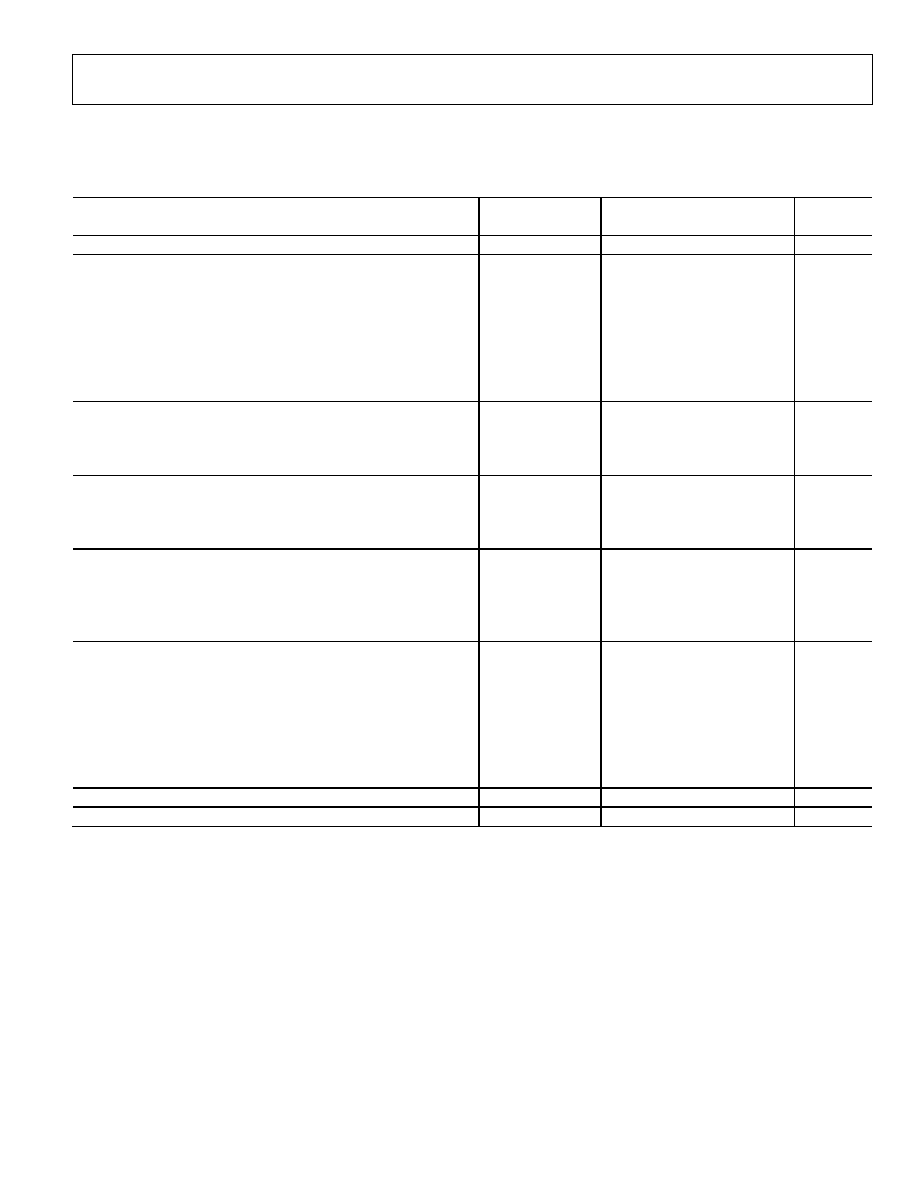
AD9259
Rev. 0 | Page 3 of 52
SPECIFICATIONS
AVDD = 1.8 V, DRVDD = 1.8 V, 2 V p-p differential input, 1.0 V internal reference, AIN = -0.5 dBFS, unless otherwise noted.
Table 1.
AD9259-50
Parameter
1
Temperature Min
Typ
Max
Unit
RESOLUTION
14
Bits
ACCURACY
No Missing Codes
Full
Guaranteed
Offset Error
Full
±1
±8
mV
Offset Matching
Full
±2
±8
mV
Gain Error
Full
±0.5
±2
% FS
Gain Matching
Full
±0.3
±0.7
% FS
Differential Nonlinearity (DNL)
Full
±0.5
±1.0
LSB
Integral Nonlinearity (INL)
Full
±1.5
±3.5
LSB
TEMPERATURE DRIFT
Offset Error
Full
±2
ppm/°C
Gain Error
Full
±17
ppm/°C
Reference Voltage (1 V Mode)
Full
±21
ppm/°C
REFERENCE
Output Voltage Error (VREF = 1 V)
Full
±5
±30
mV
Load Regulation @ 1.0 mA (VREF = 1 V)
Full
3
mV
Input Resistance
Full
6
k
ANALOG INPUTS
Differential Input Voltage Range (VREF = 1 V)
Full
2
V p-p
Common-Mode Voltage
Full
AVDD/2
V
Differential Input Capacitance
Full
7
pF
Analog Bandwidth, Full Power
Full
315
MHz
POWER SUPPLY
AVDD Full
1.7
1.8
1.9
V
DRVDD Full
1.7
1.8
1.9
V
IAVDD Full
185
192.5
mA
IDRVDD Full
32.5
34.7
mA
Total Power Dissipation (Including Output Drivers)
Full
392
409
mW
Power-Down Dissipation
Full
2
4
mW
Standby Dissipation
2
Full
72
mW
CROSSTALK Full
-100
dB
CROSSTALK (Overrange Condition)
3
Full
-100
dB
1
See the
AN-835 Application Note
, "Understanding High Speed ADC Testing and Evaluation," for a complete set of definitions and how these tests were completed.
2
Can be controlled via SPI.
3
Overrange condition is specific with 6 dB of the full-scale input range.

AD9259
Rev. 0 | Page 4 of 52
AC SPECIFICATIONS
AVDD = 1.8 V, DRVDD = 1.8 V, 2 V p-p differential input, 1.0 V internal reference, AIN = -0.5 dBFS, unless otherwise noted.
Table 2.
AD9259-50
Parameter
1
Temperature
Min
Typ
Max
Unit
SIGNAL-TO-NOISE RATIO (SNR)
f
IN
= 2.4 MHz
Full
73.5
dB
f
IN
= 19.7 MHz
Full
71.0
73.0
dB
f
IN
= 70 MHz
Full
72.8
dB
SIGNAL-TO-NOISE AND DISTORTION RATIO (SINAD)
f
IN
= 2.4 MHz
Full
72.7
dB
f
IN
= 19.7 MHz
Full
70.2
72.2
dB
f
IN
= 70 MHz
Full
72.0
dB
EFFECTIVE NUMBER OF BITS (ENOB)
f
IN
= 2.4 MHz
Full
12.0
Bits
f
IN
= 19.7 MHz
Full
11.6
11.9
Bits
f
IN
= 70 MHz
Full
11.9
Bits
SPURIOUS-FREE DYNAMIC RANGE (SFDR)
f
IN
= 2.4 MHz
Full
84
dBc
f
IN
= 19.7 MHz
Full
73
84
dBc
f
IN
= 70 MHz
Full
78
dBc
WORST HARMONIC (Second or Third)
f
IN
= 2.4 MHz
Full
-88
dBc
f
IN
= 19.7 MHz
Full
-84
-73
dBc
f
IN
= 70 MHz
Full
-78
dBc
WORST OTHER (Excluding Second or Third)
f
IN
= 2.4 MHz
Full
-90
dBc
f
IN
= 19.7 MHz
Full
-90
-80
dBc
f
IN
= 70 MHz
Full
-88
dBc
TWO-TONE INTERMODULATION DISTORTION (IMD)--
AIN1 AND AIN2 = -7.0 dBFS
f
IN1
= 15 MHz,
f
IN2
= 16 MHz
25°C
80.0
dBc
f
IN1
= 70 MHz,
f
IN2
= 71 MHz
25°C
80.0
dBc
1
See the
AN-835 Application Note
, "Understanding High Speed ADC Testing and Evaluation," for a complete set of definitions and how these tests were completed.

AD9259
Rev. 0 | Page 5 of 52
DIGITAL SPECIFICATIONS
AVDD = 1.8 V, DRVDD = 1.8 V, 2 V p-p differential input, 1.0 V internal reference, AIN = -0.5 dBFS, unless otherwise noted.
Table 3.
AD9259-50
Parameter
1
Temperature Min
Typ
Max
Unit
CLOCK INPUTS (CLK+, CLK-)
Logic Compliance
CMOS/LVDS/LVPECL
Differential Input Voltage
2
Full 250
mV
p-p
Input Common-Mode Voltage
Full
1.2
V
Input Resistance (Differential)
25°C
20
k
Input Capacitance
25°C
1.5
pF
LOGIC INPUTS (PDWN, SCLK/DTP)
Logic 1 Voltage
Full
1.2
3.6
V
Logic 0 Voltage
Full
0.3
V
Input Resistance
25°C
30
k
Input Capacitance
25°C
0.5
pF
LOGIC INPUT (CSB)
Logic 1 Voltage
Full
1.2
3.6
V
Logic 0 Voltage
Full
0.3
V
Input Resistance
25°C
70
k
Input Capacitance
25°C
0.5
pF
LOGIC INPUT (SDIO/ODM)
Logic 1 Voltage
Full
1.2
DRVDD + 0.3
V
Logic 0 Voltage
Full
0
0.3
V
Input Resistance
25°C
30
k
Input Capacitance
25°C
2
pF
LOGIC OUTPUT (SDIO/ODM)
Logic 1 Voltage (I
OH
= 50 A)
Full
1.79
V
Logic 0 Voltage (I
OL
= 50 A)
Full
0.05
V
DIGITAL OUTPUTS (D+, D-), (ANSI-644)
1
Logic Compliance
LVDS
Differential Output Voltage (V
OD
) Full
247
454
mV
Output Offset Voltage (V
OS
) Full
1.125
1.375
V
Output Coding (Default)
Offset binary
DIGITAL OUTPUTS (D+, D-),
(Low Power, Reduced Signal Option)
1
Logic Compliance
LVDS
Differential Output Voltage (V
OD
) Full
150
250
mV
Output Offset Voltage (V
OS
) Full
1.10
1.30
V
Output Coding (Default)
Offset binary
1
See the
AN-835 Application Note
, "Understanding High Speed ADC Testing and Evaluation," for a complete set of definitions and how these tests were completed.
2
This is specified for LVDS and LVPECL only.

AD9259
Rev. 0 | Page 6 of 52
SWITCHING SPECIFICATIONS
AVDD = 1.8 V, DRVDD = 1.8 V, 2 V p-p differential input, 1.0 V internal reference, AIN = -0.5 dBFS, unless otherwise noted.
Table 4.
AD9259-50
Parameter
1
Temp Min
Typ
Max
Unit
CLOCK
2
Maximum Clock Rate
Full
50
MSPS
Minimum Clock Rate
Full
10
MSPS
Clock Pulse Width High (t
EH
) Full
10
ns
Clock Pulse Width Low (t
EL
) Full
10
ns
OUTPUT PARAMETERS
2
Propagation Delay (t
PD
)
Full
2.0
2.7
3.5
ns
Rise Time (t
R
) (20% to 80%)
Full
300
ps
Fall Time (t
F
) (20% to 80%)
Full
300
ps
FCO Propagation Delay (t
FCO
)
Full
2.0
2.7
3.5
ns
DCO Propagation Delay (t
CPD
)
3
Full
t
FCO
+
(t
SAMPLE
/28)
ns
DCO to Data Delay (t
DATA
)
3
Full (t
SAMPLE
/28) - 300
(t
SAMPLE
/28) (t
SAMPLE
/28) + 300
ps
DCO to FCO Delay (t
FRAME
)
3
Full (t
SAMPLE
/28) - 300
(t
SAMPLE
/28) (t
SAMPLE
/28) + 300
ps
Data to Data Skew
(t
DATA-MAX
- t
DATA-MIN
)
Full
±50
±150
ps
Wake-Up Time (Standby)
25°C
600
ns
Wake-Up Time (Power Down)
25°C
375
s
Pipeline Latency
Full
10
CLK
cycles
APERTURE
Aperture Delay (t
A
)
25°C
500
ps
Aperture Uncertainty (Jitter)
25°C
<1
ps rms
Out-of-Range Recovery Time
25°C
2
CLK
cycles
1
See the
AN-835 Application Note
, "Understanding High Speed ADC Testing and Evaluation," for a complete set of definitions and how these tests were completed.
2
Can be adjusted via the SPI interface.
3
t
SAMPLE
/28 is based on the number of bits multiplied by 2; delays are based on half duty cycles.
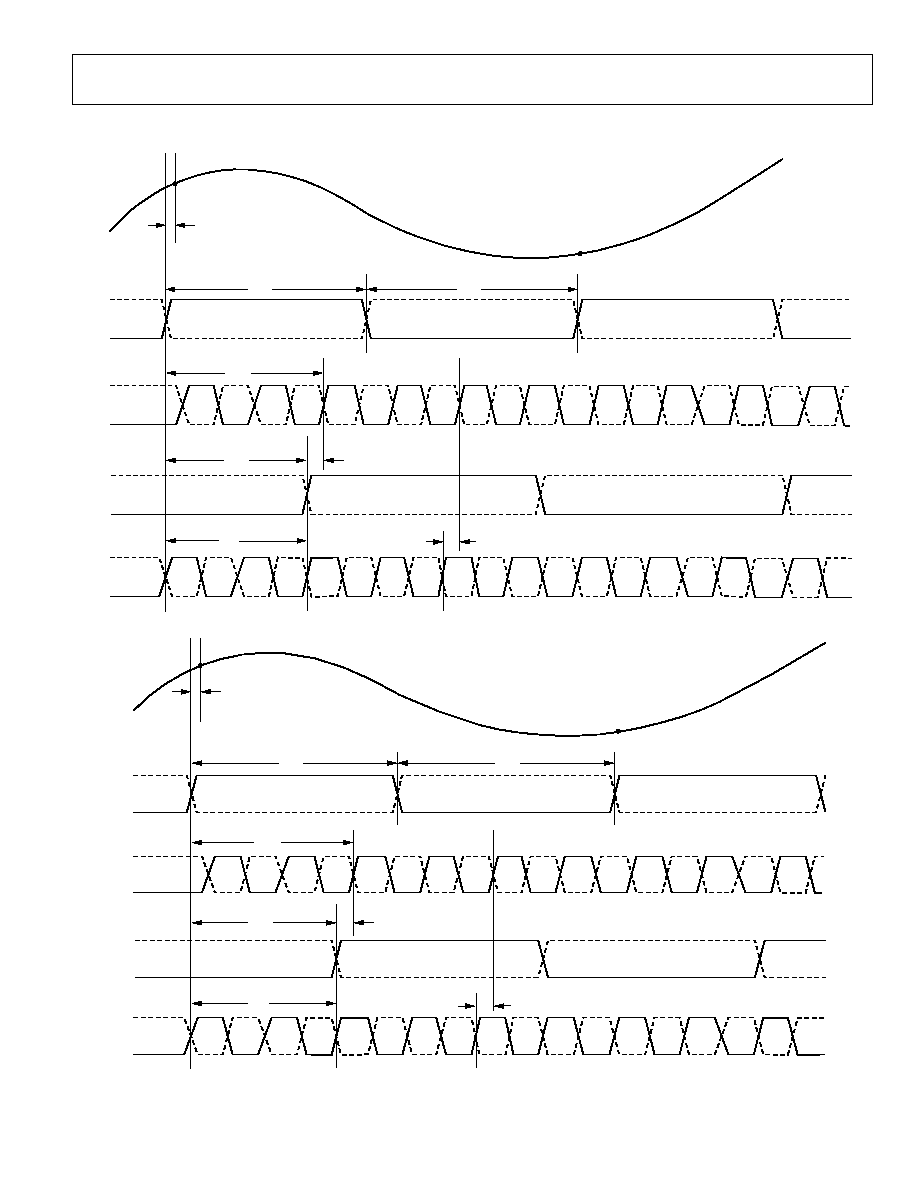
AD9259
Rev. 0 | Page 7 of 52
TIMING DIAGRAMS
DCO
DCO+
D
D+
FCO
FCO+
AIN
CLK
CLK+
MSB
N 10
D12
N 10
D11
N 10
D10
N 10
D9
N 10
D8
N 10
D7
N 10
D6
N 10
D5
N 10
D4
N 10
D3
N 10
D2
N 10
D0
N 10
D1
N 10
D12
N 9
MSB
N 9
N 1
t
A
N
t
DATA
t
FRAME
t
FCO
t
PD
t
CPD
t
EH
t
EL
05965-
039
Figure 2. 14-Bit Data Serial Stream (Default)
DCO
DCO+
D
D+
FCO
FCO+
AIN
CLK
CLK+
MSB
N 10
D10
N 10
D9
N 10
D8
N 10
D7
N 10
D6
N 10
D5
N 10
D4
N 10
D3
N 10
D2
N 10
D1
N 10
D0
N 10
D10
N 9
MSB
N 9
N 1
N
t
DATA
t
FRAME
t
FCO
t
PD
t
CPD
t
EH
t
A
t
EL
05
96
5-
04
0
Figure 3. 12-Bit Data Serial Stream

AD9259
Rev. 0 | Page 8 of 52
05
965-
041
DCO
DCO+
D
D+
FCO
FCO+
AIN
CLK
CLK+
LSB
N 10
D0
N 10
D1
N 10
D2
N 10
D3
N 10
D4
N 10
D5
N 10
D6
N 10
D7
N 10
D8
N 10
D9
N 10
D10
N 10
D11
N 10
D12
N 10
LSB
N 9
D0
N 9
N 1
t
A
N
t
DATA
t
FRAME
t
FCO
t
PD
t
CPD
t
EH
t
EL
Figure 4. 14-Bit Data Serial Stream, LSB First

AD9259
Rev. 0 | Page 9 of 52
ABSOLUTE MAXIMUM RATINGS
Table 5.
Parameter
With
Respect To
Rating
ELECTRICAL
AVDD
AGND
-0.3 V to +2.0 V
DRVDD
DRGND
-0.3 V to +2.0 V
AGND
DRGND
-0.3 V to +0.3 V
AVDD
DRVDD
-2.0 V to +2.0 V
Digital Outputs
(D+, D-, DCO+,
DCO-, FCO+, FCO-)
DRGND
-0.3 V to +2.0 V
CLK+, CLK-
AGND
-0.3 V to +3.9 V
VIN+, VIN-
AGND
-0.3 V to +2.0 V
SDIO/ODM
AGND
-0.3 V to +2.0 V
PDWN, SCLK/DTP, CSB
AGND
-0.3 V to +3.9 V
REFT, REFB, RBIAS
AGND
-0.3 V to +2.0 V
VREF, SENSE
AGND
-0.3 V to +2.0 V
ENVIRONMENTAL
Operating Temperature
Range (Ambient)
-40°C to +85°C
Maximum Junction
Temperature
150°C
Lead Temperature
(Soldering, 10 sec)
300°C
Storage Temperature
Range (Ambient)
-65°C to +150°C
Stresses above those listed under Absolute Maximum Ratings
may cause permanent damage to the device. This is a stress
rating only; functional operation of the device at these or any
other conditions above those indicated in the operational
section of this specification is not implied. Exposure to absolute
maximum rating conditions for extended periods may affect
device reliability.
THERMAL IMPEDANCE
Table 6.
Air Flow Velocity (m/s)
JA
1
JB
JC
0.0 24°C/W
1.0 21°C/W
12.6°C/W
1.2°C/W
2.5 19°C/W
1
JA
for a 4-layer PCB with solid ground plane (simulated). Exposed pad
soldered to PCB.
ESD CAUTION
ESD (electrostatic discharge) sensitive device. Electrostatic charges as high as 4000 V readily accumulate on
the human body and test equipment and can discharge without detection. Although this product features
proprietary ESD protection circuitry, permanent damage may occur on devices subjected to high energy
electrostatic discharges. Therefore, proper ESD precautions are recommended to avoid performance
degradation or loss of functionality.

AD9259
Rev. 0 | Page 10 of 52
PIN CONFIGURATION AND FUNCTION DESCRIPTIONS
VIN + A
VIN A
AVDD
VIN + D
VIN D
DRVDD
DRGND
CLK+
CLK
AVDD
DRVDD
DRGND
AVDD
AVDD
CSB
SCLK/DTP
SDIO/ODM
PDWN
AVDD
AVDD
AVDD
AVDD
AVDD
AVDD
D +
A
D
A
D +
B
D
B
D +
C
D
C
D +
D
D
D
DCO
+
DCO
FC
O
+
FC
O
VI
N
+
B
VI
N
B
VI
N
+
C
VI
N
C
AV
D
D
RE
F
T
RE
F
B
VR
E
F
SE
N
SE
AV
D
D
AV
D
D
RBI
AS
11
12
10
9
8
7
6
5
4
3
2
1
25
24
26
27
28
29
30
31
32
33
34
35
36
22
21
23
20
19
18
17
16
15
14
13
37
38
39
40
41
42
43
44
45
46
47
48
PIN 1
INDICATOR
EXPOSED PADDLE, PIN 0
(BOTTOM OF PACKAGE)
AD9259
TOP VIEW
05
96
5-
0
03
Figure 5. 48-Lead LFCSP Top View
Table 7. Pin Function Descriptions
Pin No.
Name
Description
0
AGND
Analog Ground (Exposed Paddle)
1, 2, 5, 6, 9, 10, 27, 32,
35, 36, 39, 45, 46
AVDD
1.8 V Analog Supply
11, 26
DRGND
Digital Output Driver Ground
12, 25
DRVDD
1.8 V Digital Output Driver Supply
3
VIN - D
ADC D Analog Input--Complement
4
VIN + D
ADC D Analog Input--True
7
CLK-
Input Clock--Complement
8
CLK+
Input Clock--True
13
D - D
ADC D Complement Digital Output
14
D + D
ADC D True Digital Output
15
D - C
ADC C Complement Digital Output
16
D + C
ADC C True Digital Output
17
D - B
ADC B Complement Digital Output
18
D + B
ADC B True Digital Output
19
D - A
ADC A Complement Digital Output
20
D + A
ADC A True Digital Output
21
FCO-
Frame Clock Output--Complement
22
FCO+
Frame Clock Output--True
23
DCO-
Data Clock Output--Complement
24
DCO+
Data Clock Output--True
28
SCLK/DTP
Serial Clock/Digital Test Pattern
29
SDIO/ODM
Serial Data Input-Output/Output Driver Mode
30
CSB CSB
31 PDWN
Power-Down
33
VIN + A
ADC A Analog Input--True
34
VIN - A
ADC A Analog Input--Complement

AD9259
Rev. 0 | Page 11 of 52
Pin No.
Name
Description
37
VIN - B
ADC B Analog Input--Complement
38
VIN + B
ADC B Analog Input--True
40
RBIAS
External Resistor Sets the Internal ADC Core Bias Current
41
SENSE
Reference Mode Selection
42
VREF
Voltage Reference Input/Output
43
REFB
Differential Reference (Negative)
44
REFT
Differential Reference (Positive)
47
VIN + C
ADC C Analog Input--True
48
VIN - C
ADC C Analog Input--Complement
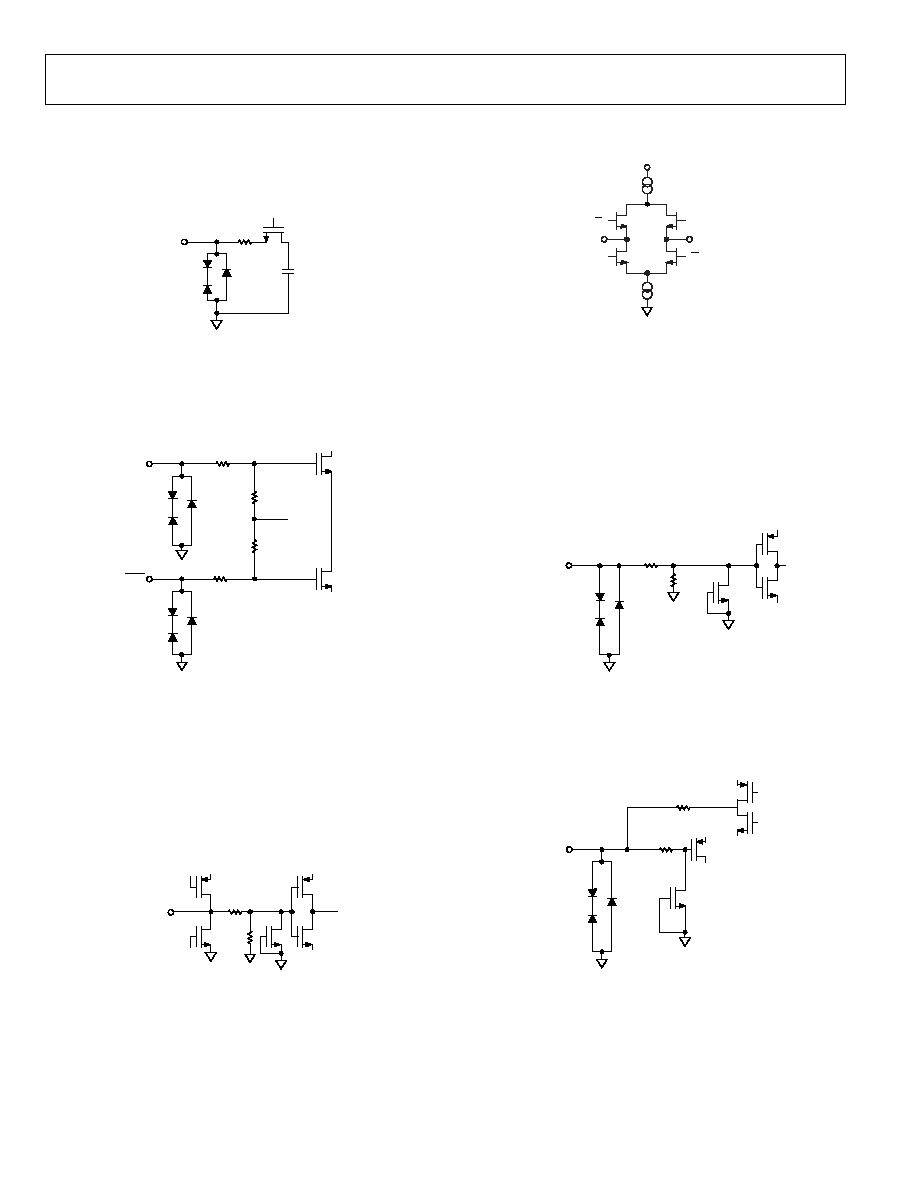
AD9259
Rev. 0 | Page 12 of 52
EQUIVALENT CIRCUITS
VIN
05
96
5-
0
30
Figure 6. Equivalent Analog Input Circuit
10
10k
10k
CLK
10
1.25V
CLK
059
65
-
0
32
Figure 7. Equivalent Clock Input Circuit
SDIO/ODM
350
30k
05
96
5
-
03
5
Figure 8. Equivalent SDIO/ODM Input Circuit
DRVDD
DRGND
D
D+
V
V
V
V
0
59
65
-
00
5
Figure 9. Equivalent Digital Output Circuit
SCLK/PDWN
30k
1k
05
96
5-
03
3
Figure 10. Equivalent SCLK/PDWN Input Circuit
100
RBIAS
05
96
5-
0
31
Figure 11. Equivalent RBIAS Circuit

AD9259
Rev. 0 | Page 13 of 52
CSB
70k
1k
AVDD
05
96
5-
0
3
4
VREF
6k
0
59
65-
0
37
Figure 12. Equivalent CSB Input Circuit
Figure 14. Equivalent VREF Circuit
SENSE
1k
05
965
-
0
36
Figure 13. Equivalent SENSE Circuit
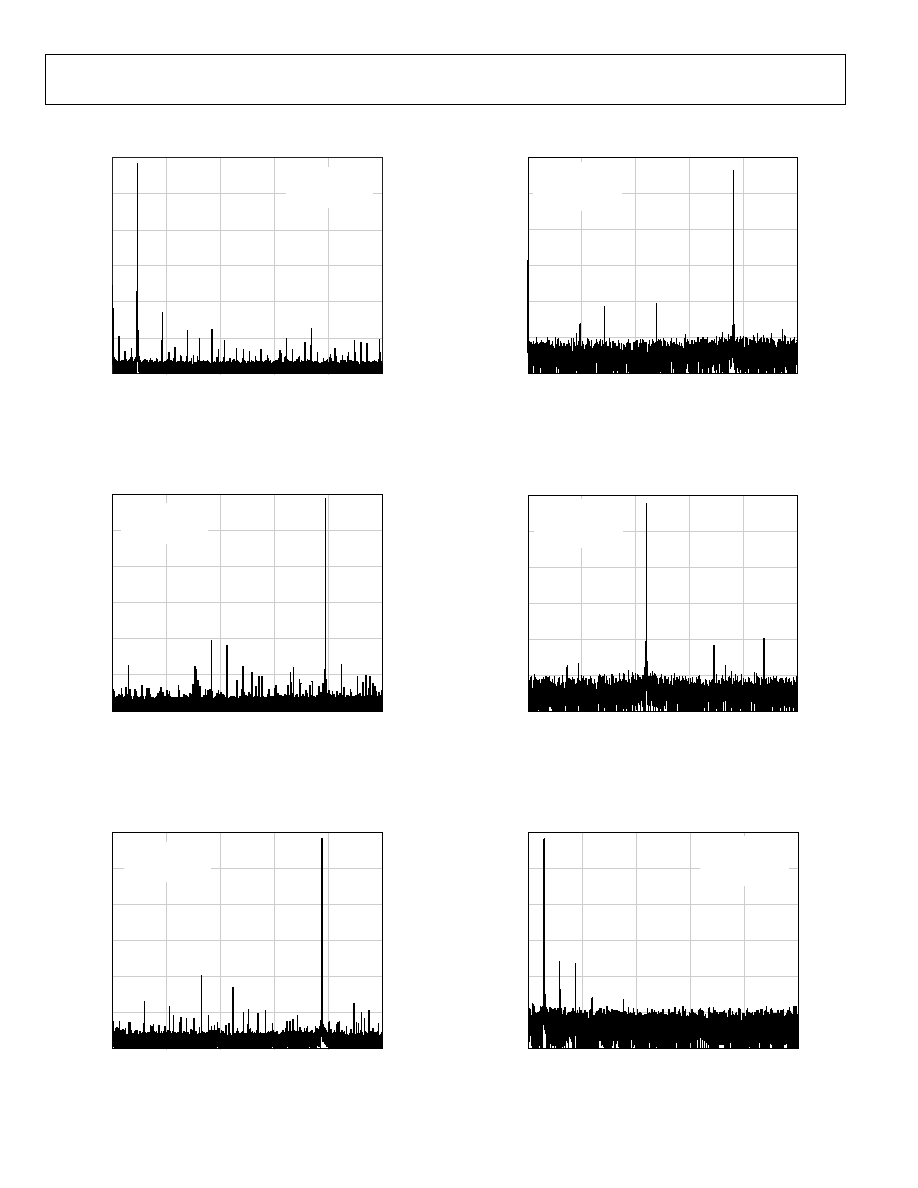
AD9259
Rev. 0 | Page 14 of 52
TYPICAL PERFORMANCE CHARACTERISTICS
0
10
5
15
20
0
120
80
100
60
20
40
AM
P
L
I
T
UDE
(
d
B
F
S
)
FREQUENCY (MHz)
25
AIN = 0.5dBFS
SNR = 73.8dB
ENOB = 11.88 BITS
SFDR = 83.4dBc
0
59
65
-
05
2
Figure 15. Single-Tone 32k FFT with f
IN
= 2.3 MHz, f
SAMPLE
= 50 MSPS
0
10
5
15
20
25
0
120
80
100
60
20
40
AM
P
L
I
T
UDE
(
d
BF
S
)
FREQUENCY (MHz)
AIN = 0.5dBFS
SNR = 72.94dB
ENOB = 11.57 BITS
SFDR = 78.60dBc
05
96
5-
08
5
Figure 16. Single-Tone 32k FFT with f
IN
= 70 MHz, f
SAMPLE
= 50 MSPS
0
10
5
15
20
25
0
120
80
100
60
20
40
AM
P
L
I
T
UDE
(
d
B
F
S
)
FREQUENCY (MHz)
AIN = 0.5dBFS
SNR = 71.96dB
ENOB = 11.41 BITS
SFDR = 76.68dBc
05
96
5-
05
3
Figure 17. Single-Tone 32k FFT with f
IN
= 120 MHz, f
SAMPLE
= 50 MSPS
AM
P
L
I
T
UDE
(
d
BF
S
)
120
0
20
40
60
80
100
0
5
10
15
20
25
FREQUENCY (MHz)
AIN = 0.5dBFS
SNR = 67.31dB
ENOB = 10.89 BITS
SFDR = 77.38dBc
0
59
65
-
0
54
Figure 18. Single-Tone 32k FFT with f
IN
= 170 MHz, f
SAMPLE
= 50 MSPS
AM
P
L
I
T
UD
E
(
d
BF
S
)
120
0
20
40
60
80
100
0
5
10
15
20
25
FREQUENCY (MHz)
AIN = 0.5dBFS
SNR = 66.87dB
ENOB = 10.82 BITS
SFDR = 74.97dBc
05
96
5-
05
1
Figure 19. Single-Tone 32k FFT with f
IN
= 190 MHz, f
SAMPLE
= 50 MSPS
AM
P
L
I
T
U
DE
(
d
BF
S
)
120
0
20
40
60
80
100
0
5
10
15
20
25
FREQUENCY (MHz)
AIN = 0.5dBFS
SNR = 65.62dB
ENOB = 10.61 BITS
SFDR = 68.11dBc
05
96
5-
0
50
Figure 20. Single-Tone 32k FFT with f
IN
= 250 MHz, f
SAMPLE
= 50 MSPS
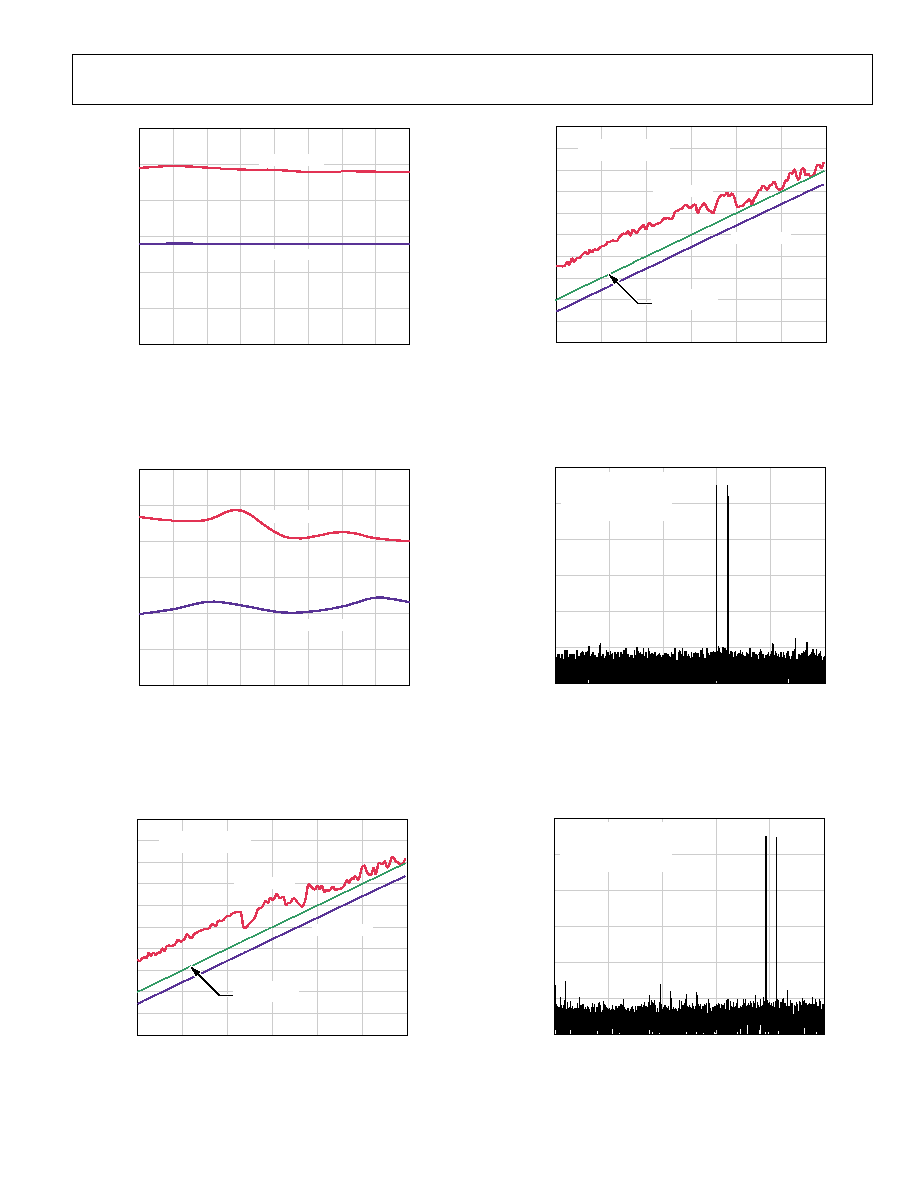
AD9259
Rev. 0 | Page 15 of 52
10
25
20
15
35
30
45
40
50
90
60
70
65
75
85
80
S
NR/
S
F
DR (
d
B)
ENCODE (MSPS)
2V p-p, SNR
2V p-p, SFDR
05
96
5-
0
59
Figure 21. SNR/SFDR vs. f
SAMPLE
, f
IN
= 10.3 MHz, f
SAMPLE
= 50 MSPS
10
25
20
15
35
30
45
40
50
90
60
70
65
75
85
80
S
N
R/
S
F
DR (
d
B)
ENCODE (MSPS)
2V p-p, SNR
2V p-p, SFDR
05
96
5-
06
0
Figure 22. SNR/SFDR vs. f
SAMPLE
, f
IN
= 35 MHz, f
SAMPLE
= 50 MSPS
S
NR/
S
F
DR (
d
B
)
ANALOG INPUT LEVEL (dBFS)
0
10
20
30
40
50
60
70
80
90
100
60
50
40
30
20
10
0
f
IN
= 10.3MHz
f
SAMPLE
= 50MSPS
2V p-p, SFDR
2V p-p, SNR
80dB
REFERENCE
05
96
5-
0
66
Figure 23. SNR/SFDR vs. Analog Input Level, f
IN
= 10.3 MHz, f
SAMPLE
= 50 MSPS
SN
R
/
S
F
D
R
(
d
B
)
ANALOG INPUT LEVEL (dBFS)
0
10
20
30
40
50
60
70
80
90
100
60
50
40
30
20
10
0
f
IN
= 35MHz
f
SAMPLE
= 50MSPS
2V p-p, SFDR
2V p-p, SNR
80dB
REFERENCE
05
96
5-
0
65
Figure 24. SNR/SFDR vs. Analog Input Level, f
IN
= 35 MHz, f
SAMPLE
= 50 MSPS
AM
P
L
I
T
UDE
(
d
BF
S
)
120
0
20
40
60
80
100
0
5
10
15
20
25
FREQUENCY (MHz)
AIN1 AND AIN2 = 7dBFS
SFDR = 87.76dBc
IMD2 = 90.18dBc
IMD3 = 87.27dBc
05
96
5-
05
6
Figure 25. Two-Tone 32k FFT with f
IN1
= 15 MHz and
f
IN2
= 16 MHz, f
SAMPLE
= 50 MSPS
AM
P
L
I
T
UD
E
(
d
B
F
S
)
120
0
20
40
60
80
100
0
5
10
15
20
25
FREQUENCY (MHz)
AIN1 AND AIN2 = 7dBFS
SFDR = 80.37dBc
IMD2 = 79.75dBc
IMD3 = 84.50dBc
05
96
5-
05
5
Figure 26. Two-Tone 32k FFT with f
IN1
= 70 MHz and
f
IN2
= 71 MHz, f
SAMPLE
= 50 MSPS
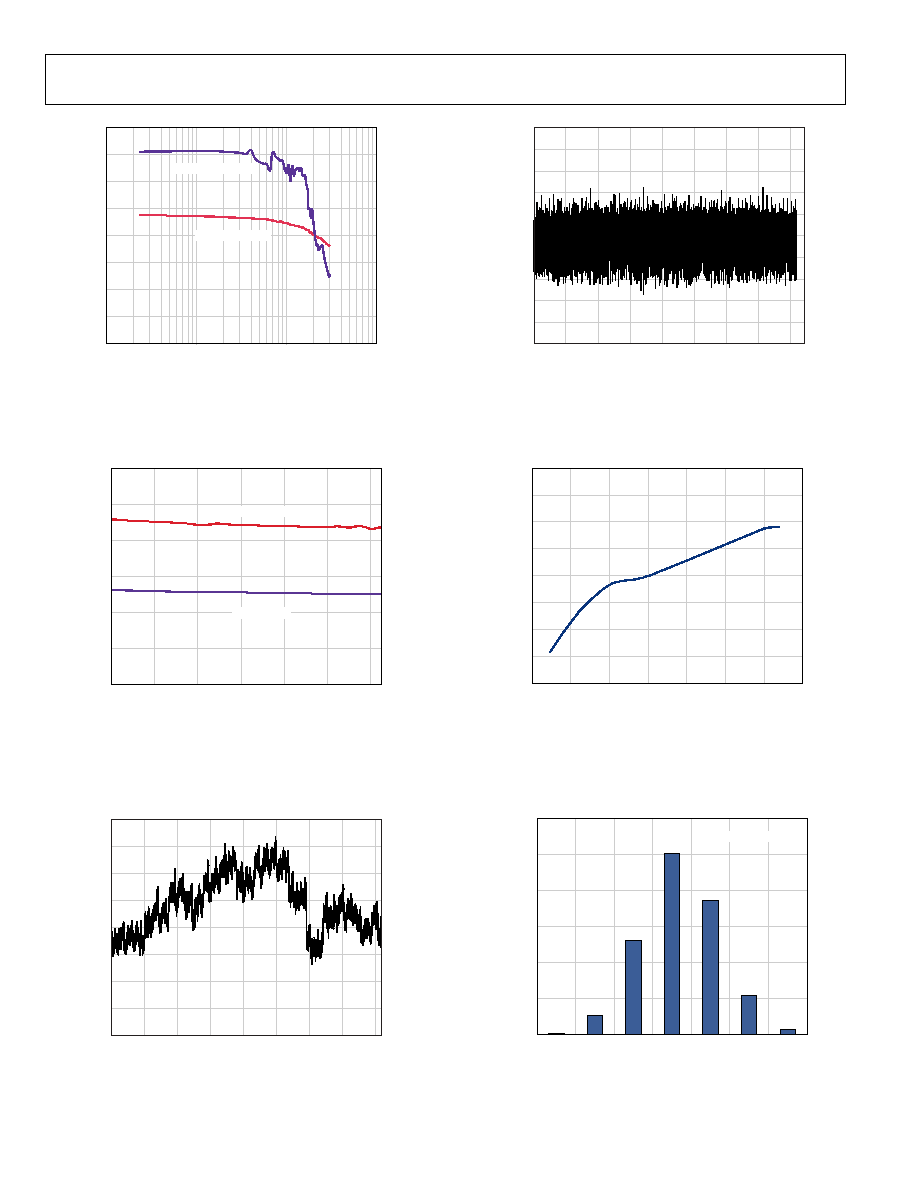
AD9259
Rev. 0 | Page 16 of 52
S
NR/
S
F
DR (
d
B
)
50
55
60
65
70
75
80
85
90
1
10
100
1000
ANALOG INPUT FREQUENCY (MHz)
2V p-p, SFDR (dBc)
2V p-p, SNR (dB)
05
96
5-
0
71
Figure 27. SNR/SFDR vs. f
IN
, f
SAMPLE
= 50 MSPS
S
I
N
AD/
S
F
DR (
d
B)
TEMPERATURE (°C)
40
20
80
60
40
20
0
60
65
70
75
80
85
90
2V p-p, SINAD
2V p-p, SFDR
0
59
65
-
0
72
Figure 28. SINAD/SFDR vs. Temperature, f
IN
= 10.3 MHz, f
SAMPLE
= 50 MSPS
0
2000
4000
6000
8000
10000 12000 14000 16000
2.0
2.0
1.5
1.0
0
0.5
0.5
1.0
1.5
IN
L
(
L
S
B
)
CODE
0
59
65
-
0
73
Figure 29. INL, f
IN
= 2.4 MHz, f
SAMPLE
= 50 MSPS
0
2000
4000
6000
8000 10000 12000 14000 16000
0.5
0.5
0.4
0.3
0.2
0.1
0
0.1
0.2
0.3
0.4
DN
L
(
L
S
B
)
CODE
05
965
-
07
4
Figure 30. DNL, f
IN
= 2.4 MHz, f
SAMPLE
= 50 MSPS
C
M
RR
(
d
B)
05
96
5-
0
75
70
30
35
40
45
50
55
60
65
0
5
10
15
20
30
25
35
FREQUENCY (MHz)
Figure 31. CMRR vs. Frequency, f
SAMPLE
= 50 MSPS
N
U
M
B
E
R
OF
H
I
TS
(
M
illio
ns
)
05
96
5-
0
86
0.2
0.4
0.6
0.8
1.0
1.2
0
N 3
N 2
N + 3
N + 2
N + 1
N
N 1
CODE
1.006 LSB rms
Figure 32. Input-Referred Noise Histogram, f
SAMPLE
= 50 MSPS
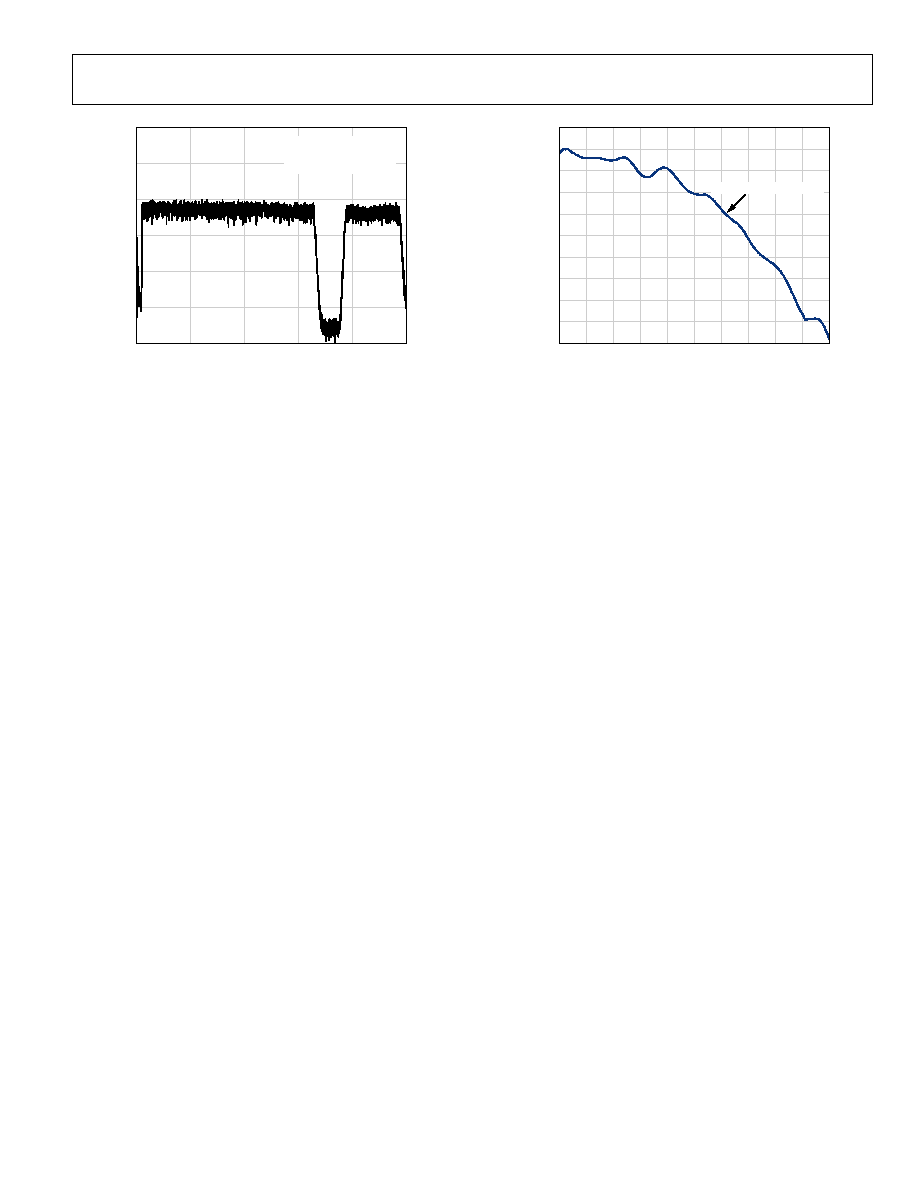
AD9259
Rev. 0 | Page 17 of 52
A
M
PL
I
T
U
D
E (d
B
F
S)
120
0
20
40
60
80
100
0
5
10
15
20
25
FREQUENCY (MHz)
NPR = 63.89dB
NOTCH = 18.0MHz
NOTCH WIDTH = 3.0MHz
0
59
65
-
07
6
Figure 33. Noise Power Ratio (NPR), f
SAMPLE
= 50 MSPS
F
U
N
D
A
M
EN
T
A
L
L
E
VEL
(d
B
)
05
96
5-
07
7
10
0
3
2
1
4
5
6
7
8
9
0
50
100
150
200
250
300
350
400
450
500
FREQUENCY (MHz)
3dB CUTOFF = 315MHz
Figure 34. Full Power Bandwidth vs. Frequency, f
SAMPLE
= 50 MSPS

AD9259
Rev. 0 | Page 18 of 52
THEORY OF OPERATION
The AD9259 architecture consists of a pipelined ADC that is
divided into three sections: a 4-bit first stage followed by eight
1.5-bit stages and a final 3-bit flash. Each stage provides
sufficient overlap to correct for flash errors in the preceding
stages. The quantized outputs from each stage are combined
into a final 14-bit result in the digital correction logic. The
pipelined architecture permits the first stage to operate on a
new input sample while the remaining stages operate on preceding
samples. Sampling occurs on the rising edge of the clock.
Each stage of the pipeline, excluding the last, consists of a low
resolution flash ADC connected to a switched-capacitor DAC
and interstage residue amplifier (MDAC). The residue amplifier
magnifies the difference between the reconstructed DAC output
and the flash input for the next stage in the pipeline. One bit of
redundancy is used in each stage to facilitate digital correction
of flash errors. The last stage simply consists of a flash ADC.
The output staging block aligns the data, carries out the error
correction, and passes the data to the output buffers. The data is
then serialized and aligned to the frame and output clock.
ANALOG INPUT CONSIDERATIONS
The analog input to the AD9259 is a differential switched-capacitor
circuit designed for processing differential input signals. The input
can support a wide common-mode range and maintain excellent
performance. An input common-mode voltage of midsupply
minimizes signal-dependent errors and provides optimum
performance.
S
S
H
C
PAR
C
SAMPLE
C
SAMPLE
C
PAR
VIN
H
S
S
H
VIN+
H
0
59
65
-
00
6
Figure 35. Switched-Capacitor Input Circuit
The clock signal alternately switches the input circuit between
sample mode and hold mode (see Figure 35). When the input
circuit is switched into sample mode, the signal source must be
capable of charging the sample capacitors and settling within
one-half of a clock cycle. A small resistor in series with each
input can help reduce the peak transient current injected from
the output stage of the driving source. In addition, low-Q inductors
or ferrite beads can be placed on each leg of the input to reduce
the high differential capacitance seen at the analog inputs, thus
realizing the maximum bandwidth of the ADC. Such use of
low-Q inductors or ferrite beads is required when driving the
converter front end at high IF frequencies. Either a shunt capacitor
or two single-ended capacitors can be placed on the inputs to
provide a matching passive network. This ultimately creates a
low-pass filter at the input to limit any unwanted broadband
noise. See the
AN-742 Application Note
, the
AN-827 Application
Note
, and the Analog Dialogue article "
Transformer-Coupled
Front-End for Wideband A/D Converters
" for more information
on this subject. In general, the precise values depend on the
application.
The analog inputs of the AD9259 are not internally dc-biased.
In ac-coupled applications, the user must provide this bias
externally. Setting the device so that V
CM
= AVDD/2 is recom-
mended for optimum performance, but the device can function
over a wider range with reasonable performance, as shown in
Figure 36 and Figure 37.
S
NR/
S
F
DR (
d
B)
ANALOG INPUT COMMON-MODE VOLTAGE (V)
50
55
60
65
70
75
80
85
90
0.2
0.4
0.6
0.8
1.0
1.2
1.4
1.6
SFDR (dBc)
SNR (dB)
05
96
5-
07
8
f
IN
= 2.3MHz
f
SAMPLE
= 50MSPS
Figure 36. SNR/SFDR vs. Common-Mode Voltage,
f
IN
= 2.3 MHz, f
SAMPLE
= 50 MSPS
S
N
R/
S
F
DR (
d
B
)
ANALOG INPUT COMMON-MODE VOLTAGE (V)
50
55
60
65
70
75
80
85
90
0.2
0.4
0.6
0.8
1.0
1.2
1.4
1.6
SFDR (dBc)
SNR (dB)
0
59
65
-
0
79
f
IN
= 30MHz
f
SAMPLE
= 50MSPS
Figure 37. SNR/SFDR vs. Common-Mode Voltage,
f
IN
= 30 MHz, f
SAMPLE
= 50 MSPS
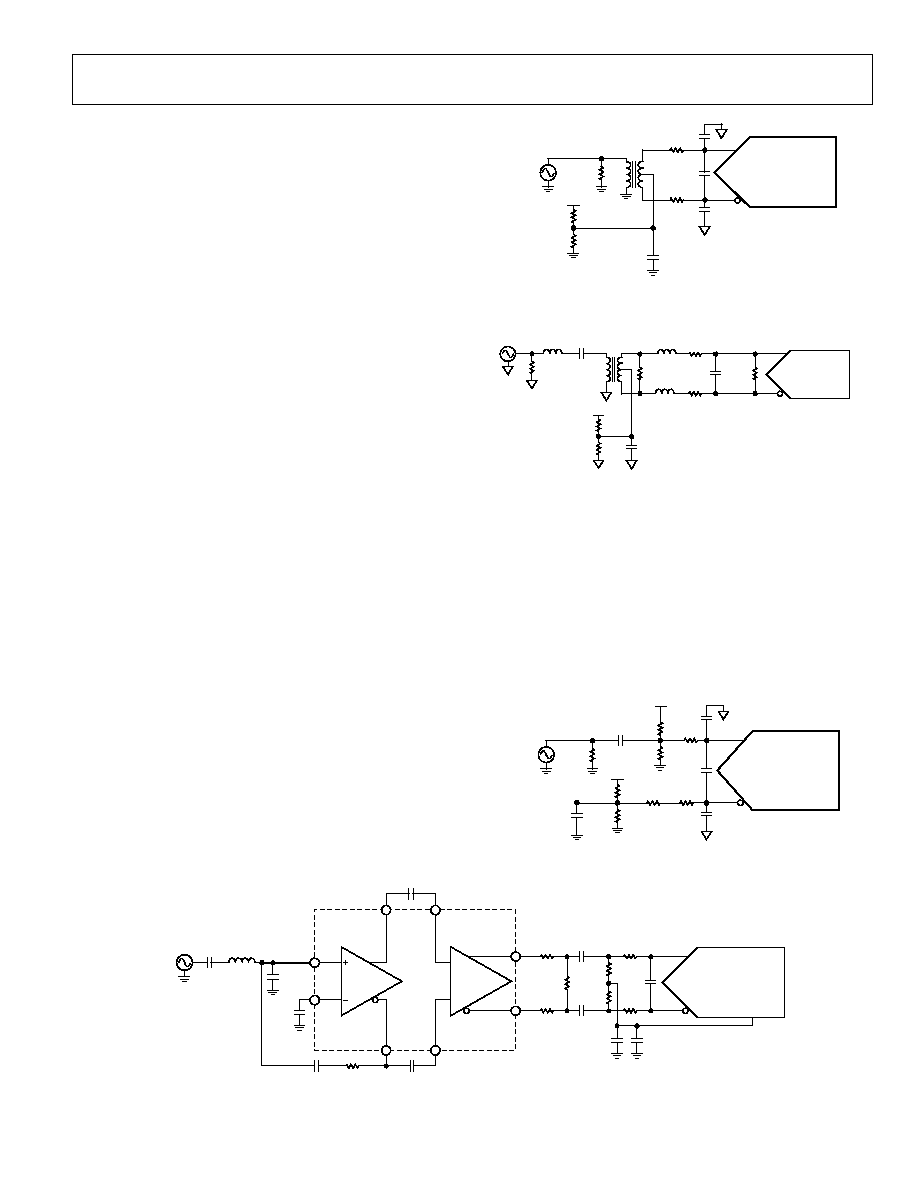
AD9259
Rev. 0 | Page 19 of 52
For best dynamic performance, the source impedances driving
VIN+ and VIN- should be matched such that common-mode
settling errors are symmetrical. These errors are reduced by the
common-mode rejection of the ADC. An internal reference
buffer creates the positive and negative reference voltages, REFT
and REFB, respectively, that define the span of the ADC core.
The output common-mode of the reference buffer is set to
midsupply, and the REFT and REFB voltages and span are
defined as
REFT = 1/2 (AVDD + VREF)
REFB = 1/2 (AVDD - VREF)
Span = 2 × (REFT - REFB) = 2 × VREF
It can be seen from these equations that the REFT and REFB
voltages are symmetrical about the midsupply voltage and, by
definition, the input span is twice the value of the VREF voltage.
Maximum SNR performance is always achieved by setting the
ADC to the largest span in a differential configuration. In the
case of the AD9259, the largest input span available is 2 V p-p.
Differential Input Configurations
There are several ways in which to drive the AD9259 either
actively or passively. In either case, the optimum performance is
achieved by driving the analog input differentially. One example
is by using the
AD8332
differential driver. It provides excellent
performance and a flexible interface to the ADC (see Figure 41)
for baseband applications. This configuration is common for
medical ultrasound systems.
However, the noise performance of most amplifiers is not
adequate to achieve the true performance of the AD9259. For
applications where SNR is a key parameter, differential transfor-
mer coupling is the recommended input configuration. Two
examples are shown in Figure 38 and Figure 39.
In any configuration, the value of the shunt capacitor, C, is
dependent on the input frequency and may need to be reduced
or removed.
2V p-p
R
R
1
C
DIFF
C
1
C
DIFF
IS OPTIONAL.
49.9
0.1F
1k
1k
AGND
AVDD
ADT11WT
1:1 Z RATIO
VIN
ADC
AD9259
VIN+
C
05
96
5-
0
08
Figure 38. Differential Transformer Coupled Configuration
for Baseband Applications
ADC
AD9259
2V p-p
2.2pF
1k
0.1F
1k
1k
AVDD
ADT11WT
1:1 Z RATIO
16nH
16nH
0.1F
16nH
33
33
499
65
VIN+
VIN
059
65
-
04
7
Figure 39. Differential Transformer Coupled Configuration for IF Applications
Single-Ended Input Configuration
A single-ended input may provide adequate performance in
cost-sensitive applications. In this configuration, SFDR and
distortion performance degrade due to the large input common-
mode swing. If the application requires a single-ended input
configuration, ensure that the source impedances on each input
are well matched in order to achieve the best possible performance.
A full-scale input of 2 V p-p can still be applied to the ADC's VIN+
pin while the VIN- pin is terminated. Figure 40 details a typical
single-ended input configuration.
2V p-p
R
R
49.9
0.1µF
0.1µF
AVDD
1k 25
1k
1k
AVDD
VIN
ADC
AD9259
VIN+
1
C
DIFF
C
C
05
96
5-
0
09
1
C
DIFF
IS OPTIONAL.
Figure 40. Single-Ended Input Configuration
AD8332
1.0k
1.0k
374
187
R
R
C
0.1F
187
0.1F
0.1F
0.1F
0.1F
10F
0.1F
1V p-p
0.1F
LNA
120nH
VGA
VOH
VIP
INH
22pF
LMD
VIN
LOP
LON
VOL
18nF
274
VIN
ADC
AD9259
VIN+
VREF
05
96
5-
0
07
Figure 41. Differential Input Configuration Using the
AD8332

AD9259
Rev. 0 | Page 20 of 52
CLOCK INPUT CONSIDERATIONS
For optimum performance, the AD9259 sample clock inputs
(CLK+ and CLK-) should be clocked with a differential signal.
This signal is typically ac-coupled into the CLK+ and CLK- pins
via a transformer or capacitors. These pins are biased internally
and require no additional bias.
Figure 42 shows one preferred method for clocking the AD9259.
The low jitter clock source is converted from single-ended to
differential using an RF transformer. The back-to-back Schottky
diodes across the secondary transformer limit clock excursions
into the AD9259 to approximately 0.8 V p-p differential. This
helps prevent the large voltage swings of the clock from feeding
through to other portions of the AD9259 and preserves the fast
rise and fall times of the signal, which are critical to low jitter
performance.
0.1µF
0.1µF
0.1µF
0.1µF
SCHOTTKY
DIODES:
HSM2812
CLOCK
INPUT
50
100
CLK
CLK+
ADC
AD9259
MIN-CIRCUITS
ADT11WT, 1:1Z
XFMR
05
96
5-
02
4
Figure 42. Transformer Coupled Differential Clock
If a low jitter clock is available, another option is to ac-couple a
differential PECL signal to the sample clock input pins as shown
in Figure 43. The
AD9510
/
AD9511
/
AD9512
/
AD9513
/
AD9514
/
AD9515
family of clock drivers offers excellent jitter performance.
CLOCK
INPUT
100
0.1µF
0.1µF
0.1µF
0.1µF
240
240
CLOCK
INPUT
50
1
50
1
CLK
CLK
1
50
RESISTORS ARE OPTIONAL.
CLK
CLK+
ADC
AD9259
05965
-
025
AD9510/AD9511/
AD9512/AD9513/
AD9514/AD9515
PECL DRIVER
Figure 43. Differential PECL Sample Clock
CLOCK
INPUT
100
0.1µF
0.1µF
0.1µF
0.1µF
50*
CLOCK
INPUT
LVDS DRIVER
50
1
CLK
CLK
1
50 RESISTORS ARE OPTIONAL
CLK
CLK+
ADC
AD9259
0596
5-
026
AD9510/AD9511/
AD9512/AD9513/
AD9514/AD9515
Figure 44. Differential LVDS Sample Clock
In some applications, it is acceptable to drive the sample clock
inputs with a single-ended CMOS signal. In such applications,
CLK+ should be directly driven from a CMOS gate, and the
CLK- pin should be bypassed to ground with a 0.1 F capacitor
in parallel with a 39 k resistor (see Figure 45). Although the
CLK+ input circuit supply is AVDD (1.8 V), this input is
designed to withstand input voltages up to 3.3 V, making the
selection of the drive logic voltage very flexible.
CLOCK
INPUT
0.1µF
0.1µF
0.1µF
39
k
CMOS DRIVER
50
1
OPTIONAL
100
0.1µF
CLK
CLK
1
50
RESISTOR IS OPTIONAL.
CLK
CLK+
ADC
AD9259
059
65-
0
27
AD9510/AD9511/
AD9512/AD9513/
AD9514/AD9515
Figure 45. Single-Ended 1.8 V CMOS Sample Clock
CLOCK
INPUT
0.1µF
0.1µF
0.1µF
AD9510/AD9511/
AD9512/AD9513/
AD9514/AD9515
CMOS DRIVER
50
1
OPTIONAL
100
CLK
CLK
1
50
RESISTOR IS OPTIONAL.
0.1µF
CLK
CLK+
ADC
AD9259
059
65
-
0
28
Figure 46. Single-Ended 3.3 V CMOS Sample Clock
Clock Duty Cycle Considerations
Typical high speed ADCs use both clock edges to generate a
variety of internal timing signals. As a result, these ADCs may
be sensitive to clock duty cycle. Commonly, a 5% tolerance is
required on the clock duty cycle to maintain dynamic performance
characteristics. The AD9259 contains a duty cycle stabilizer (DCS)
that retimes the nonsampling edge, providing an internal clock
signal with a nominal 50% duty cycle. This allows a wide range
of clock input duty cycles without affecting the performance of
the AD9259. When the DCS is on, noise and distortion perfor-
mance are nearly flat for a wide range of duty cycles. However,
some applications may require the DCS function to be off. If so,
keep in mind that the dynamic range performance can be affected
when operated in this mode. See the Memory Map section for
more details on using this feature.
The duty cycle stabilizer uses a delay-locked loop (DLL) to
create the nonsampling edge. As a result, any changes to the
sampling frequency require approximately 10 clock cycles
to allow the DLL to acquire and lock to the new rate.

AD9259
Rev. 0 | Page 21 of 52
Clock Jitter Considerations
High speed, high resolution ADCs are sensitive to the quality of the
clock input. The degradation in SNR at a given input frequency
(f
A
) due only to aperture jitter (t
J
) can be calculated by
SNR degradation = 20 × log 10 [1/2 × × f
A
× t
J
]
In this equation, the rms aperture jitter represents the root mean
square of all jitter sources, including the clock input, analog input
signal, and ADC aperture jitter specifications. IF undersampling
applications are particularly sensitive to jitter (see Figure 47).
The clock input should be treated as an analog signal in cases
where aperture jitter may affect the dynamic range of the AD9259.
Power supplies for clock drivers should be separated from the
ADC output driver supplies to avoid modulating the clock signal
with digital noise. Low jitter, crystal-controlled oscillators make
the best clock sources. If the clock is generated from another
type of source (by gating, dividing, or other methods), it should
be retimed by the original clock at the last step.
Refer to the
AN-501 Application Note
and the
AN-756
Application Note
for more in-depth information about jitter
performance as it relates to ADCs (visit
www.analog.com
).
1
10
100
1000
16 BITS
14 BITS
12 BITS
30
40
50
60
70
80
90
100
110
120
130
0.125ps
0.25ps
0.5ps
1.0ps
2.0ps
ANALOG INPUT FREQUENCY (MHz)
10 BITS
RMS CLOCK JITTER REQUIREMENT
S
NR (
d
B
)
059
65
-
03
8
Figure 47. Ideal SNR vs. Input Frequency and Jitter
Power Dissipation and Power-Down Mode
As shown in Figure 48, the power dissipated by the AD9259 is
proportional to its sample rate. The digital power dissipation
does not vary much because it is determined primarily by the
DRVDD supply and bias current of the LVDS output drivers.
10
20
15
30
35
25
50
40
45
CURR
E
NT
(
m
A)
ENCODE (MSPS)
250
300
350
450
500
400
0
20
40
100
140
120
200
180
160
60
80
PO
W
E
R
(mW
)
DRVDD CURRENT
TOTAL POWER
AVDD CURRENT
0
59
65
-
0
89
Figure 48. Supply Current vs. f
SAMPLE
for f
IN
= 10.3 MHz, f
SAMPLE
= 50 MSPS

AD9259
Rev. 0 | Page 22 of 52
By asserting the PDWN pin high, the AD9259 is placed in
power-down mode. In this state, the ADC typically dissipates
2 mW. During power-down, the LVDS output drivers are placed in
a high impedance state. The AD9259 returns to normal operating
mode when the PDWN pin is pulled low. This pin is both 1.8 V
and 3.3 V tolerant.
In power-down mode, low power dissipation is achieved by
shutting down the reference, reference buffer, PLL, and biasing
networks. The decoupling capacitors on REFT and REFB are
discharged when entering power-down mode and must be
recharged when returning to normal operation. As a result, the
wake-up time is related to the time spent in the power-down
mode; shorter cycles result in proportionally shorter wake-up
times. With the recommended 0.1 F and 2.2 F decoupling
capacitors on REFT and REFB, it takes approximately 1 sec to
fully discharge the reference buffer decoupling capacitors and
375 s to restore full operation.
There are a number of other power-down options available
when using the SPI port interface. The user can individually
power down each channel or put the entire device into standby
mode. This allows the user to keep the internal PLL powered
when fast wake-up times (~600 ns) are required. See the
Memory Map section for more details on using these features.
Digital Outputs and Timing
The AD9259 differential outputs conform to the ANSI-644 LVDS
standard on default power-up. This can be changed to a low power,
reduced signal option similar to the IEEE 1596.3 standard using
the SDIO/ODM pin or via the SPI. This LVDS standard can further
reduce the overall power dissipation of the device by approximately
17 mW. See the SDIO/ODM Pin section or Table 15 in the
Memory Map section for more information. The LVDS driver
current is derived on-chip and sets the output current at each
output equal
to a nominal 3.5 mA. A 100 differential termination resistor
placed at the LVDS receiver inputs results in a nominal 350 mV
swing at the receiver.
The AD9259 LVDS outputs facilitate interfacing with LVDS
receivers in custom ASICs and FPGAs that have LVDS capability
for superior switching performance in noisy environments.
Single point-to-point net topologies are recommended with a
100 termination resistor placed as close to the receiver as
possible. No far-end receiver termination and poor differential
trace routing may result in timing errors. It is recommended
that the trace length is no longer than 24 inches and that the
differential output traces are kept close together and at equal
lengths. An example of the FCO and data stream with proper
trace length and position can be found in Figure 49.
CH1 500mV/DIV = DCO
CH2 500mV/DIV = DATA
CH3 500mV/DIV = FCO
2.5ns/DIV
0
596
5-
0
45
Figure 49. LVDS Output Timing Example in ANSI Mode (Default)
An example of the LVDS output using the ANSI standard (default)
data eye and a time interval error (TIE) jitter histogram with
trace lengths less than 24 inches on regular FR-4 material is
shown in Figure 50. Figure 51 shows an example of when the
trace lengths exceed 24 inches on regular FR-4 material. Notice
that the TIE jitter histogram reflects the decrease of the data eye
opening as the edge deviates from the ideal position. It is up to
the user to determine if the waveforms meet the timing budget
of the design when the trace lengths exceed 24 inches. Additional
SPI options allow the user to further increase the internal ter-
mination (increasing the current) of all four outputs in order to
drive longer trace lengths (see Figure 52). Even though this
produces sharper rise and fall times on the data edges and is less
prone to bit errors, the power dissipation of the DRVDD supply
increases when this option is used. Also notice in Figure 52 that
the histogram has improved. See the Memory Map section for
more details.
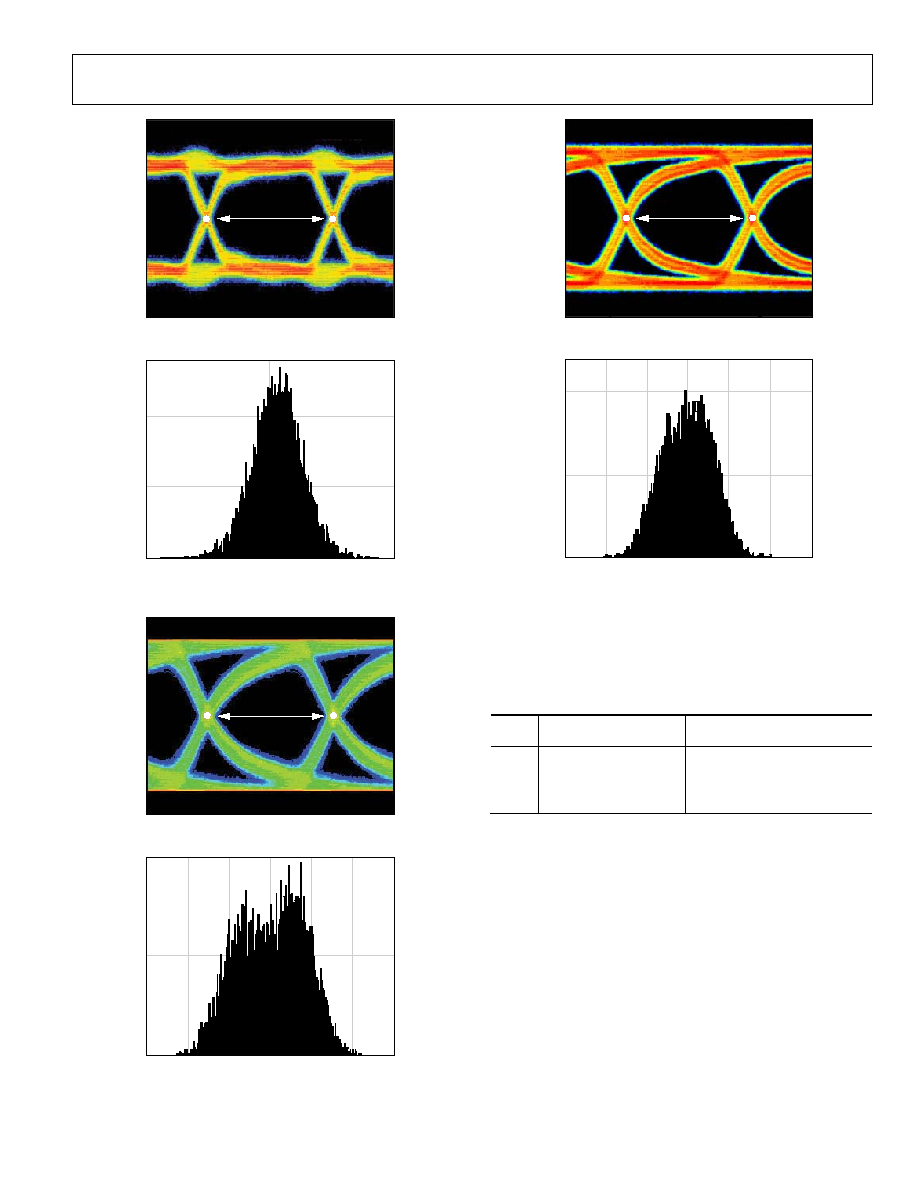
AD9259
Rev. 0 | Page 23 of 52
100
50
0
100ps
0ps
100ps
T
I
E J
I
T
T
ER
HI
S
T
O
G
R
AM (
H
i
t
s
)
500
500
0
1.0ns
0.5ns
0ns
0.5ns
1.0ns
E
Y
E
DI
AG
RAM
V
O
L
T
AG
E
(
V
)
EYE: ALL BITS
ULS: 10000/15600
0
5
965
-
04
3
0
Figure 50. Data Eye for LVDS Outputs in ANSI Mode with Trace Lengths Less
than 24 Inches on Standard FR-4
200
200
0
1.0ns
0.5ns
0ns
0.5ns
1.0ns
E
Y
E
D
I
AG
RAM
V
O
L
T
AG
E
(
V
)
EYE: ALL BITS
ULS: 9600/15600
100
50
0
150ps 100ps
50ps
0ps
50ps
100ps
150ps
T
I
E J
I
T
T
ER
HI
S
T
O
G
R
AM (
H
i
t
s
)
05
96
5-
04
4
Figure 51. Data Eye for LVDS Outputs in ANSI Mode with Trace Lengths
Greater than 24 Inches on Standard FR-4
100
50
0
150ps 100ps
50ps
0ps
50ps
100ps
150ps
T
I
E
JI
T
T
E
R
HI
S
T
O
G
RAM
(
H
i
t
s)
200
400
200
400
0
1.0ns
0.5ns
0ns
0.5ns
1.0ns
E
Y
E
DI
AG
RA
M
V
O
L
T
AG
E
(
V
)
EYE: ALL BITS
ULS: 9599/15599
05
96
5-04
2
Figure 52. Data Eye for LVDS Outputs in ANSI Mode with 100 Termination
on and Trace Lengths Greater than 24 Inches on Standard FR-4
The format of the output data is offset binary by default. An
example of the output coding format can be found in Table 8.
If it is desired to change the output data format to twos
complement, see the Memory Map section.
Table 8. Digital Output Coding
Code
(VIN+) - (VIN-), Input
Span = 2 V p-p (V)
Digital Output Offset Binary
(D11 ... D0)
16383
+1.00
11 1111 1111 1111
8192
0.00
10 0000 0000 0000
8191
-0.000122
01 1111 1111 1111
0
-1.00
00 0000 0000 0000
Data from each ADC is serialized and provided on a separate
channel. The data rate for each serial stream is equal to 14 bits
times the sample clock rate, with a maximum of 700 Mbps
(14 bits × 50 MSPS = 700 Mbps). The lowest typical conversion
rate is 10 MSPS. However, if lower sample rates are required for
a specific application, the PLL can be set up for encode rates
lower than 10 MSPS via the SPI. This allows encode rates as low
as 5 MSPS. See the Memory Map section to enable this feature.
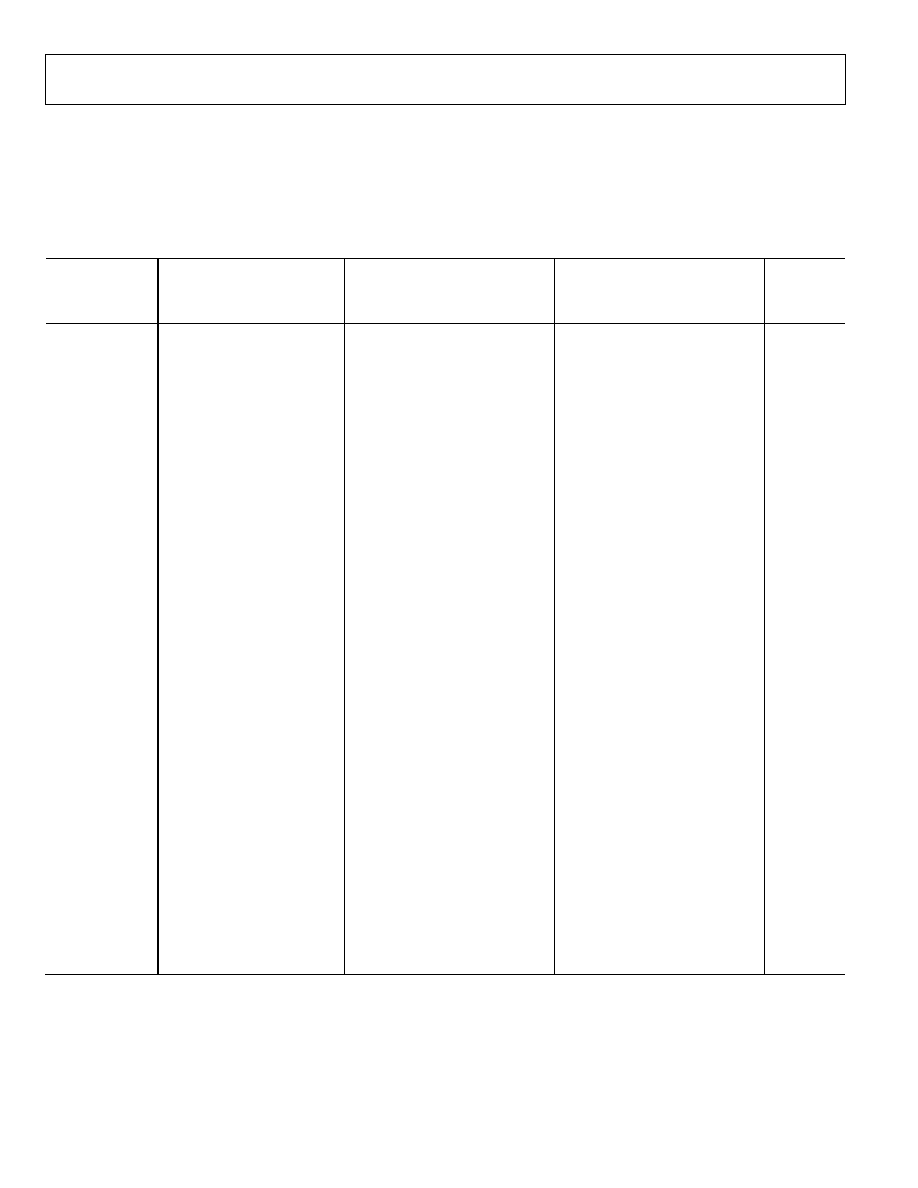
AD9259
Rev. 0 | Page 24 of 52
Two output clocks are provided to assist in capturing data from
the AD9259. The DCO is used to clock the output data and is
equal to seven times the sampling clock (CLK) rate. Data is
clocked out of the AD9259 and must be captured on the rising
and falling edges of the DCO that supports double data rate
(DDR) capturing. The frame clock out (FCO) is used to signal
the start of a new output byte and is equal to the sampling clock
rate. See the timing diagram shown in Figure 2 for more
information.
Table 9. Flex Output Test Modes
Output Test
Mode Bit
Sequence
Pattern Name
Digital Output Word 1
Digital Output Word 2
Subject
to Data
Format
Select
0000
Off
(default)
N/A N/A N/A
0001 Midscale
short
1000 0000 (8-bit)
10 0000 0000 (10-bit)
1000 0000 0000 (12-bit)
10 0000 0000 0000 (14-bit)
Same Yes
0010 +Full-scale
short 1111 1111 (8-bit)
11 1111 1111 (10-bit)
1111 1111 1111 (12-bit)
11 1111 1111 1111 (14-bit)
Same Yes
0011 -Full-scale
short 0000 0000 (8-bit)
00 0000 0000 (10-bit)
0000 0000 0000 (12-bit)
00 0000 0000 0000 (14-bit)
Same Yes
0100 Checker
board
1010 1010 (8-bit)
10 1010 1010 (10-bit)
1010 1010 1010 (12-bit)
10 1010 1010 1010 (14-bit)
0101 0101 (8-bit)
01 0101 0101 (10-bit)
0101 0101 0101 (12-bit)
01 0101 0101 0101 (14-bit)
No
0101
PN sequence long
1
N/A N/A Yes
0110
PN sequence short
1
N/A N/A Yes
0111 One/zero
word
toggle
1111 1111 (8-bit)
11 1111 1111 (10-bit)
1111 1111 1111 (12-bit)
11 1111 1111 1111 (14-bit)
0000 0000 (8-bit)
00 0000 0000 (10-bit)
0000 0000 0000 (12-bit)
00 0000 0000 0000 (14-bit)
No
1000
User input
Register 0x19 to Register 0x1A
Register 0x1B to Register 0x1C
No
1001
One/zero bit toggle
1010 1010 (8-bit)
10 1010 1010 (10-bit)
1010 1010 1010 (12-bit)
10 1010 1010 1010 (14-bit)
N/A No
1010 1×
sync
0000 1111 (8-bit)
00 0001 1111 (10-bit)
0000 0011 1111 (12-bit)
00 0000 0111 1111 (14-bit)
N/A No
1011
One bit high
1000 0000 (8-bit)
10 0000 0000 (10-bit)
1000 0000 0000 (12-bit)
10 0000 0000 0000 (14-bit)
N/A No
1100 Mixed
frequency 1010 0011 (8-bit)
10 0110 0011 (10-bit)
1010 0011 0011 (12-bit)
10 1000 0110 0111 (14-bit)
N/A No
1
PN, or pseudorandom number, sequence is determined by the number of bits in the shift register. The long sequence is 23 bits and the short sequence is
9 bits. How the sequence is generated and utilized is described in the ITU O.150 standard. In general, the polynomial, X23 + X18 + 1 (long) and X9 + X5 + 1
(short), defines the pseudorandom sequence.
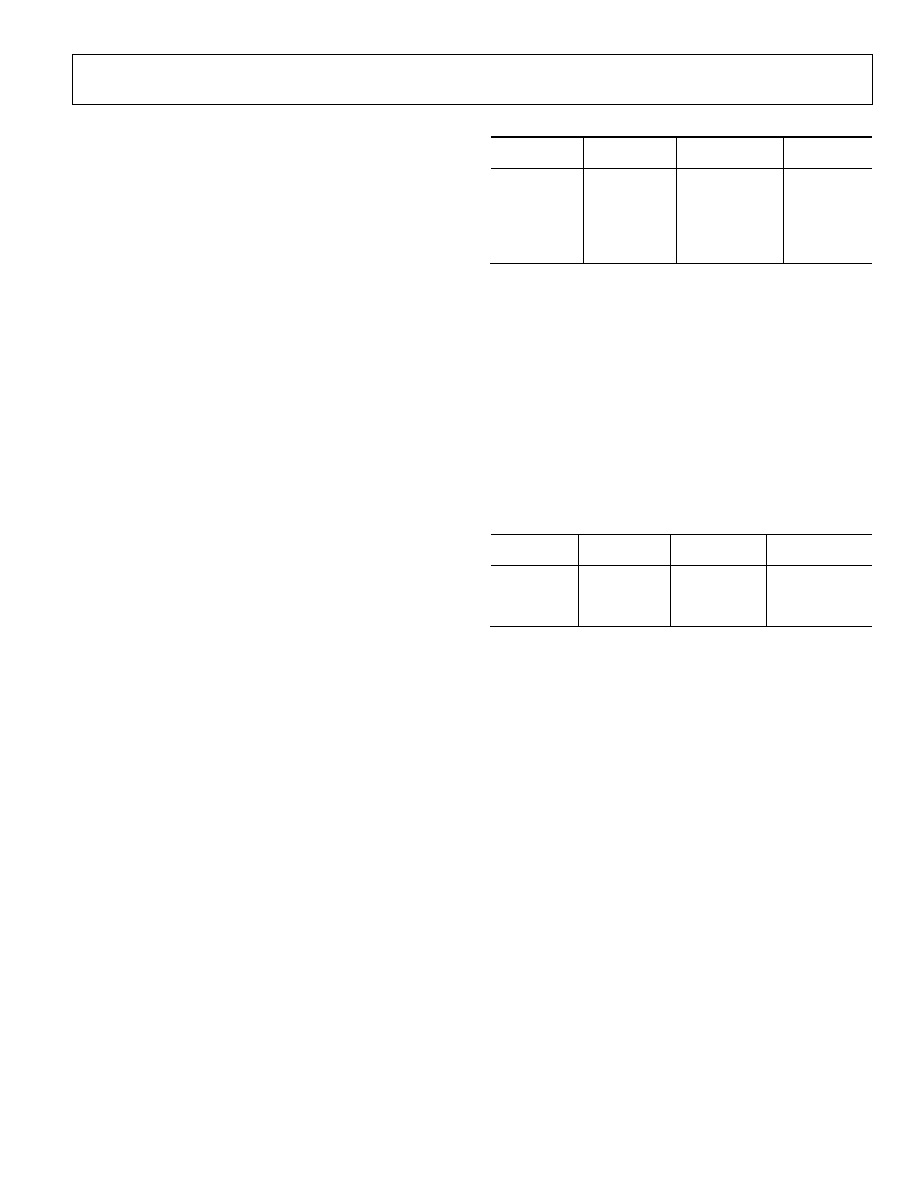
AD9259
Rev. 0 | Page 25 of 52
When using the serial port interface (SPI), the DCO phase can
be adjusted in 60° increments relative to the data edge. This
enables the user to refine system timing margins if required.
The default DCO timing, as shown in Figure 2, is 90° relative to
the output data edge.
An 8-, 10-, and 12-bit serial stream can also be initiated from
the SPI. This allows the user to implement and test compatibility
to lower resolution systems. When changing the resolution to
an 8-, 10-, or 12-bit serial stream, the data stream is shortened.
See Figure 3 for a 12-bit example.
When using the SPI, all of the data outputs can also be inverted
from their nominal state. This is not to be confused with
inverting the serial stream to an LSB-first mode. In default
mode, as shown in Figure 2, the MSB is represented first in the
data output serial stream. However, this can be inverted so that
the LSB is represented first in the data output serial stream (see
Figure 4).
There are 12 digital output test pattern options available that
can be initiated through the SPI. This is a useful feature when
validating receiver capture and timing. Refer to Table 9 for the
output bit sequencing options available. Some test patterns have
two serial sequential words and can be alternated in various
ways, depending on the test pattern chosen. It should be noted
that some patterns may not adhere to the data format select
option. In addition, customer user patterns can be assigned in
the 0x19, 0x1A, 0x1B, and 0x1C register addresses. All test mode
options can support 8- to 14-bit word lengths in order to verify
data capture to the receiver.
Please consult the Memory Map section for information on how
to change these additional digital output timing features through
the serial port interface or SPI.
SDIO/ODM Pin
This pin is for applications that do not require SPI mode operation.
The SDIO/ODM pin can enable a low power, reduced signal option
similar to the IEEE 1596.3 reduced range link output standard if
this pin and the CSB pin are tied to AVDD during device power-
up. This option should only be used when the digital output trace
lengths are less than 2 inches in length to the LVDS receiver. The
FCO, DCO, and outputs function normally, but the LVDS signal
swing of all channels is reduced from 350 mV p-p to 200 mV p-p.
This output mode allows the user to further lower the power on
the DRVDD supply. For applications where this pin is not used,
it should be tied low. In this case, the device pin can be left open,
and the 30 k internal pull-down resistor pulls this pin low. This
pin is only 1.8 V tolerant. If applications require this pin to be
driven from a 3.3 V logic level, insert a 1 k resistor in series
with this pin to limit the current.
Table 10. Output Driver Mode Pin Settings
Selected ODM
ODM Voltage
Resulting
Output Standard
Resulting
FCO and DCO
Normal
operation
10 k to AGND
ANSI-644
(default)
ANSI-644
(default)
ODM AVDD
Low power,
reduced signal
option
Low power,
reduced
signal
option
SCLK/DTP Pin
This pin is for applications that do not require SPI mode operation.
The serial clock/digital test pattern (SCLK/DTP) pin can enable
a single digital test pattern if this pin and the CSB pin are held
high during device power-up. When the DTP is tied to AVDD,
all the ADC channel outputs shift out the following pattern: 10
0000 0000 0000. The FCO and DCO outputs still work as usual
while all channels shift out the repeatable test pattern. This pattern
allows the user to perform timing alignment adjustments among
the FCO, DCO, and output data. For normal operation, this pin
should be tied to AGND through a 10 k resistor. This pin is
both 1.8 V and 3.3 V tolerant.
Table 11. Digital Test Pattern Pin Settings
Selected DTP
DTP Voltage
Resulting
D+ and D-
Resulting
FCO and DCO
Normal
operation
10 k to AGND
Normal
operation
Normal operation
DTP
AVDD
10 0000 0000
0000
Normal operation
Additional and custom test patterns can also be observed when
commanded from the SPI port. Consult the Memory Map
section to choose from the different options available.
CSB Pin
The chip select bar (CSB) pin should be tied to AVDD for
applications that do not require SPI mode operation. By tying
CSB high, all SCLK and SDIO information is ignored. This pin
is both 1.8 V and 3.3 V tolerant.
RBIAS Pin
To set the internal core bias current of the ADC, place a resistor
(nominally equal to 10.0 k) to ground at the RBIAS pin. The
resistor current is derived on-chip and sets the ADC's AVDD
current to a nominal 185 mA at 50 MSPS. Therefore, it is
imperative that at least a 1% tolerance on this resistor be used to
achieve consistent performance. If SFDR performance is not as
critical as power, simply adjust the ADC core current to achieve
a lower power. Figure 53 and Figure 54 show the relationship
between the dynamic range and power as the RBIAS resistance
is changed. Nominally, a 10.0 k value is used, as indicated by
the dashed line.
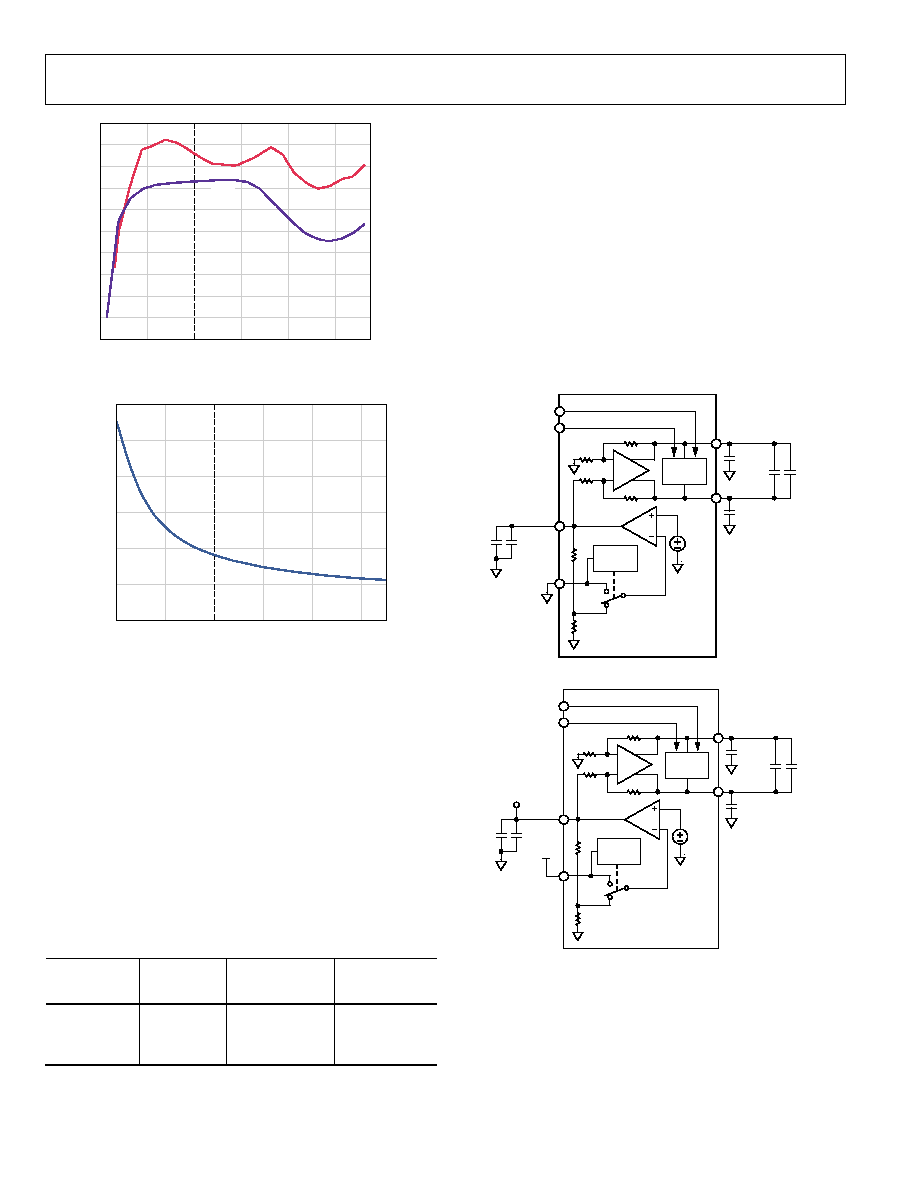
AD9259
Rev. 0 | Page 26 of 52
2
6
10
14
18
22
85
83
81
79
77
75
73
71
69
67
65
S
F
DR (
d
Bc)
RESISTANCE (k)
SNR
SFDR
80
75
70
65
60
55
S
NR (
d
B)
05
96
5-
0
91
Figure 53. SFDR vs. RBIAS
2
6
10
14
18
22
600
500
400
300
200
100
0
I
AV
DD (
m
A)
RESISTANCE (k)
05
96
5-
0
92
Figure 54. IAVDD vs. RBIAS
Voltage Reference
A stable and accurate 0.5 V voltage reference is built into the
AD9259. This is gained up by a factor of 2 internally, setting
V
REF
to 1.0 V, which results in a full-scale differential input span
of 2 V p-p. The V
REF
is set internally by default; however, the
VREF pin can be driven externally with a 1.0 V reference to
achieve more accuracy.
When applying the decoupling capacitors to the VREF, REFT,
and REFB pins, use ceramic low ESR capacitors. These capacitors
should be close to the ADC pins and on the same layer of the
PCB as the AD9259. The recommended capacitor values and
configurations for the AD9259 reference pin can be found in
Figure 55.
Table 12. Reference Settings
Selected
Mode
SENSE
Voltage
Resulting
VREF (V)
Resulting
Differential
Span (V p-p)
External
Reference
AVDD
N/A
2 × external
reference
Internal,
2 V p-p FSR
AGND to 0.2 V
1.0
2.0
Internal Reference Operation
A comparator within the AD9259 detects the potential at the
SENSE pin and configures the reference. If SENSE is grounded,
the reference amplifier switch is connected to the internal
resistor divider (see Figure 55), setting VREF to 1 V.
The REFT and REFB pins establish their input span of the ADC
core from the reference configuration. The analog input full-
scale range of the ADC equals twice the voltage at the reference
pin for either an internal or an external reference configuration.
If the reference of the AD9259 is used to drive multiple
converters to improve gain matching, the loading of the refer-
ence by the other converters must be considered. Figure 57
depicts how the internal reference voltage is affected by loading.
1µF
0.1µF
V
REF
SENSE
0.5V
REFT
0.1µF
0.1µF
2.2µF
0.1µF
REFB
SELECT
LOGIC
ADC
CORE
+
VIN
VIN+
05
96
5-
0
10
Figure 55. Internal Reference Configuration
1µF
1
0.1µF
1
V
REF
SENSE
AVDD
0.5V
REFT
0.1µF
0.1µF
2.2µF
0.1µF
REFB
SELECT
LOGIC
ADC
CORE
+
VIN
VIN+
05965-
046
EXTERNAL
REFERENCE
1
OPTIONAL.
Figure 56. External Reference Operation
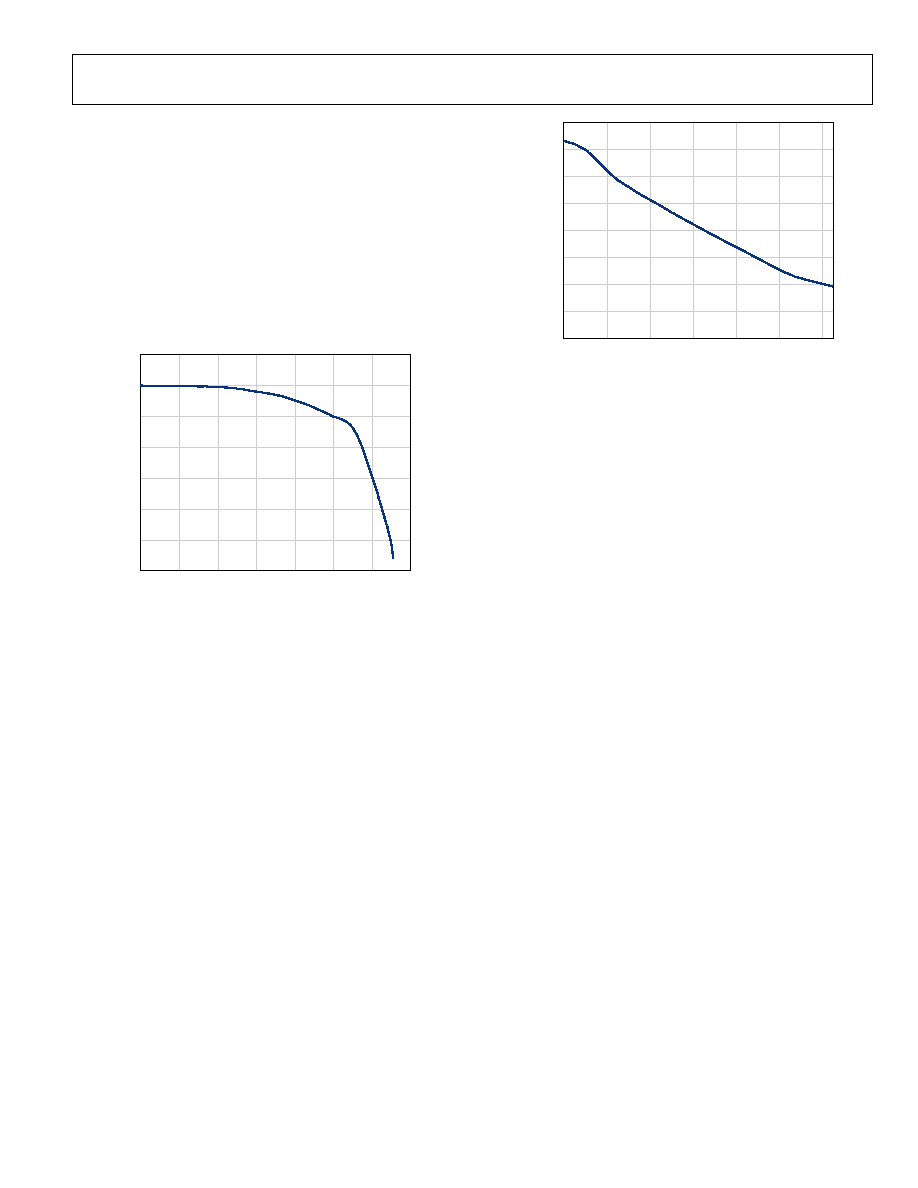
AD9259
Rev. 0 | Page 27 of 52
External Reference Operation
The use of an external reference may be necessary to enhance
the gain accuracy of the ADC or improve thermal drift charac-
teristics. Figure 58 shows the typical drift characteristics of the
internal reference in 1 V mode.
When the SENSE pin is tied to AVDD, the internal reference is
disabled, allowing the use of an external reference. The external
reference is loaded with an equivalent 6 k load. An internal
reference buffer generates the positive and negative full-scale
references, REFT and REFB, for the ADC core. Therefore, the
external reference must be limited to a nominal of 1.0 V.
0
1.0
0.5
2.0
1.5
3.0
2.5
3.5
V
RE
F
E
RRO
R (
%
)
CURRENT LOAD (mA)
059
65
-
08
3
30
5
10
15
20
25
5
0
Figure 57. V
REF
Accuracy vs. Load
V
RE
F
E
RRO
R
(
%
)
05
96
5-
0
84
0.05
0
0.05
0.10
0.10
0.15
0.15
0.20
0.20
40
20
80
60
40
20
0
TEMPERATURE (°C)
Figure 58. Typical V
REF
Drift

AD9259
Rev. 0 | Page 28 of 52
SERIAL PORT INTERFACE (SPI)
The AD9259 serial port interface allows the user to configure
the converter for specific functions or operations through a
structured register space provided inside the ADC. This gives
the user added flexibility and customization depending on the
application. Addresses are accessed via the serial port and can
be written to or read from via the port. Memory is organized
into bytes that can be further divided down into fields, as doc-
umented in the Memory Map section. Detailed operational
information can be found in the Analog Devices user manual
Interfacing to High Speed ADCs via SPI
.
There are three pins that define the serial port interface, or SPI,
to this particular ADC. They are the SCLK, SDIO, and CSB
pins. The SCLK (serial clock) is used to synchronize the read
and write data presented to the ADC. The SDIO (serial data
input/output) is a dual-purpose pin that allows data to be sent
to and read from the internal ADC memory map registers. The
CSB (chip select bar) is an active low control that enables or
disables the read and write cycles (see Table 13).
Table 13. Serial Port Pins
Pin Function
SCLK
Serial Clock. The serial shift clock in. SCLK is used to
synchronize serial interface reads and writes.
SDIO
Serial Data Input/Output. A dual-purpose pin. The
typical role for this pin is an input or output, depending
on the instruction sent and the relative position in the
timing frame.
CSB
Chip Select Bar (Active Low). This control gates the read
and write cycles.
The falling edge of the CSB in conjunction with the rising edge
of the SCLK determines the start of the framing sequence. During
an instruction phase, a 16-bit instruction is transmitted, followed
by one or more data bytes, which is determined by Bit Fields
W0 and W1. An example of the serial timing and its definitions
can be found in Figure 59 and Table 14. In normal operation,
CSB is used to signal to the device that SPI commands are to be
received and processed. When CSB is brought low, the device
processes SCLK and SDIO to process instructions. Normally,
CSB remains low until the communication cycle is complete.
However, if connected to a slow device, CSB can be brought
high between bytes, allowing older microcontrollers enough
time to transfer data into shift registers. CSB can be stalled
when transferring one, two, or three bytes of data. When W0
and W1 are set to 11, the device enters streaming mode and
continues to process data, either reading or writing, until the
CSB is taken high to end the communication cycle. This allows
complete memory transfers without having to provide additional
instructions. Regardless of the mode, if CSB is taken high in the
middle of any byte transfer, the SPI state machine is reset and
the device waits for a new instruction.
In addition to the operation modes, the SPI port can be
configured to operate in different manners. For applications
that do not require a control port, the CSB line can be tied and
held high. This places the remainder of the SPI pins in their
secondary mode as defined in the Serial Port Interface (SPI)
section. CSB can also be tied low to enable 2-wire mode. When
CSB is tied low, SCLK and SDIO are the only pins required for
communication. Although the device is synchronized during
power-up, caution must be exercised when using this mode to
ensure that the serial port remains synchronized with the CSB
line. When operating in 2-wire mode, it is recommended to use
a 1-, 2-, or 3-byte transfer exclusively. Without an active CSB
line, streaming mode can be entered but not exited.
In addition to word length, the instruction phase determines if
the serial frame is a read or write operation, allowing the serial
port to be used to both program the chip and read the contents
of the on-chip memory. If the instruction is a readback operation,
performing a readback causes the serial data input/output (SDIO)
pin to change direction from an input to an output at the
appropriate point in the serial frame.
Data can be sent in MSB- or LSB-first mode. MSB-first mode
is the default at power-up and can be changed by adjusting the
configuration register. For more information about this and
other features, see the user manual
Interfacing to High Speed
ADCs via SPI
.
HARDWARE INTERFACE
The pins described in Table 13 compose the physical interface
between the user's programming device and the serial port of
the AD9259. The SCLK and CSB pins function as inputs when
using the SPI interface. The SDIO pin is bidirectional, functioning
as an input during write phases and as an output during readback.
This interface is flexible enough to be controlled by either serial
PROMS or PIC mirocontrollers. This provides the user an
alternative method, other than a full SPI controller, to program
the ADC (see the
AN-812 Application Note
).
If the user chooses not to use the SPI interface, these pins serve
a dual function and are associated with secondary functions
when the CSB is strapped to AVDD during device power-up.
See the Theory of Operation section for details on which pin-
strappable functions are supported on the SPI pins.
For users who simply wish to operate the DUT without using
SPI, remove any connections from the CSB, SCLK/DTP, and
SDIO/OMD pins. By disconnecting these pins from the control
bus, the DUT can operate in its most basic operation. Each of
these pins has an internal termination and will float to its
respective level.
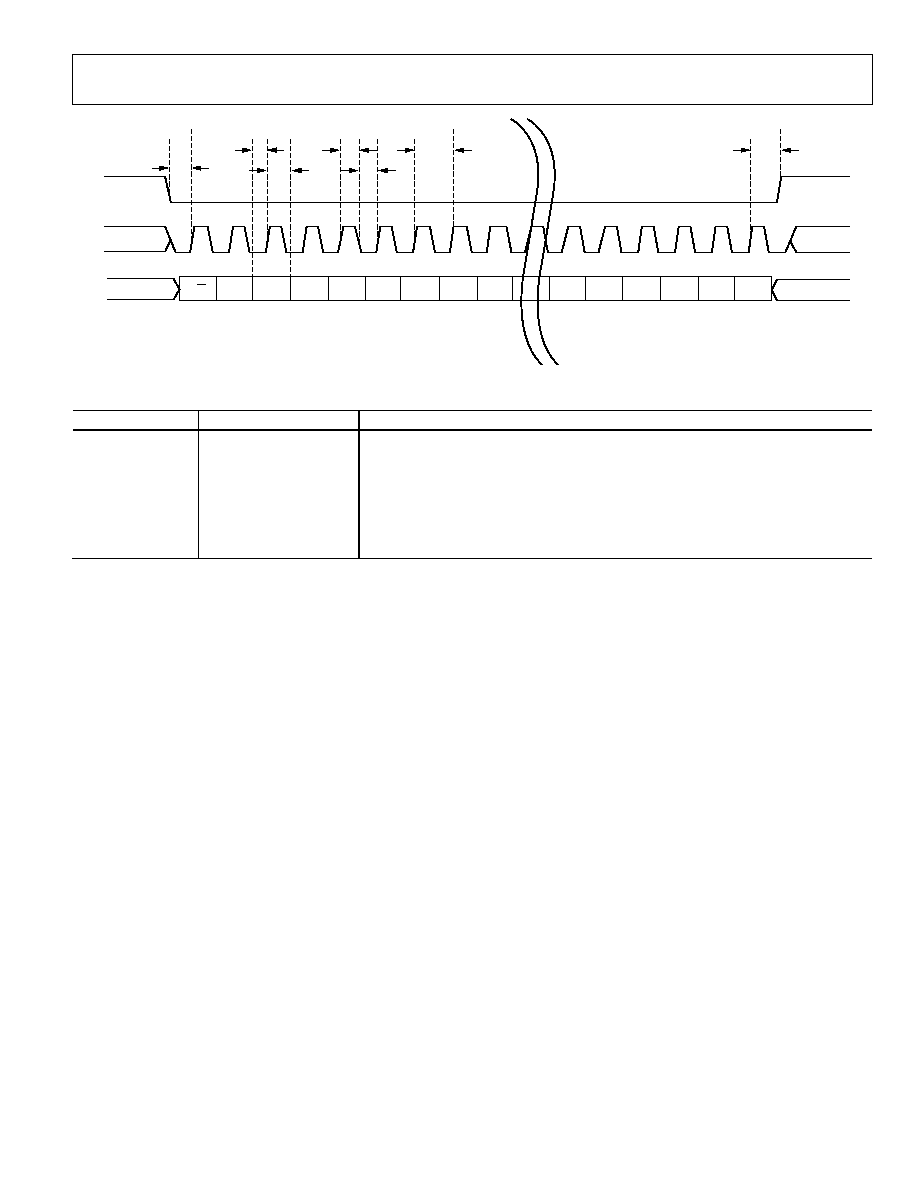
AD9259
Rev. 0 | Page 29 of 52
DON'T CARE
DON'T CARE
DON'T CARE
DON'T CARE
SDIO
SCLK
CSB
t
S
t
DH
t
HI
t
CLK
t
LO
t
DS
t
H
R/W
W1
W0
A12
A11
A10
A9
A8
A7
D5
D4
D3
D2
D1
D0
0
5965
-
012
Figure 59. Serial Timing Details
Table 14. Serial Timing Definitions
Parameter
Timing (minimum, ns)
Description
t
DS
5
Setup time between the data and the rising edge of SCLK
t
DH
2
Hold time between the data and the rising edge of SCLK
t
CLK
40
Period of the clock
t
S
5
Setup time between CSB and SCLK
t
H
2
Hold time between CSB and SCLK
t
HI
16
Minimum period that SCLK should be in a logic high state
t
LO
16
Minimum period that SCLK should be in a logic low state

AD9259
Rev. 0 | Page 30 of 52
MEMORY MAP
READING THE MEMORY MAP TABLE
Each row in the memory map table has eight address locations.
The memory map is roughly divided into three sections: chip
configuration register map (Address 0x00 to Address 0x02), device
index and transfer register map (Address 0x05 and Address 0xFF),
and program register map (Address 0x08 to Address 0x25).
The left-hand column of the memory map indicates the register
address number in hexadecimal. The default value of this address is
shown in hexadecimal in the right-hand column. The Bit 7 (MSB)
column is the start of the default hexadecimal value given. For
example, Hexadecimal Address 0x09, Clock, has a hexadecimal
default value of 0x01. This means Bit 7 = 0, Bit 6 = 0, Bit 5 = 0,
Bit 4 = 0, Bit 3 = 0, Bit 2 = 0, Bit 1 = 0, and Bit 0 = 1, or 0000 0001
in binary. This setting is the default for the duty cycle stabilizer in
the on condition. By writing a 0 to Bit 6 at this address, the duty
cycle stabilizer turns off. For more information on this and other
functions, consult the user manual
Interfacing to High Speed
ADCs via SPI
.
RESERVED LOCATIONS
Undefined memory locations should not be written to except
when writing the default values suggested in this data sheet.
Addresses that have values marked as 0 should be considered
reserved and have a 0 written into their registers during power-up.
DEFAULT VALUES
Coming out of reset, critical registers are preloaded with default
values. These values are indicated in Table 15, where an X refers
to an undefined feature.
LOGIC LEVELS
An explanation of various registers follows: "Bit is set" is
synonymous with "bit is set to Logic 1" or "writing Logic 1 for
the bit." Similarly, "clear a bit" is synonymous with "bit is set to
Logic 0" or "writing Logic 0 for the bit."
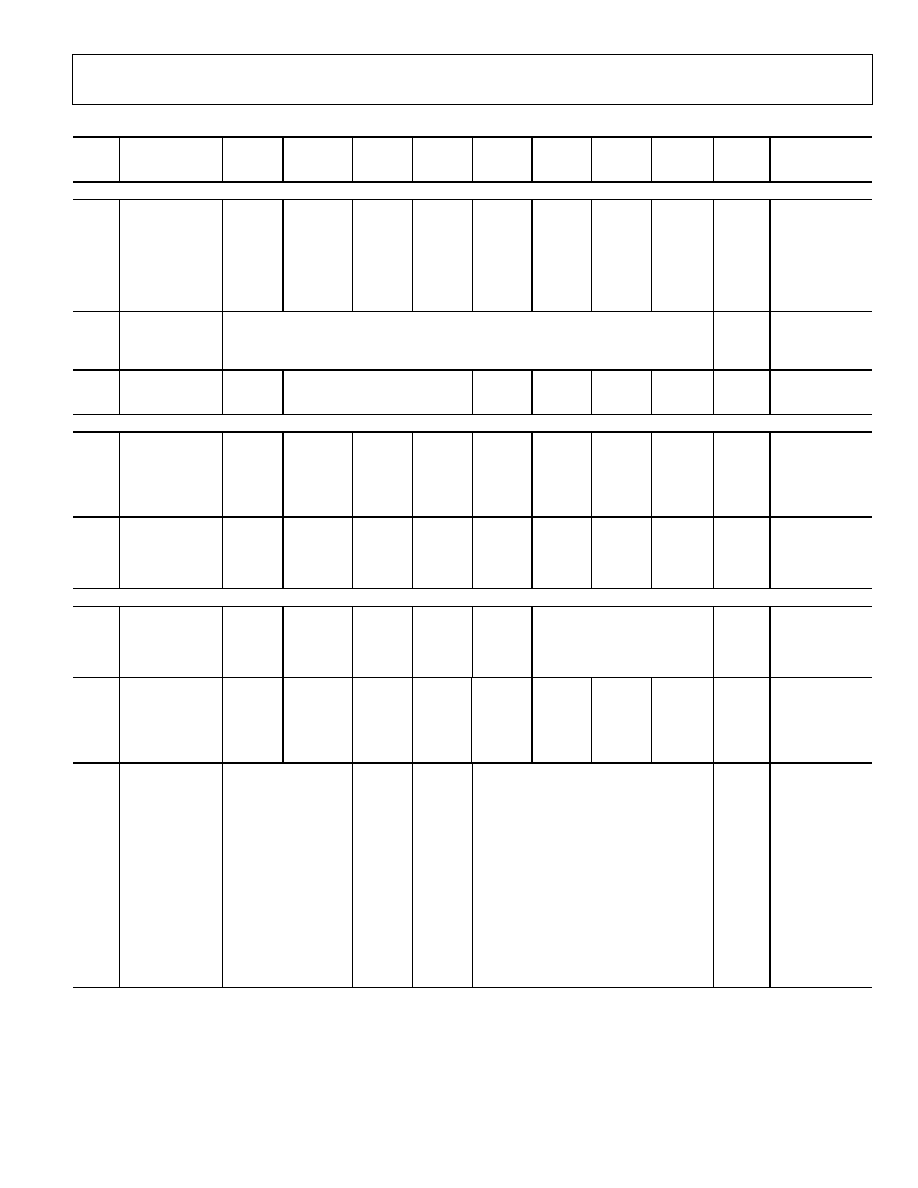
AD9259
Rev. 0 | Page 31 of 52
Table 15. Memory Map Register
Addr.
(Hex) Parameter
Name
Bit 7
(MSB)
Bit 6
Bit 5
Bit 4 Bit
3 Bit
2 Bit
1
Bit 0
(LSB)
Default
Value
(Hex)
Default Notes/
Comments
Chip Configuration Registers
00 chip_port_config
0
LSB
first
1 = on
0 = off
(default)
Soft
reset
1 = on
0 = off
(default)
1 1 Soft
reset
1 = on
0 = off
(default)
LSB first
1 = on
0 = off
(default)
0 0x18
The
nibbles
should be
mirrored so that
LSB- or MSB-first
mode registers
correctly
regardless of
shift mode.
01
chip_id
8-bit Chip ID Bits 7:0
(AD9259 = 0x04), (default)
0x04
Read
only
Default is unique
chip ID. This is a
read-only
register.
02
chip_grade
X
Child ID 6:4
(identify device variants of Chip ID)
100 = 50 MSPS
X X X X Read
only
Child ID used to
differentiate
graded devices.
Device Index and Transfer Registers
05 device_index_A
X
X
Clock
Channel
DCO
1 = on
0 = off
(default)
Clock
Channel
FCO
1 = on
0 = off
(default)
Data
Channel
D
1 = on
(default)
0 = off
Data
Channel
C
1 = on
(default)
0 = off
Data
Channel
B
1 = on
(default)
0 = off
Data
Channel
A
1 = on
(default)
0 = off
0x0F
Bits are set to
determine which
on-chip device
receives the next
write command.
FF
device_update
X X X X X X X SW
transfer
1 = on
0 = off
(default)
0x00 Synchronously
transfers data
from the master
shift register to
the slave.
ADC Functions
08
modes
X
X
X
X
X
Internal power-down mode
000 = chip run (default)
001 = full power-down
010 = standby
011 = reset
0x00 Determines
various generic
modes of chip
operation.
09
clock
X X X X X X X Duty
cycle
stabilizer
1 = on
(default)
0 = off
0x01 Turns
the
internal duty
cycle stabilizer
on and off.
0D
test_io
User test mode
00 = off (default)
01 = on, single alternate
10 = on, single once
11 = on, alternate once
Reset PN
long gen
1 = on
0 = off
(default)
Reset
PN short
gen
1 = on
0 = off
(default)
Output test mode--see
Table 9
in the
Digital Outputs and Timing
section
0000 = off (default)
0001 = midscale short
0010 = +FS short
0011 = -FS short
0100 = checker board output
0101 = PN 23 sequence
0110 = PN 9
0111 = one/zero word toggle
1000 = user input
1001 = one/zero bit toggle
1010 = 1× sync
1011 = one bit high
1100 = mixed bit frequency
(format determined by output_mode)
0x00
When set, the
test data is
placed on the
output pins in
place of normal
data.
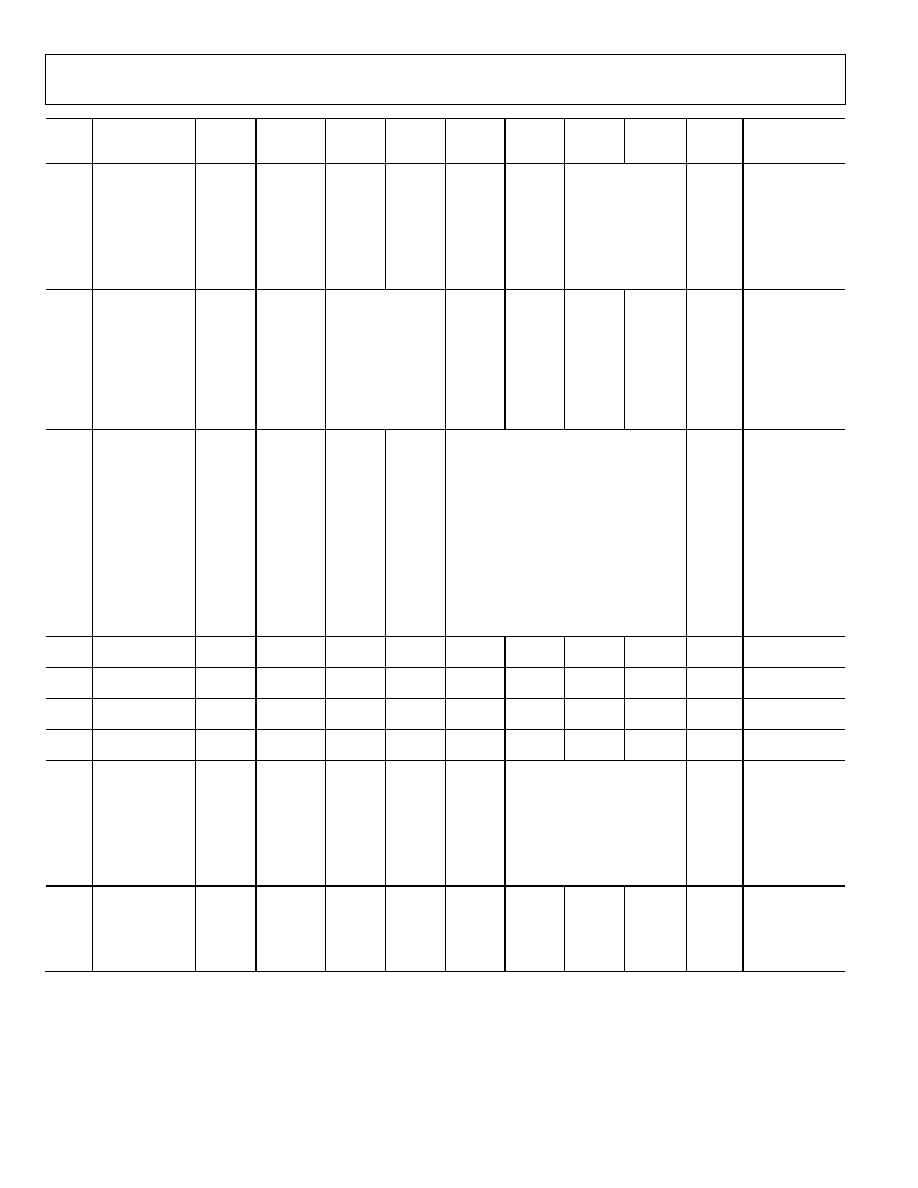
AD9259
Rev. 0 | Page 32 of 52
Addr.
(Hex)
Parameter Name
Bit 7
(MSB)
Bit 6
Bit 5
Bit 4
Bit 3
Bit 2
Bit 1
Bit 0
(LSB)
Default
Value
(Hex)
Default Notes/
Comments
14
output_mode
X
0 = LVDS
ANSI
(default)
1 = LVDS
low
power,
(IEEE
1596.3
similar)
X X X Output
invert
1 = on
0 = off
(default)
00 = offset binary
(default)
01 = twos
complement
0x00 Configures
the
outputs and the
format of the
data.
15 output_adjust X
X
Output driver
termination
00 = none (default)
01 = 200
10 = 100
11 = 100
X
X
X
X
0x00 Determines
LVDS or other
output properties.
Primarily func-
tions to set the
LVDS span and
common-mode
levels in place of
an external
resistor.
16 output_phase X
X
X
X
0011 = output clock phase adjust
(0000 through 1010)
(Default: 180° relative to DATA edge)
0000 = 0° relative to DATA edge
0001 = 60° relative to DATA edge
0010 = 120° relative to DATA edge
0011 = 180° relative to DATA edge
0100 = 240° relative to DATA edge
0101 = 300° relative to DATA edge
0110 = 360° relative to DATA edge
0111 = 420° relative to DATA edge
1000 = 480° relative to DATA edge
1001 = 540° relative to DATA edge
1010 = 600° relative to DATA edge
1011 to 1111 = 660° relative to DATA edge
0x03
On devices that
utilize global
clock divide,
determines
which phase of
the divider
output is used to
supply the
output clock.
Internal latching
is unaffected.
19
user_patt1_lsb
B7 B6 B5 B4 B3 B2 B1 B0 0x00
User-defined
pattern, 1 LSB.
1A user_patt1_msb
B15 B14
B13 B12 B11 B10 B9 B8 0x00
User-defined
pattern, 1 MSB.
1B
user_patt2_lsb
B7 B6 B5 B4 B3 B2 B1 B0 0x00
User-defined
pattern, 2 LSB.
1C user_patt2_msb
B15 B14
B13 B12 B11 B10 B9 B8 0x00
User-defined
pattern, 2 MSB.
21 serial_control LSB
first
1 = on
0 = off
(default)
X X
X
<10
MSPS,
low
encode
rate
mode
1 = on
0 = off
(default)
000 = 14 bits (default, normal bit
stream)
001 = 8 bits
010 = 10 bits
011 = 12 bits
100 = 14 bits
0x00 Serial
stream
control. Default
causes MSB first
and the native
bit stream
(global).
22
serial_ch_stat
X X X X X X Channel
output
reset
1 = on
0 = off
(default)
Channel
power-
down
1 = on
0 = off
(default)
0x00
Used to power
down individual
sections of a
converter (local).
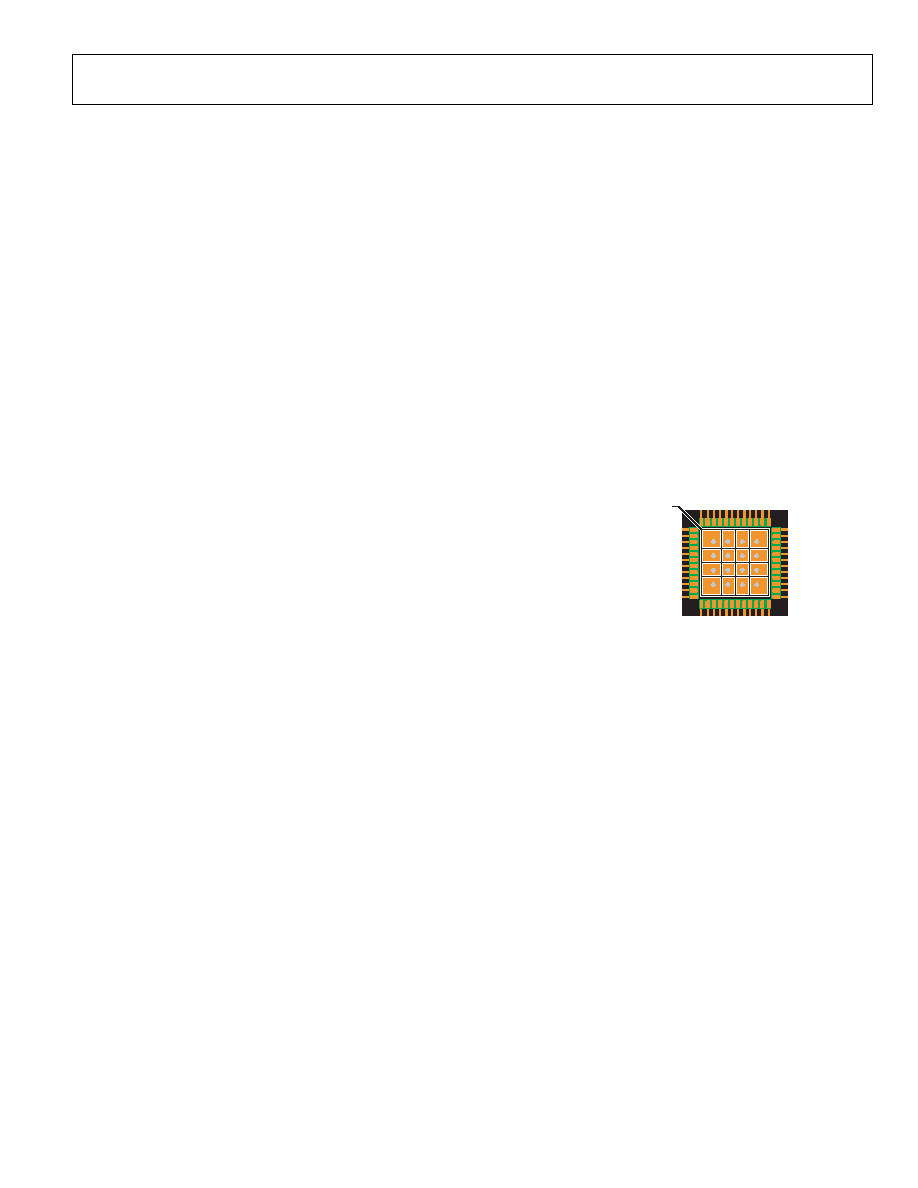
AD9259
Rev. 0 | Page 33 of 52
Power and Ground Recommendations
When connecting power to the AD9259, it is recommended
that two separate 1.8 V supplies be used: one for analog (AVDD)
and one for digital (DRVDD). If only one supply is available, it
should be routed to the AVDD first and then tapped off and
isolated with a ferrite bead or a filter choke preceded by
decoupling capacitors for the DRVDD. The user can employ
several different decoupling capacitors to cover both high and
low frequencies. These should be located close to the point of
entry at the PC board level and close to the parts with minimal
trace length.
A single PC board ground plane should be sufficient when
using the AD9259. With proper decoupling and smart parti-
tioning of the PC board's analog, digital, and clock sections,
optimum performance is easily achieved.
Exposed Paddle Thermal Heat Slug Recommendations
It is required that the exposed paddle on the underside of the
ADC is connected to analog ground (AGND) to achieve the
best electrical and thermal performance of the AD9259. An
exposed continuous copper plane on the PCB should mate to
the AD9259 exposed paddle, Pin 0. The copper plane should
have several vias to achieve the lowest possible resistive thermal
path for heat dissipation to flow through the bottom of the PCB.
These vias should be solder filled or plugged.
To maximize the coverage and adhesion between the ADC and
PCB, partition the continuous copper plane by overlaying a
silkscreen on the PCB into several uniform sections. This provides
several tie points between the two during the reflow process.
Using one continuous plane with no partitions only guarantees
one tie point between the ADC and PCB. See Figure 60 for a
PCB layout example. For detailed information on packaging
and the PCB layout of chip scale packages, see the
AN-772
Application Note
, "A Design and Manufacturing Guide for the
Lead Frame Chip Scale Package (LFCSP)," at
www.analog.com
.
SILKSCREEN PARTITION
PIN 1 INDICATOR
059
65-
01
3
Figure 60. Typical PCB Layout
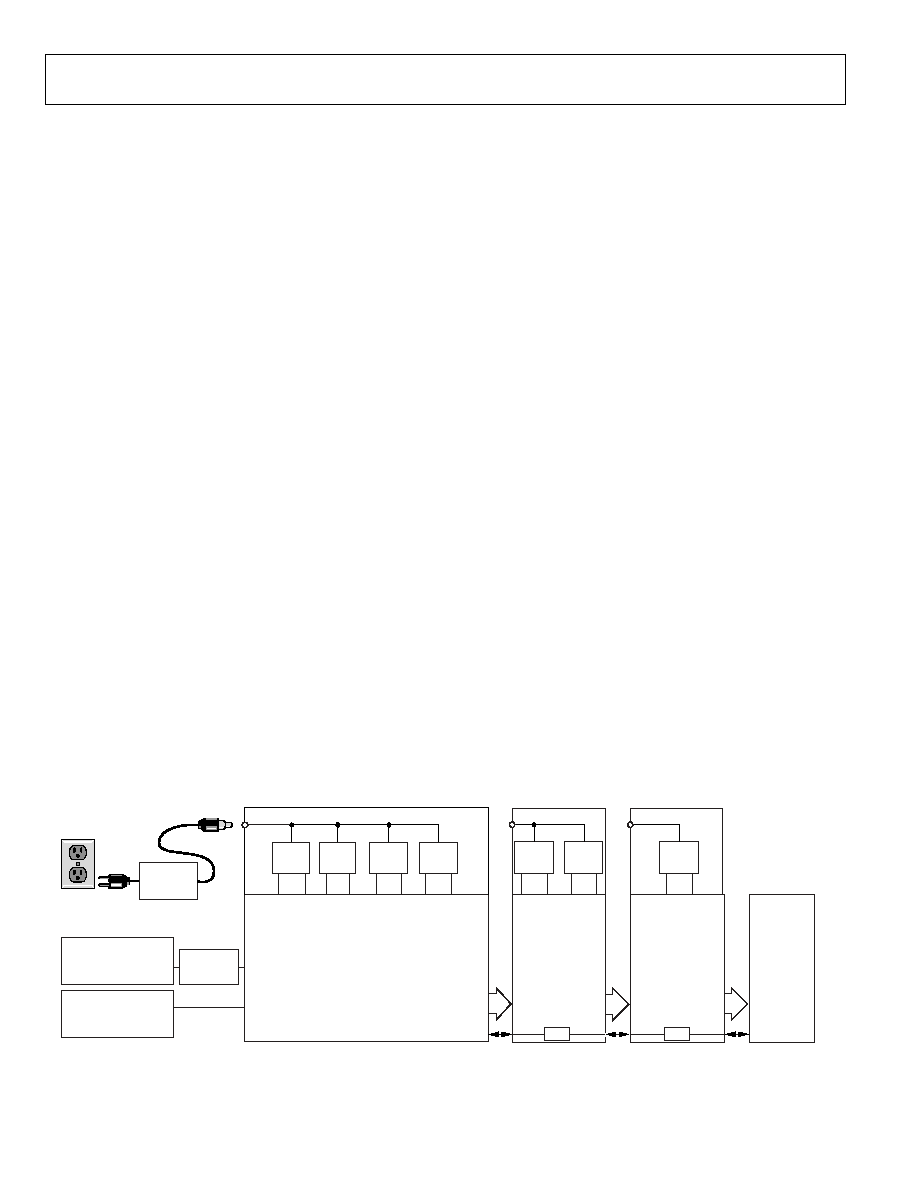
AD9259
Rev. 0 | Page 34 of 52
EVALUATION BOARD
The AD9259 evaluation board provides all of the support cir-
cuitry required to operate the ADC in its various modes and
configurations. The converter can be driven differentially through a
transformer (default) or through the
AD8332
driver. The ADC
can also be driven in a single-ended fashion. Separate power pins
are provided to isolate the DUT from the
AD8332
drive circuitry.
Each input configuration can be selected by proper connection
of various jumpers (see Figure 63 to Figure 67). Figure 61 shows
the typical bench characterization setup used to evaluate the ac
performance of the AD9259. It is critical that the signal sources
used for the analog input and clock have very low phase noise
(<1 ps rms jitter) to realize the optimum performance of the
converter. Proper filtering of the analog input signal to remove
harmonics and lower the integrated or broadband noise at the
input is also necessary to achieve the specified noise performance.
See Figure 63 to Figure 71 for the complete schematics and
layout diagrams that demonstrate the routing and grounding
techniques that should be applied at the system level.
POWER SUPPLIES
This evaluation board comes with a wall-mountable switching
power supply that provides a 6 V, 2 A maximum output. Simply
connect the supply to the rated 100 V ac to 240 V ac wall outlet
at 47 Hz to 63 Hz. The other end is a 2.1 mm inner diameter
jack that connects to the PCB at P503. Once on the PC board,
the 6 V supply is fused and conditioned before connecting to
three low dropout linear regulators that supply the proper bias
to each of the various sections on the board.
When operating the evaluation board in a nondefault condition,
L504 to L507 can be removed to disconnect the switching
power supply. This enables the user to bias each section of the
board individually. Use P501 to connect a different supply for
each section. At least one 1.8 V supply is needed with a 1 A current
capability for AVDD_DUT and DRVDD_DUT; however, it is
recommended that separate supplies be used for both analog
and digital. To operate the evaluation board using the VGA
option, a separate 5.0 V analog supply is needed. The 5.0 V
supply, or AVDD_5 V, should have a 1 A current capability. To
operate the evaluation board using the SPI and alternate clock
options, a separate 3.3 V analog supply is needed in addition to
the other supplies. The 3.3 V supply, or AVDD_3.3 V, should
have a 1 A current capability as well.
INPUT SIGNALS
When connecting the clock and analog source, use clean signal
generators with low phase noise, such as Rohde & Schwarz SMHU
or HP8644 signal generators or the equivalent. Use a 1 m, shielded,
RG-58, 50 coaxial cable for making connections to the evalu-
ation board. Enter the desired frequency and amplitude from the
ADC specifications tables. Typically, most ADI evaluation boards
can accept ~2.8 V p-p or 13 dBm sine wave input for the clock.
When connecting the analog input source, it is recommended
to use a multipole, narrow-band, band-pass filter with 50
terminations. ADI uses TTE, Allen Avionics, and K&L types of
band-pass filters. The filter should be connected directly to the
evaluation board if possible.
OUTPUT SIGNALS
The default setup uses the
HSC-ADC-FPGA
high speed
deserialization board to deserialize the digital output data and
convert it to parallel CMOS. These two channels interface
directly with the ADI standard dual-channel FIFO data capture
board (
HSC-ADC-EVALA-DC
). Two of the four channels can
then be evaluated at the same time. For more information on
channel settings on these boards and their optional settings,
visit
www.analog.com/FIFO
.
ROHDE & SCHWARZ,
SMHU,
2V p-p SIGNAL
SYNTHESIZER
ROHDE & SCHWARZ,
SMHU,
2V p-p SIGNAL
SYNTHESIZER
BAND-PASS
FILTER
XFMR
INPUT
CLK
CHA TO CHD
14-BIT
SERIAL
LVDS
2 CH
14-BIT
PARALLEL
CMOS
USB
CONNECTION
AD9259
EVALUATION BOARD
HSC-ADC-FPGA
HIGH SPEED
DESERIALIZATION
BOARD
HSC-ADC-EVALA-DC
FIFO DATA
CAPTURE
BOARD
PC
RUNNING
ADC
ANALYZER
AND SPI
USER
SOFTWARE
1.8V
+
+
A
V
DD_DU
T
A
V
DD_3.
3V
D
R
V
DD_DU
T
GN
D
GN
D
+
5.0V
GN
D
A
V
DD_5V
1.8V
6V DC
2A MAX
WALL OUTLET
100V TO 240V AC
47Hz TO 63Hz
SWITCHING
POWER
SUPPLY
+
GN
D
3.3V
+
1.
5V
_
F
P
G
A
3.
3
V
_D
GN
D
3.3V
+
GN
D
1.5V
+
VC
C
GN
D
3.3V
SPI
SPI
SPI
SPI
0
59
65
-
0
14
Figure 61. Evaluation Board Connection

AD9259
Rev. 0 | Page 35 of 52
DEFAULT OPERATION AND JUMPER SELECTION
SETTINGS
The following is a list of the default and optional settings or
modes allowed on the AD9259 Rev. A evaluation board.
·
POWER: Connect the switching power supply that is
supplied in the evaluation kit between a rated 100 V ac
to 240 V ac wall outlet at 47 Hz to 63 Hz and P503.
·
AIN: The evaluation board is set up for a transformer-
coupled analog input with optimum 50 impedance
matching out to 200 MHz (see Figure 62). For more
bandwidth response, the differential capacitor across the
analog inputs can be changed or removed. The common
mode of the analog inputs is developed from the center
tap of the transformer or AVDD_DUT/2.
0
AM
P
L
I
T
UD
E
(
d
BF
S
)
FREQUENCY (MHz)
05
96
5-
0
88
0
16
14
12
10
8
6
4
2
50
100
150
200
250
300
350
400
450
500
3dB CUTOFF = 200MHz
Figure 62. Evaluation Board Full Power Bandwidth
·
VREF: VREF is set to 1.0 V by tying the SENSE pin to
ground, R237. This causes the ADC to operate in 2.0 V p-p
full-scale range. A separate external reference option using
the
ADR510
or
ADR520
is also included on the evaluation
board. Simply populate R231 and R235 and remove C214.
Proper use of the VREF options is noted in the Voltage
Reference section.
·
RBIAS: RBIAS has a default setting of 10 k (R201) to
ground and is used to set the ADC core bias current. To
further lower the core power (excluding the LVDS driver
supply), simply change the resistor setting. However, per-
formance of the ADC will degrade depending on the resistor
chosen. See the RBIAS Pin section for more information.
·
CLOCK: The default clock input circuitry is derived from a
simple transformer-coupled circuit using a high bandwidth
1:1 impedance ratio transformer (T201) that adds a very
low amount of jitter to the clock path. The clock input is
50 terminated and ac-coupled to handle single-ended
sine wave types of inputs. The transformer converts the
single-ended input to a differential signal that is clipped
before entering the ADC clock inputs.
A differential LVPECL clock can also be used to clock the
ADC input using the
AD9515
(U202). Simply populate
R225 and R227 with 0 resistors and remove R217 and
R218 to disconnect the default clock path inputs. In addition,
populate C207 and C208 with a 0.1 F capacitor and remove
C210 and C211 to disconnect the default cloth path outputs.
The
AD9515
has many pin-strappable options that are set
to a default working condition. Consult the
AD9515
data
sheet for more information about these and other options.
If using an oscillator, two oscillator footprint options are
also available (OSC201) to check the ADC performance.
J205 gives the user flexibility in using the enable pin, which
is common on most oscillators.
·
PDWN: To enable the power-down feature, simply short
J201 to the on position (AVDD) on the PDWN pin.
·
SCLK/DTP: To enable the digital test pattern
on the digital outputs of the ADC, use J204. If J204 is tied to
AVDD during device power-up, Test Pattern 10 0000 0000
0000 will be enabled. See the SCLK/DTP Pin section for
details.
·
SDIO/ODM: To enable the low power, reduced signal option
similar to the IEEE 1595.3 reduced range link LVDS output
standard, use J203. If J203 is tied to AVDD during device
power-up, it enables the LVDS outputs in a low power,
reduced signal option from the default ANSI standard.
This option changes the signal swing from 350 mV p-p to
200 mV p-p, which reduces the power of the DRVDD supply.
See the SDIO/ODM Pin section for more details.
·
CSB: To enable the SPI information on the SDIO and
SCLK pins that is to be processed, simply tie J202 low in
the always enable mode. To ignore the SDIO and SCLK
information, tie J202 to AVDD.
·
Non-SPI Mode: For users who wish to operate the DUT
without using SPI, simply remove the J202, J203, and J204
jumpers. This disconnects the CSB, SCLK/DTP, and SDIO/
OMD pins from the control bus, allowing the DUT to operate
in its simplest mode. Each of these pins has internal termi-
nation and will float to its respective level.
·
D+, D-: If an alternative data capture method to the setup
described in Figure 61 is used, optional receiver terminations,
R206 to R211, can be installed next to the high speed back-
plane connector.

AD9259
Rev. 0 | Page 36 of 52
ALTERNATIVE ANALOG INPUT DRIVE
CONFIGURATION
The following is a brief description of the alternative analog
input drive configuration using the
AD8332
dual VGA. If this
particular drive option is in use, some components may need to
be populated, in which case all the necessary components are
listed in Table 16. For more details on the
AD8332
dual VGA,
including how it works and its optional pin settings, consult the
AD8332
data sheet.
To configure the analog input to drive the VGA instead of the
default transformer option, the following components need to
be removed and/or changed.
·
Remove R102, R115, R128, R141, T101, T102, T103, and
T104 in the default analog input path.
·
Populate R101, R114, R127, and R140 with 0 resistors in
the analog input path.
·
Populate R106, R107, R119, R120, R132, R133, R144, and
R145 with 10 k resistors to provide an input common-
mode level to the analog input.
·
Populate R105, R113, R118, R124, R131, R137, R151, and
R160 with 0 resistors in the analog input path.
Currently, L301 to L308 and L401 to L408 are populated with 0
resistors to allow signal connection. This area allows the user to
design a filter if additional requirements are necessary.
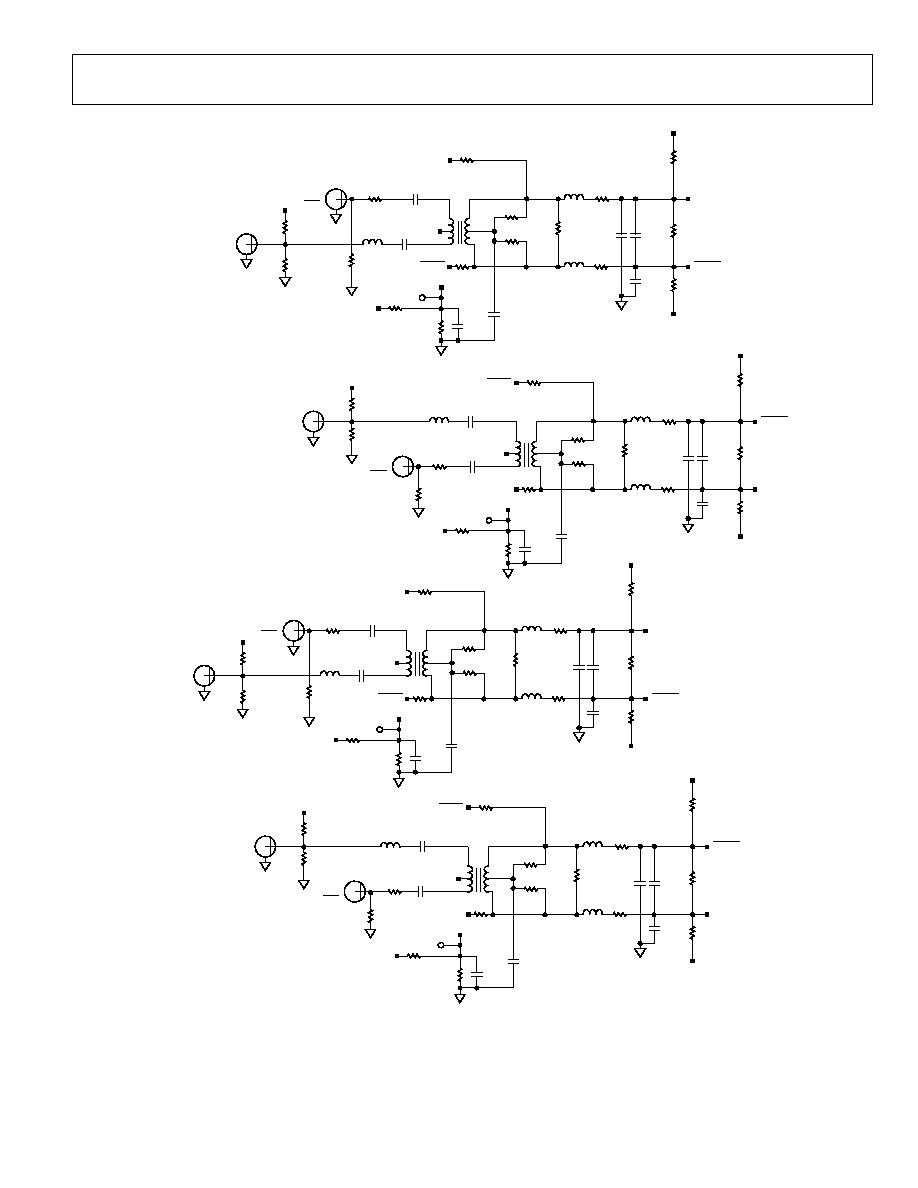
AD9259
Rev. 0 | Page 37 of 52
CHANNEL A
P101
AIN
AIN
VGA INPUT CONNECTION
VGA INPUT CONNECTION
VGA INPUT CONNECTION
VGA INPUT CONNECTION
1
2
3
6
5
4
T101
CM1
CM1
FB103
10
FB102
10
FB101
10
C104
2.2pF
VIN_A
VIN_A
P102
DNP
CM1
INH1
CH_A
AVDD_DUT
CH_A
R104
0
AVDD_DUT
AVDD_DUT
C106
DNP
C107
0.1µF
C103
DNP
C105
DNP
C101
0.1µF
C102
0.1µF
E101
R161
499
R152
DNP
R113
DNP
R105
DNP
R110
33
R107
DNP
R106
DNP
R112
1k
R111
1k
R108
33
R101
DNP
R102
64.9
R103
0
R109
1k
CHANNEL B
P103
AIN
1
2
3
6
5
4
T102
CM2
CM2
FB106
10
FB105
10
FB104
10
C111
2.2pF
VIN_B
VIN_B
P104
DNP
CM2
INH2
CH_B
AVDD_DUT
CH_B
R116
0
AVDD_DUT
AVDD_DUT
C113
DNP
C114
0.1µF
C110
DNP
C112
DNP
C108
0.1µF
C109
0.1µF
E102
R162
499
R153
DNP
R124
DNP
R118
DNP
R122
33
R120
DNP
R119
DNP
R126
1k
R125
1k
R121
33
R114
DNP
R115
64.9
R117
0
R123
1k
CHANNEL C
P105
AIN
1
2
3
6
5
4
T103
CM3
CM3
FB109
10
FB108
10
FB107
10
C118
2.2pF
VIN_C
VIN_C
P106
DNP
CM3
INH3
CH_C
AVDD_DUT
CH_C
R130
0
AVDD_DUT
AVDD_DUT
C120
DNP
C121
0.1µF
C117
DNP
C119
DNP
C115
0.1µF
C116
0.1µF
E103
R163
499
R154
DNP
R137
DNP
R131
DNP
R136
33
R133
DNP
R132
DNP
R139
1k
R138
1k
R134
33
R127
DNP
R128
64.9
R129
0
R135
1k
CHANNEL D
P107
AIN
1
2
3
6
5
4
T104
CM4
CM4
FB112
10
FB111
10
R143
0
C125
2.2pF
VIN_D
VIN_D
P108
DNP
CM4
INH4
CH_D
AVDD_DUT
CH_D
FB110
10
AVDD_DUT
AVDD_DUT
C127
DNP
C128
0.1µF
C124
DNP
C126
DNP
R159
DNP
C122
0.1µF
C123
0.1µF
E104
R164
499
R155
DNP
R160
DNP
R151
DNP
R147
33
R145
DNP
R144
DNP
R150
1k
R149
1k
R146
33
R140
DNP
R141
64.9
R142
0
R148
1k
R156
DNP
R157
DNP
AIN
AIN
AIN
R158
DNP
DNP: DO NOT POPULATE
05
96
5-
0
15
Figure 63. Evaluation Board Schematic, DUT Analog Inputs
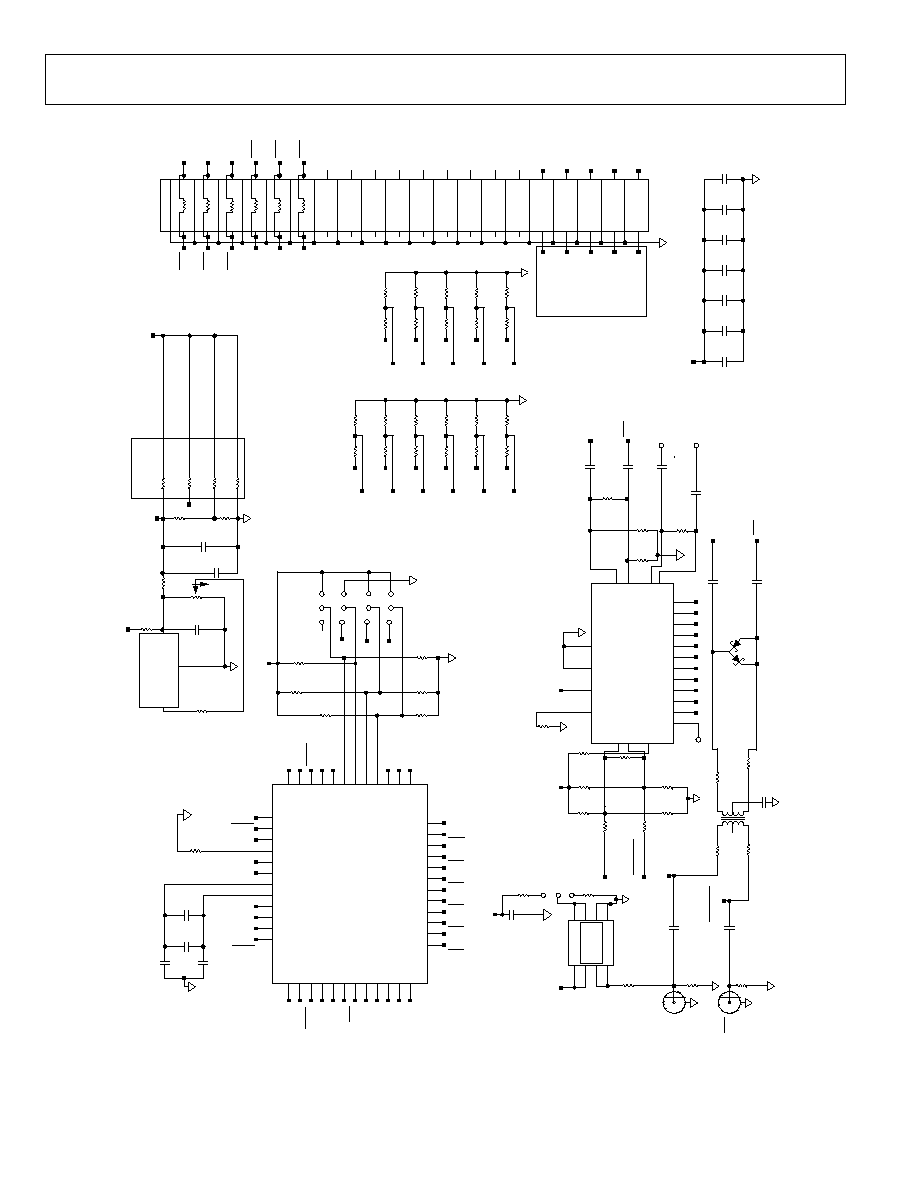
AD9259
Rev. 0 | Page 38 of 52
CS
B
C2
17
0.
1µ
F
C220 0.
1
µ
F
C2
21
0.
1
µ
F
C218 0.
1
µ
F
C2
19
0.
1µ
F
C22
3
0.
1
µ
F
C222 0.
1
µ
F
A
V
D
D_3.
3V
CL
K
CL
KB
GND
GN
D
_
P
A
D
OU
T0
OU
T
0
B
OU
T1
OU
T
1
B
RSE
T
S0
S1
S10
S2
S3
S4
S5
S6
S7
S8
S9
S
Y
NCB
VRE
F
VS
SI
G
N
A
L
= D
N
C
;
2
7
,
2
8
IN
P
U
T
E
NCO
D
E
EN
C
EN
C
DNP
CL
O
CK CI
R
CUI
T
O
P
T
I
O
NA
L
CL
O
CK
DRI
V
E
C
I
RCU
I
T
DI
S
ABL
E
E
N
ABL
E
O
P
T
I
ON
A
L
C
L
OC
K
O
S
CI
L
L
AT
O
R
C2
24
0.
1µ
F
R
214
10
k
R
215
10
k
14
7
8
1
3
5
12
10
O
S
C201
CB3
L
V
-
3
C
C20
7
0.
1
µ
F
DNP
C2
08
0.
1µ
F
DN
P
C
209
0.
1
µ
F
DNP
C215 0.
1
µ
F
DNP
C
211
0.
1
µ
F
C
210
0.
1
µ
F
E
202
1
E2
0
1
P
201
P
203
AV
DD_3
.
3V
12
6
7
25
8
16
9
15
10
14
11
13
18
19
23
22
32
1
31
33
U2
02
S
I
G
NAL
=
AV
DD_
3.
3
V
;
4,
17,
20,
21
,
24,
26,
2
9,
30
A
D
951
5
3
2
1
CR20
1
HS
M
S
28
12
R
220 DNP
R24
0
24
3
R243 100
R24
1
24
3
R24
2
100
6
5
4
3
2
1
T
201
1
2
J2
05
C2
05
0.
1µ
F
C2
16
0.
1µ
F
R213 49.
9
k
R216 0
R2
21
10
k
R2
12
0
DNP
R
219 DNP
S0
S1
S2
S3
S4
S5
S6
S7
S8
S9
S1
0
OP
T_
C
L
K
OP
T_
C
L
K
CL
K
AV
DD_
3.
3
V
OP
T_
C
LK
OP
T_
C
LK
CL
K
CL
K
LV
P
E
C
L
OU
T
P
U
T
LV
D
S
OU
T
P
U
T
CL
K
AV
DD
_3.
3V
1
1
E
203
AV
DD_3
.
3V
VC
C
GN
D
OU
T
OE
OE
'
G
ND'
VC
C
'
OU
T'
R24
4
DNP
R24
5
0
S4
S0
S5
S3
S2
S1
AV
DD_3
.
3V
AV
DD_3
.
3V
AV
DD_3
.
3V
AV
DD_3
.
3V
AV
DD_3
.
3V
AV
DD_3
.
3V
R24
6
DNP
R24
7
0
R24
8
DNP
R24
9
0
R25
0
DNP
R25
1
0
R25
2
DNP
R25
3
0
R25
4
DNP
R25
5
0
R25
6
DNP
R2
57
0
S1
0
S6
S9
S8
S7
AV
DD_
3.
3V
AV
DD_
3.
3V
AV
DD_
3.
3V
AV
DD_
3.
3V
AV
DD_
3.
3V
R25
8
DNP
R2
59
0
R26
0
DNP
R2
61
0
R26
2
DNP
R2
63
0
R26
4
DNP
R2
65
0
A1
A2
A3
A4
A5
A6
A7
A8
A9
G
NDAB1
G
NDA
B1
0
G
NDAB2
G
NDAB3
G
NDAB4
G
NDAB5
G
NDAB6
G
NDAB7
G
NDAB8
G
NDAB9
G
NDCD1
G
NDCD
10
G
NDCD2
G
NDCD3
G
NDCD4
G
NDCD5
G
NDCD6
G
NDCD7
G
NDCD8
G
NDCD9
H
E
A
D
E
R
M
146
916
9_1
R2
05 T
O
R
211
OP
TI
ON
A
L
OU
T
P
U
T
T
E
RM
I
N
AT
I
O
NS
D
I
GI
T
A
L O
U
TPU
T
S
CS
B3_
_CHB
SD
I_
C
H
B
SD
O
_
C
H
A
CS
B2_
CHA
CS
B1_
CHA
S
DI
_
CHA
S
CL
K_
CHA
R206 DNP
R211 DNP
R210 DNP
R209 DNP
R208 DNP
P2
0
2
R207 DNP
SC
L
K
_
C
H
B
DC
O
C10
C9
C8
C7
C6
C5
C4
C3
C2
C1
C10
50
49
48
47
46
45
44
43
42
41
20
19
18
17
16
15
14
13
12
D1
0
D9
D8
D7
D6
D5
D4
D3
D2
D1
B1
0
B9
B8
B7
B6
B5
B4
B3
B2
B1
11
CH
D
CH
C
CH
B
CH
A
FC
O
DC
O
CHD
CHC
CHB
CHA
FC
O
SD
O
_
C
H
B
CS
B4_
CHB
40
60
1
9
21
22
4
5
25
6
26
8
31
32
33
34
35
36
37
38
29
10
30
2
23
3
24
28
51
52
53
54
55
56
57
58
39
59
7
27
O
DM
E
NAB
L
E
CL
K
AV
D
D
CL
K+
CL
K
D+A
D+B
D+C
D+D
DA
DB
DC
DD
DCO
+
DCO
DRG
ND
DRV
DD
FCO+
FCO
PD
W
N
RBIAS
REF
B
REF
T
SC
L
K
/
D
T
P
SD
I
O
/
O
D
M
SENSE
VI
N
+
A
VIN
+B
VIN
+C
VIN
+
D
VI
N
A
VINB
VINC
VIN
D
VREF
AV
D
D
AV
D
D
AV
D
D
AV
D
D
AV
D
D
AVD
D
AV
DD
AV
DD
AV
DD
AV
DD
AVDD
AVDD
DR
V
D
D
DRG
N
D
RE
F
E
RE
NCE
DE
CO
UP
L
I
NG
C
204
0.
1
µ
F
C2
03
0.
1
µ
F
C
202
2.
2
µ
F
C
201
0.
1
µ
F
R205
10k
R203
100k
R204
100k
3
2
1
J
201
1
8
73
0
20
18
16
14
19
17
15
13
24
23
11
12
22
21
10
2
25
26
27
32
35
36
39
45
46
5
6
9
31
40
43
44
28
29
41
33
38
47
4
34
37
48
3
42
U
201
A
D925
9 L
F
CS
P
R202 100
k
CS
B_DU
T
1
2
3
J
202
SD
I
O
_
O
D
M
1
2
3
J
2
0
3
S
C
L
K
_
D
T
P
3
2
1
J
2
0
4
G
N
D
G
N
D
R
2
0
1
1
0
k
AVDD
_DU
T
CHA
CHB
CHC
CHD
CHA
CHB
CHC
DCO
DCO
FCO
FCO
A
V
D
D
_
D
U
T
A
V
D
D
_
D
U
T
A
V
D
D
_
D
U
T
AVDD
_DU
T
AVDD
_DU
T
VSENSE_
DU
T
V
I
N
_
A
VIN
_B
VIN
_C
V
I
N
_
A
VIN_B
VREF
_D
UT
A
V
D
D
_
D
U
T
A
V
D
D
_
D
U
T
C
L
K
CHD
A
V
D
D
_
D
U
T
A
V
D
D
_
D
U
T
A
V
D
D
_
D
U
T
A
V
D
D
_
D
U
T
A
V
D
D
_
D
U
T
V
I
N
_
D
VIN_C
V
I
N
_
D
D
R
V
D
D
_
D
U
T
D
R
V
D
D
_
D
U
T
A
V
D
D
_
D
U
T
P
W
D
N
E
N
A
B
L
E
A
L
W
A
Y
S
E
N
A
B
L
E
S
P
I
D
T
P
E
N
A
B
L
E
U
2
0
3
CW
V
R
E
F
=
1
V
V
R
E
F
=
E
X
T
E
R
N
A
L
V
R
E
F
=
0
.
5
V
R
E
M
O
V
E
C
2
1
4
W
H
E
N
U
S
I
N
G
E
X
T
E
R
N
A
L
V
R
E
F
V
R
E
F
=
0
.
5
V
(
1
+
R
2
3
2
/
R
2
3
3
)
V
R
E
F
S
E
L
E
C
T
R
E
F
E
R
E
N
C
E
C
I
R
C
U
I
T
C
2
1
2
0
.
1
µ
F
R
2
2
9
4
.
9
9
k
C
2
1
4
1
µ
F
C
2
1
3
0
.
1
µ
F
R
2
3
0
1
0
k
R
2
3
1
D
N
P
D
N
P
V
S
E
N
S
E
_
D
U
T
R
2
2
8
4
7
0
k
D
N
P
D
N
P
R
2
3
4
D
N
P
R
2
3
5
D
N
P
R
2
3
6
D
N
P
R
2
3
7
0
D
N
P
A
V
D
D
_
D
U
T
V
R
E
F
_
D
U
T
AVDD_DUT
T
R
I
M
/
N
C
GND
V
O
U
T
A
D
R
5
1
0
/
2
0
1
V
R
2
3
2
D
N
P
R
2
3
3
D
N
P
R
2
1
7
0
R
2
1
8
0
R
2
2
5
0
D
N
P
R
2
2
6
4
9
.
9
D
N
P
R
2
2
7
0
D
N
P
R
2
3
8
D
N
P
R
2
3
9
1
0
k
C
2
0
6
0
.
1
µ
F
R
2
2
3
0
R
2
2
4
0
R
2
2
2
4
.
0
2
k
2
3
5
N
C
=
N
O
C
O
N
N
E
C
T
R266
100k
-
DN
P
R267
100k
-
DN
P
C
L
I
P
S
I
N
E
O
U
T
(
D
E
F
A
U
L
T
)
D
N
P
:
D
O
N
O
T
P
O
P
U
L
A
T
E
O
P
T
I
O
N
A
L
E
X
T
R
E
F
059
65-
01
6
Figure 64. Evaluation Board Schematic, DUT, VREF, Clock Inputs, and Digital Output Interface
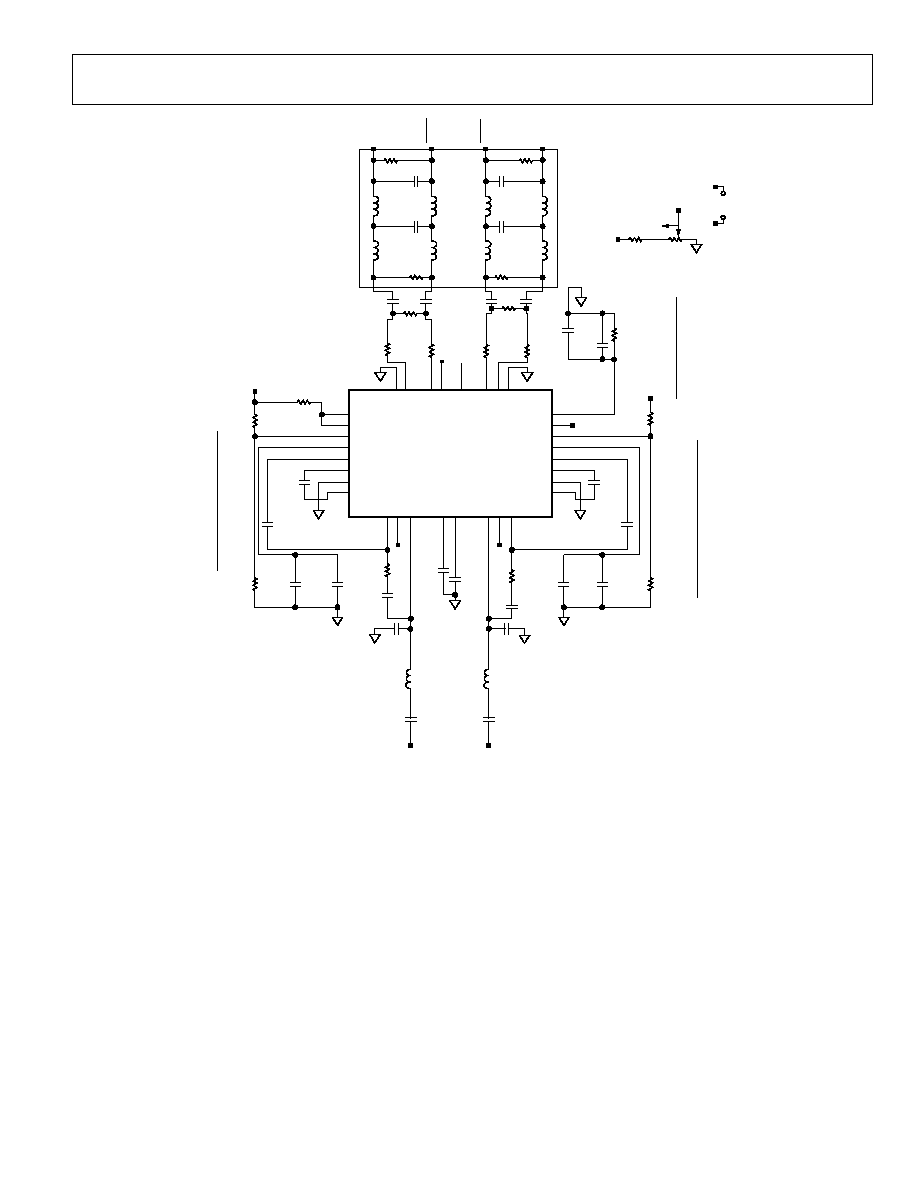
AD9259
Rev. 0 | Page 39 of 52
CW
P
O
W
E
R DO
W
N
E
NABL
E
(
0
V T
O
1
V
=
D
I
SA
B
L
E P
O
W
ER
)
EXTERNAL VARIABLE GAIN DRIVE
VARIABLE GAIN CIRCUIT
(0V TO 1.0V DC)
R319
10k
12
JP
301
GND
VG
R320
39k
VG
AVDD_5V
HI
L
O
P
I
N
HI
G
A
I
N
RANG
E
=
2
.
25V
T
O
5.
0V
L
O
G
A
I
N
RANG
E
=
0V
T
O
1.
0V
R315
10k
L310
120nH
C322
0.018µF
C317
0.018µF
R316
274
R317
274
C312
0.1µF
C325
0.1µF
C313
0.1µF
C314
0.1µF
L309
120nH
C318
22pF
C321
0.1µF
C320
0.1µF
C316
0.1µF
R318
10k
C323
22pF
C319
0.1µF
C324
0.1µF
INH4
INH3
A
V
DD_5V
A
V
DD_5V
C326
10µF
C315
10µF
O
P
T
I
O
NAL
V
G
A DRI
V
E
CI
RCUI
T
F
O
R CHANN
E
L
S
C AND D
C311
0.1µF
R312
10k
R313
10k
DNP
C303
DNP
L304
0
R303
DNP
L308
0
24
17
20
23
18
22
19
21
R304
DNP
L306
0
L305
0
L302
0
L303
0
L307
0
C308
0.1µF
C307
0.1µF
C306
0.1µF
C305
0.1µF
R310
187
R309
187
R308
187
R307
187
C302
DNP
L301
0
C301
DNP
R305
374
R306
374
CH_C
CH_D
CH_D
CH_C
A
V
DD_5V
AV
DD_5V
AV
DD
_5
V
C304
DNP
R301
DNP
R302
DNP
31
10
26
25
14
27
3
6
4
5
1
8
32
9
15
16 VG
28
13
29
12
30
11
2
7
COM1
COM2
ENBL
ENBV
GAIN
HILO
I
NH1
I
NH2
LMD
1
LMD
2
LO
N
1
LO
N
2
LOP1
LOP2
MODE
NC
RCLMP
VCM1
VCM2
VIN1
VIN2
VIP1
VIP2
VO
H
1
VO
H
2
VO
L
1
VO
L
2
VP
S
1
VP
S2
VP
S
V
AD8332
CO
M
M
CO
M
M
R311
10k
DNP
R314
10k
DNP
C310
0.1µF
C309
1000pF
RC
L
AM
P
P
I
N
HI
L
O
P
I
N =
L
O
=
±50
m
V
HI
L
O
P
I
N =
H =
±7
5m
V
MO
D
E
PIN
PO
SI
T
I
V
E G
A
I
N
SL
O
PE =
0
V
T
O
1
.
0
V
N
EG
A
T
I
VE G
A
I
N
SL
O
PE =
2
.
2
5
V T
O
5
.
0
V
U301
POPULATE L301 TO L308 WITH
0 RESISTORS OR DESIGN
YOUR OWN FILTER.
DNP: DO NOT POPULATE
05
96
5-
0
17
Figure 65. Evaluation Board Schematic, Optional DUT Analog Input Drive
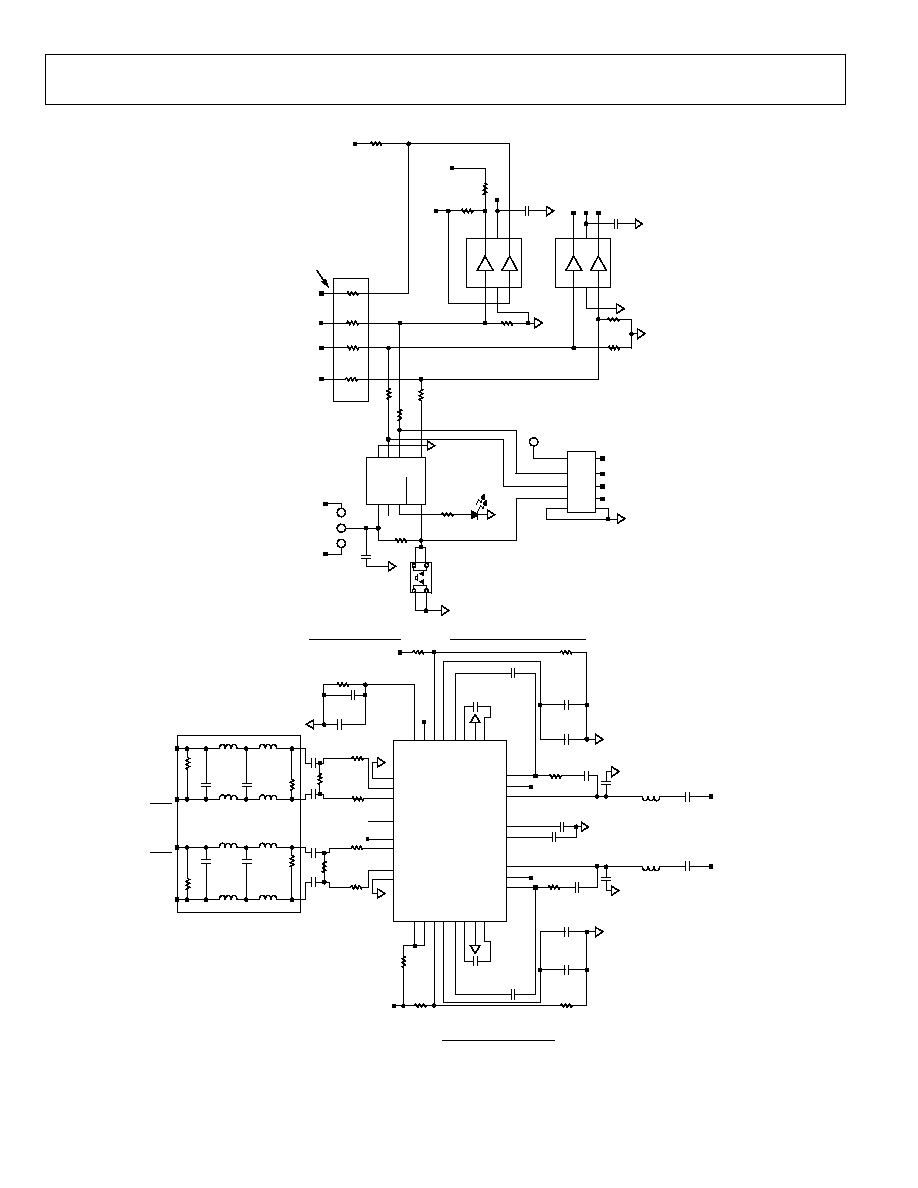
AD9259
Rev. 0 | Page 40 of 52
MOD
EPI
N
POSI
TIVE G
AIN
SLO
PE=
0V
TO
1.0
V
NEG
AT
IVE G
AIN
SLO
PE=
2.2
5V-5
.0V
HIL
OP
IN
HI G
AIN
RAN
GE
=2.
25V
-5.
0V
LO
GAI
NRA
NGE
=0V
TO
1.0V
R41
4
10
k
L4
1
0
120
n
H
C420
0.018
µF
C4
15
0.
01
8µ
F
R4
15
27
4
C41
0
0.
1µ
F
C
425
0.
1µ
F
C4
23
0.
1
µ
F
C
424
0.
1µ
F
L4
0
9
1
20n
H
C
418
22p
F
C41
7
0.
1µ
F
C41
6
0.
1µ
F
C41
4
0.
1
µ
F
R
417
10
k
C4
21
22p
F
C4
19
0.
1µ
F
C4
22
0.
1µ
F
I
NH2
I
NH1
AVDD_
5V
AVDD_
5V
C4
26
10
µ
F
C4
13
10µ
F
OPT
ION
AL
VG
AD
RIV
ECI
RCUI
TF
OR
CHAN
NEL
SA
ANDB
C
409
0.
1µ
F
R4
11
10
k
R
412
10
k
DN
P
C
403
DNP
L
404 0
R4
03
DN
P
L
408 0
24
17
20
23
18
22
19
21
R
404
DNP
L4
0
6
0
L
405
0
L4
0
2
0
L4
0
3
0
L4
0
7
0
C
408
0.
1µ
F
C
407
0.
1µ
F
C40
6
0.
1µ
F
C
405
0.
1µ
F
R4
10
18
7
R40
9
187
R
408
18
7
R40
7
18
7
C402 DN
P
L
401
0
C4
01
DNP
R4
05
374
R
406
37
4
CH_A
CH_B
CH_B
CH_A
AVD
D_5V
AVD
D_5V
AVD
D_5V
C
404
DN
P
R4
01
DNP
R40
2
DNP
31
10
26
25
14
27
3
6
4
5
1
8
32
9
15
16
VG
28
13
29
12
30
11
2
7
CO
M
1
CO
M
2
EN
B
L
EN
B
V
GA
IN
HI
L
O
INH
1
INH
2
LMD
1
LMD
2
LON
1
LON
2
LOP
1
LOP
2
MO
D
E
NC
RC
L
M
P
VC
M1
VC
M2
VI
N
1
VI
N
2
VI
P1
VI
P2
VOH
1
VOH
2
VOL
1
VOL
2
VPS1
VPS2
VPSV
A
D
83
32
U
401
COM
M
COM
M
R41
3
10k
DNP
R4
24
10
k
DN
P
C
412
0.
1µ
F
C41
1
100
0p
F
RCL
AM
PP
IN
HILO
PIN
=LO
=±
50m
V
HIL
OP
IN
=H
=±
75m
V
PO
WE
RD
OW
NE
NA
BL
E
(0V
TO
1V
=D
IS
AB
LE
PO
WE
R)
R416
274
PO
PU
LATE
L401
TOL4
08
WITH
0
RESI
STO
RS
OR
DESI
GN
YO
URO
WN
FIL
TE
R.
Y1
VC
C Y2
A2
GN
D
A1
S
P
I
CI
RCU
I
T
R
Y
F
R
O
M
F
I
F
O
SD
I
O
_
O
D
M
AV
D
D_D
UT
R
431 1k
R4
32
1k
R43
3
1k
AV
D
D_3
.
3
V
1
2
34
5
6
NC7
W
Z
0
7
U4
03
R42
5
10k
AV
D
D_D
UT
RE
SET/
R
E
PR
O
G
R
A
M
1
2
3
4
S4
0
1
+
3
.
3
V
=
NO
RM
A
L
O
P
E
R
AT
I
O
N
=
AV
D
D_3
.
3
V
+5
V
= P
R
O
G
R
A
MMI
N
G
=
A
V
D
D
_
5
V
AV
D
D_5
V
A
V
DD
_3.
3V
J
402
C4
27
0.
1µ
F
R418
4.75k
P
I
C1
2F
629
R
419
26
1
4
3
1
2
5
6
8
7
U4
02
CR4
01
GP
0
GP
1
GP
2
GP
4
GP
5
VD
D
VS
S
MC
L
R
/
GP
3
R
EMO
VE W
H
EN
U
SI
N
G
OR
P
R
OGR
A
M
M
IN
G P
I
C
(
U
4
0
2
)
R427
0
R420
0
R428
0
R426
0
SDO
_C
HA
SDI_
CH
A
SCL
K_CHA
CSB1
_CHA
C42
9
0.
1µ
F
S
C
LK
_
D
TP
CS
B
_
DU
T
AV
D
D_D
UT
Y1
VC
C Y2
A2
GN
D
A1
1
2
34
5
6
U
404
R
430
10k
R42
9
10k
NC7
W
Z
1
6
C4
28
0.
1µ
F
PIC PROGRAMMING HEADER
MCLR/GP3
GP0
GP1
PICVCC
MCLR/GP3
GP0
GP1
PICVCC
9
7
5
3
1
10
8
6
4
2
J401
E4
0
1
R4
21
0
, D
N
P
R
423
0
,
DNP
R
422
0
,
DNP
OPTIONAL
D
N
P: D
O
N
O
T
PO
PU
L
A
T
E
0
59
65-
0
18
Figure 66. Evaluation Board Schematic, Optional DUT Analog Input Drive and SPI Interface (Continued)

AD9259
Rev. 0 | Page 41 of 52
M
O
UN
T
I
NG
HO
L
E
S
CO
NNE
CT
E
D T
O
G
RO
UN
D
H2
H3
H1
H4
P1
P2
P3
P4
P5
P6
P7
P8
OP
T
ION
A
L
P
O
WE
R
IN
P
U
T
+5
.
0
V
+1
.
8
V
+1
.
8
V
+3
.
3
V
1
2
3
4
5
6
7
8
P
501
3.
3V
_
A
V
D
D
5V
_AV
D
D
L
502
10
µ
H
DUT
_AV
D
D
DUT
_DRV
DD
C509 0.
1µ
F
C50
8
10
µ
F
L
503
10µ
H
L
501
10µ
H
D
R
V
DD_DU
T
A
V
DD_DUT
0.
1
µ
F
C50
5
0.
1µ
F
C507
C50
3
0.
1
µ
F
A
V
DD_5V
10µ
F
C5
0
4
C5
0
2
10µ
F
10
µ
F
C50
6
A
V
DD_3.
3V
10µ
H
L5
0
8
DE
CO
UP
L
I
NG
C
AP
ACI
T
O
RS
AV
DD_3.
3V
0.
1
µ
F
C524
0.
1µ
F
C525
C521 0.
1
µ
F
C531 0.
1µ
F
C530 0.
1µ
F
C5
2
9
0.
1µ
F
C5
2
2
0.
1µ
F
C52
8
0.
1
µ
F
C527 0.
1
µ
F
C52
6
0.
1
µ
F
0.
1µ
F
C5
1
7
0.
1µ
F
C516
C518 0.
1µ
F
C5
2
0
0.
1µ
F
C519 0.
1µ
F
C523 0.
1µ
F
DRV
DD
_
D
UT
AV
D
D
_DUT
AV
DD_5V
S
M
DC110F
PO
W
ER
S
U
PPL
Y I
N
PU
T
6V,
2
V
MA
XI
MU
M
1
3
2
P
503
C501
10
µ
F
F
501
D502 3A SH
O
T
_
R
E
C
T
DO
-
214
A
B
D501 S
2
A_RE
CT
2A DO
-
2
14AA
2
1
3
4
F
E
R501
CHO
KE
_CO
I
L
CR501
R501 261
PWR
_
I
N
+
GND
IN
P
U
T
OU
TP
U
T
1
GND
IN
P
U
T
OU
TP
U
T
1
OU
TP
U
T
4
OU
TP
U
T
4
GND
IN
P
U
T
GND
IN
P
U
T
D
N
P:
D
O
N
O
T
PO
PU
L
A
T
E
4
2
3
1
A
D
P
3333
9AK
C
-
5
U50
4
4
2
3
1
AD
P
333
39AKC
-
3
.
3
U502
1
32
4
U501
A
D
P
3333
9AK
C
-
1
.
8
1
32
4
U503
A
D
P
3333
9AK
C
-
1
.
8
L
505
10µ
H
10
µ
H
L
504
C5
1
5
1µ
F
C513 1µ
F
C512
1µ
F
C514
1µ
F
PW
R
_
I
N
PW
R
_
I
N
D
UT
_
AV
DD
DU
T
_
DRV
DD
5V
_AV
D
D
3.
3V
_
A
V
D
D
PW
R
_
I
N
PW
R
_
I
N
C53
2
1µ
F
C53
4
1µ
F
C53
5
1µ
F
C533 1µ
F
L
507
10µ
H
L
506
10µ
H
OU
TP
U
T
1
OU
T
P
U
T
1
OU
TP
U
T
4
OU
T
P
U
T
4
0
59
65
-
01
9
Figure 67. Evaluation Board Schematic, Power Supply Inputs

AD9259
Rev. 0 | Page 42 of 52
05
96
5-
02
0
Figure 68. Evaluation Board Layout, Primary Side
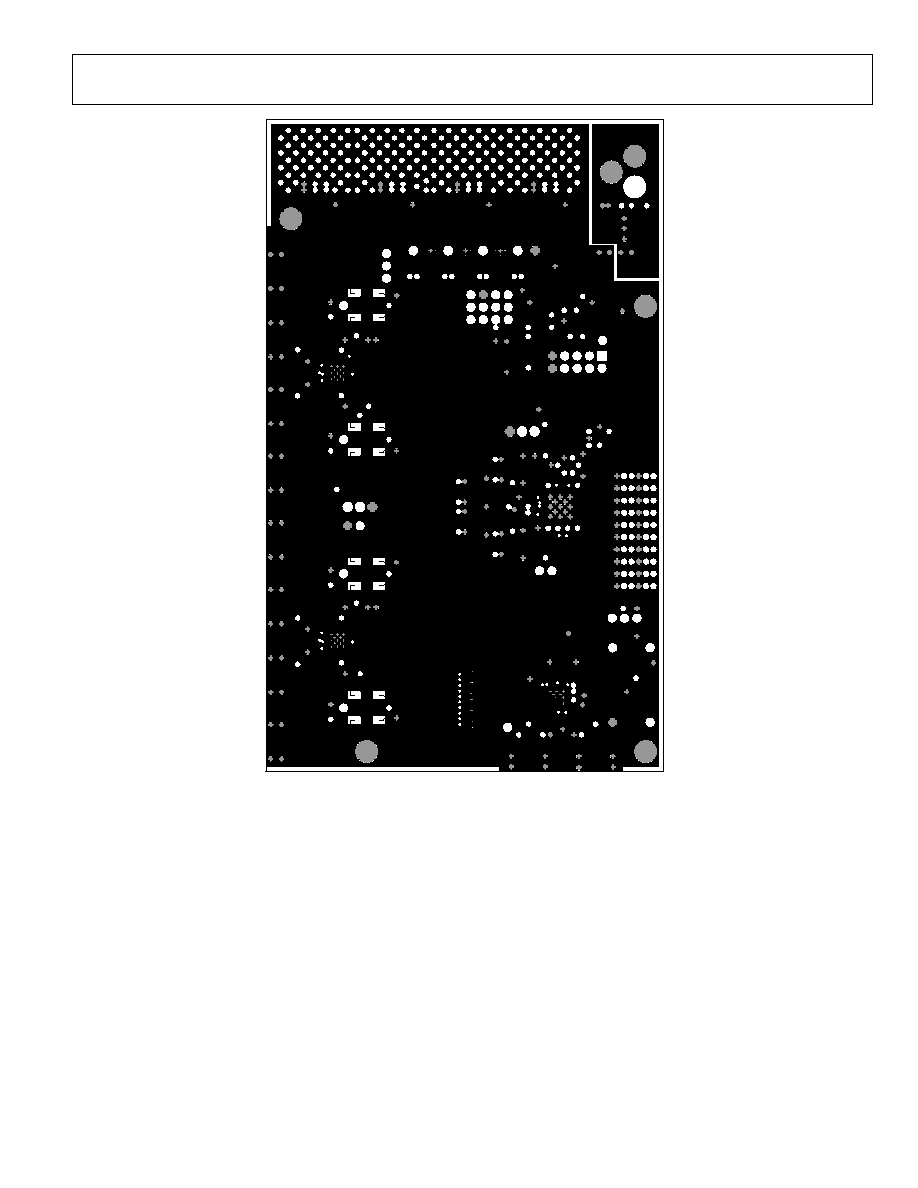
AD9259
Rev. 0 | Page 43 of 52
05
96
5-
0
21
Figure 69. Evaluation Board Layout, Ground Plane
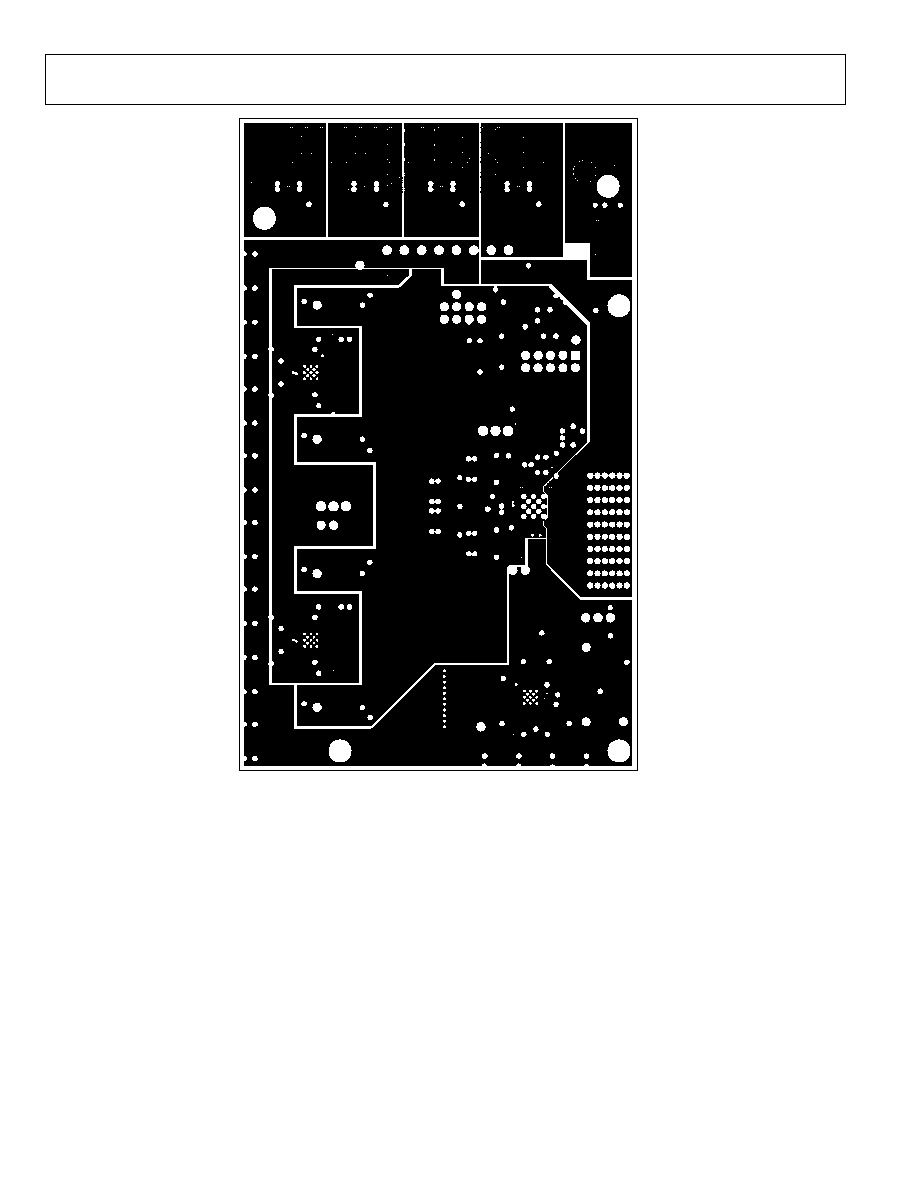
AD9259
Rev. 0 | Page 44 of 52
05
96
5-
0
22
Figure 70. Evaluation Board Layout, Power Plane

AD9259
Rev. 0 | Page 45 of 52
05
96
5-
0
23
Figure 71. Evaluation Board Layout, Secondary Side (Mirrored Image)

AD9259
Rev. 0 | Page 46 of 52
Table 16. Evaluation Board Bill of Materials (BOM)
Item
Qnty.
per
Board REFDES
Device
Pkg.
Value
Mfg.
Mfg.
Part
Number
1 1 AD9259LFCSP_REVA
PCB
PCB PCB
2 75 C101, C102, C107,
C108, C109, C114,
C115, C116, C121,
C122, C123, C128,
C201, C203, C204,
C205, C206, C210,
C211, C212, C213,
C216, C217, C218,
C219, C220, C221,
C222, C223, C224,
C310, C311, C312,
C313, C314, C316,
C319, C320, C321,
C324, C325, C409,
C410, C412, C414,
C416, C417, C419,
C422, C423, C424,
C425, C427, C428,
C429, C503, C505,
C507, C509, C516,
C517, C518, C519,
C520, C521, C522,
C523, C524, C525,
C526, C527, C528,
C529, C530, C531
Capacitor 402 0.1 F, ceramic,
X5R, 10 V, 10% tol
Panasonic ECJ-0EB1A104K
3 4 C104, C111, C118,
C125
Capacitor 402 2.2 pF, ceramic,
COG, 0.25 pF tol,
50 V
Murata GRM1555C1H2R2GZ01B
4 4 C315, C326, C413,
C426
Capacitor 805 10 F, 6.3 V ±10%
ceramic, X5R
AVX 08056D106KAT2A
5 1 C202
Capacitor 603 2.2 F, ceramic,
X5R, 6.3 V, 10% tol
Panasonic ECJ-1VB0J225K
6 2 C309,
C411
Capacitor 402 1000 pF, ceramic,
X7R, 25 V, 10% tol
Kemet C0402C102K3RACTU
7 4 C317, C322, C415,
C420
Capacitor 402 0.018 F, ceramic,
X7R, 16 V, 10% tol
AVX 0402YC183KAT2A
8 4 C318, C323, C418,
C421
Capacitor 402 22 pF, ceramic,
NPO, 5% tol, 50 V
Kemet C0402C220J5GACTU
9 1 C501
Capacitor 1206 10 F, tantalum,
16 V, 20% tol
Rohm TCA1C106M8R
10 9
C214, C512, C513,
C514, C515, C532,
C533, C534, C535
Capacitor 603 1 F, ceramic, X5R,
6.3 V, 10% tol
Panasonic ECJ-1VB0J105K
11 8
C305, C306, C307,
C308, C405, C406,
C407, C408
Capacitor 805 0.1 F, ceramic,
X7R, 50 V, 10% tol
AVX 08055C104KAT2A
12 4
C502, C504, C506,
C508
Capacitor 603 10 F, ceramic,
X5R, 6.3 V, 20% tol
Panasonic ECJ-1VB0J106M
13 1
CR201
Diode
SOT-23 30 V, 20 mA, dual
Schottky
Agilent
Technologies
HSMS2812
14 2
CR401,
CR501
LED
603
Green, 4 V, 5 m
candela
Panasonic LNJ306G8TRA
15
1
D502
Diode
DO-214AB
3 A, 30 V, SMC
Micro
Commercial Co.
SK33MSCT
16
1
D501
Diode
DO-214AA
2 A, 50 V, SMC
Micro
Commercial Co.
S2A

AD9259
Rev. 0 | Page 47 of 52
Item
Qnty.
per
Board REFDES
Device
Pkg.
Value
Mfg.
Mfg.
Part
Number
17 1
F501
Fuse
1210 6.0 V, 2.2 A trip-
current resettable
fuse
Tyco/Raychem NANOSMDC110F-2
18 1
FER501
Choke
Coil 2020 10 H, 5 A, 50 V,
190 @ 100 MHz
Murata DLW5BSN191SQ2L
19 12 FB101, FB102, FB103,
FB104, FB105, FB106,
FB107, FB108, FB109,
FB110, FB111, FB112
Ferrite bead
603
10 , test freq
100 MHz, 25% tol,
500 mA
Murata BLM18BA100SN1
20 1
JP301
Connector 2-pin 100 mil header
jumper, 2-pin
Samtec TSW-102-07-G-S
21 2
J205,
J402
Connector 3-pin 100 mil header
jumper, 3-pin
Samtec TSW-103-07-G-S
22
1
J201 to J204
Connector
12-pin
100 mil header
male, 4 × 3 triple
row straight
Samtec TSW-104-08-G-T
23 1
J401
Connector 10-pin 100 mil header,
male, 2 × 5 double
row straight
Samtec TSW-105-08-G-D
24 8
L501, L502, L503, L504,
L505, L506, L507, L508
Ferrite bead
1210
10 H, bead core
3.2 × 2.5 × 1.6
SMD, 2 A
Panasonic-ECG EXC-CL3225U1
25
4
L309, L310, L409, L410
Inductor
402
120 nH, test freq
100 MHz, 5% tol,
150 mA
Murata LQG15HNR12J02B
26 16 L301, L302, L303, L304,
L305, L306, L307, L308,
L401, L402, L403, L404,
L405, L406, L407, L408
Resistor
805
0 , 1/8 W, 5% tol
Panasonic
ERJ-6GEY0R00V
27 1
OSC201
Oscillator
SMT
Clock oscillator,
50.00 MHz, 3.3 V
CTS REEVES
CB3LV-3C-50M0000-T
28 5
P101, P103, P105,
P107, P201
Connector SMA Side-mount SMA
for 0.063" board
thickness
Johnson
Components
142-0711-821
29 1
P202
Connector HEADER
1469169-1, right
angle 2-pair,
25 mm, header
assembly
Tyco 1469169-1
30 1
P503
Connector 0.1",
PCMT
RAPC722, power
supply connector
Switchcraft SC1153
31 15 R201, R205, R214,
R215, R221, R239,
R312, R315, R318,
R411, R414, R417,
R425, R429, R430
Resistor 402 10 k, 1/16 W,
5% tol
Panasonic ERJ-2GEJ103X
32 14 R103, R117, R129,
R142, R216, R217,
R218, R223, R224,
R237, R420, R426,
R427, R428
Resistor 402 0 , 1/16 W,
5% tol
Panasonic ERJ-2GE0R00X
33 4
R102, R115, R128,
R141
Resistor 402 64.9 , 1/16 W,
1% tol
Panasonic ERJ-2RKF64R9X
34 4
R104, R116, R130,
R143
Resistor 603 0 , 1/10 W,
5% tol
Panasonic ERJ-3GEY0R00V
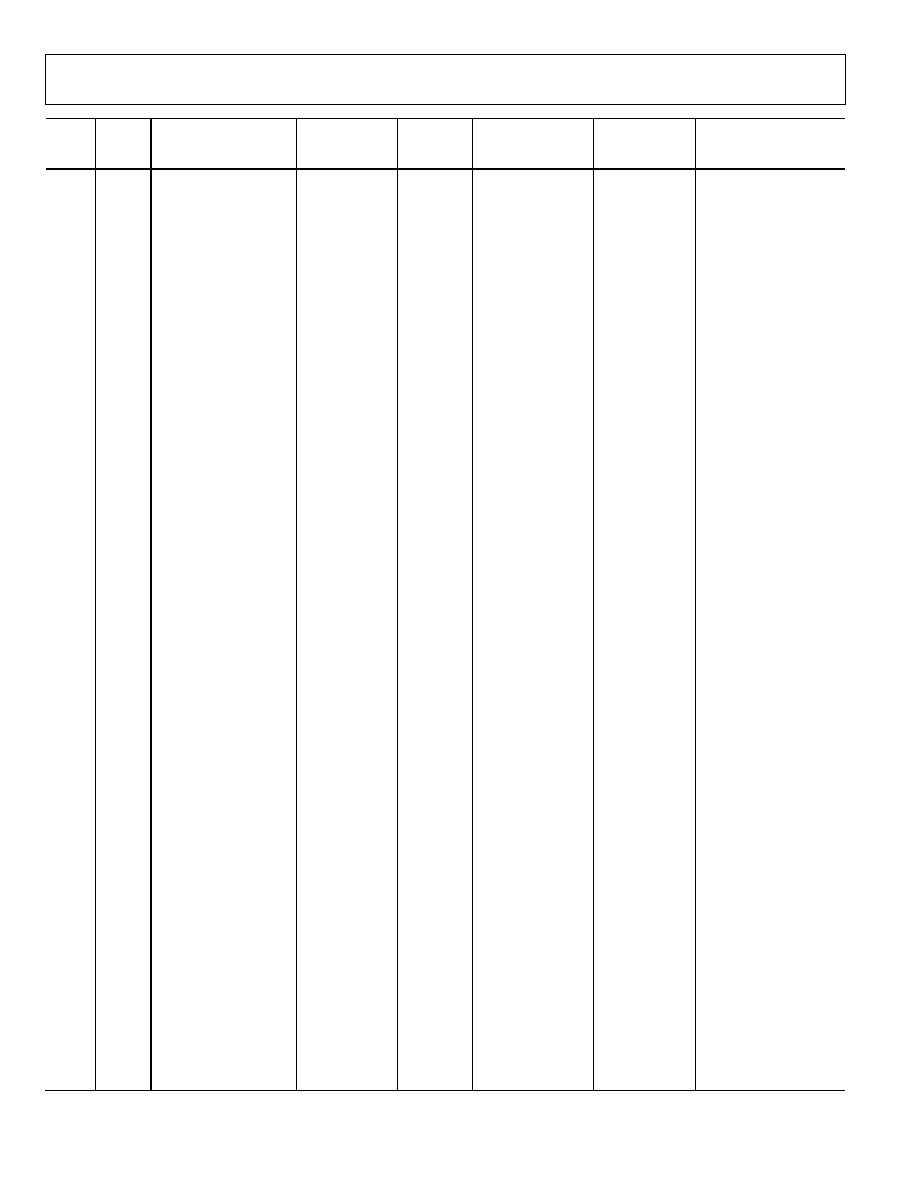
AD9259
Rev. 0 | Page 48 of 52
Item
Qnty.
per
Board REFDES
Device
Pkg.
Value
Mfg.
Mfg.
Part
Number
35 15 R109, R111, R112,
R123, R125, R126,
R135, R138, R139,
R148, R149, R150,
R431, R432, R433
Resistor 402 1 k, 1/16 W,
1% tol
Panasonic ERJ-2RKF1001X
36 8
R108, R110, R121,
R122, R134, R136,
R146, R147
Resistor 402 33 , 1/16 W, 5%
tol
Panasonic ERJ-2GEJ330X
37 4
R161, R162, R163,
R164
Resistor 402 499 , 1/16 W,
1% tol
Panasonic ERJ-2RKF4990X
38 3
R202,
R203,
R204
Resistor
402
100 k, 1/16 W,
1% tol
Panasonic ERJ-2RKF1003X
39 1
R222
Resistor
402
4.02 k, 1/16 W,
1% tol
Panasonic ERJ-2RKF4021X
40 1
R213
Resistor
402
49.9 , 1/16 W,
0.5% tol
Susumu RR0510R-49R9-D
41 1
R229
Resistor
402
4.99 k, 1/16 W,
5% tol
Panasonic ERJ-2RKF4991X
42 2
R230,
R319
Potentiometer
3-lead 10 k, Cermet
trimmer
potentiometer,
18 turn top adjust,
10%, 1/2 W
BC
Components
CT-94W-103
43 1
R228
Resistor
402
470 k, 1/16 W,
5% tol
Yageo America
9C04021A4703JLHF3
44 1
R320
Resistor
402
39 k, 1/16 W,
5% tol
Susumu RR0510P-393-D
45 8
R307, R308, R309,
R310, R407, R408,
R409, R410
Resistor 402 187 , 1/16 W,
1% tol
Panasonic ERJ-2RKF1870X
46 4
R305, R306, R405,
R406
Resistor 402 374 , 1/16 W,
1% tol
Panasonic ERJ-2RKF3740X
47 4
R316, R317, R415,
R416
Resistor 402 274 , 1/16 W,
1% tol
Panasonic ERJ-2RKF2740X
48 11 R245, R247, R249,
R251, R253, R255,
R257, R259, R261,
R263, R265
Resistor
201
0 , 1/20 W, 5% tol
Panasonic
ERJ-1GE0R00C
49 4
R418
Resistor
402
4.75 k, 1/16 W,
1% tol
Panasonic ERJ-2RKF4751X
50 1
R419
Resistor
402
261 , 1/16 W,
1% tol
Panasonic ERJ-2RKF2610X
51 1
R501
Resistor
603
261 , 1/16 W,
1% tol
Panasonic ERJ-3EKF2610V
52 2
R240,
R241
Resistor
402
243 , 1/16 W,
1% tol
Panasonic ERJ-2RKF2430X
53 2
R242,
R243
Resistor
402
100 , 1/16 W,
1% tol
Panasonic ERJ-2RKF1000X
54 1
S401
Switch
SMD
LIGHT TOUCH,
100GE, 5 mm
Panasonic EVQ-PLDA15
55 5
T101, T102, T103, T104,
T201
Transformer CD542 ADT1-1WT, 1:1
impedance ratio
transformer
Mini-Circuits ADT1-1WT
56 2
U501,
U503
IC
SOT-223
ADP33339AKC-1.8,
1.5 A, 1.8 V LDO
regulator
ADI ADP33339AKC-1.8
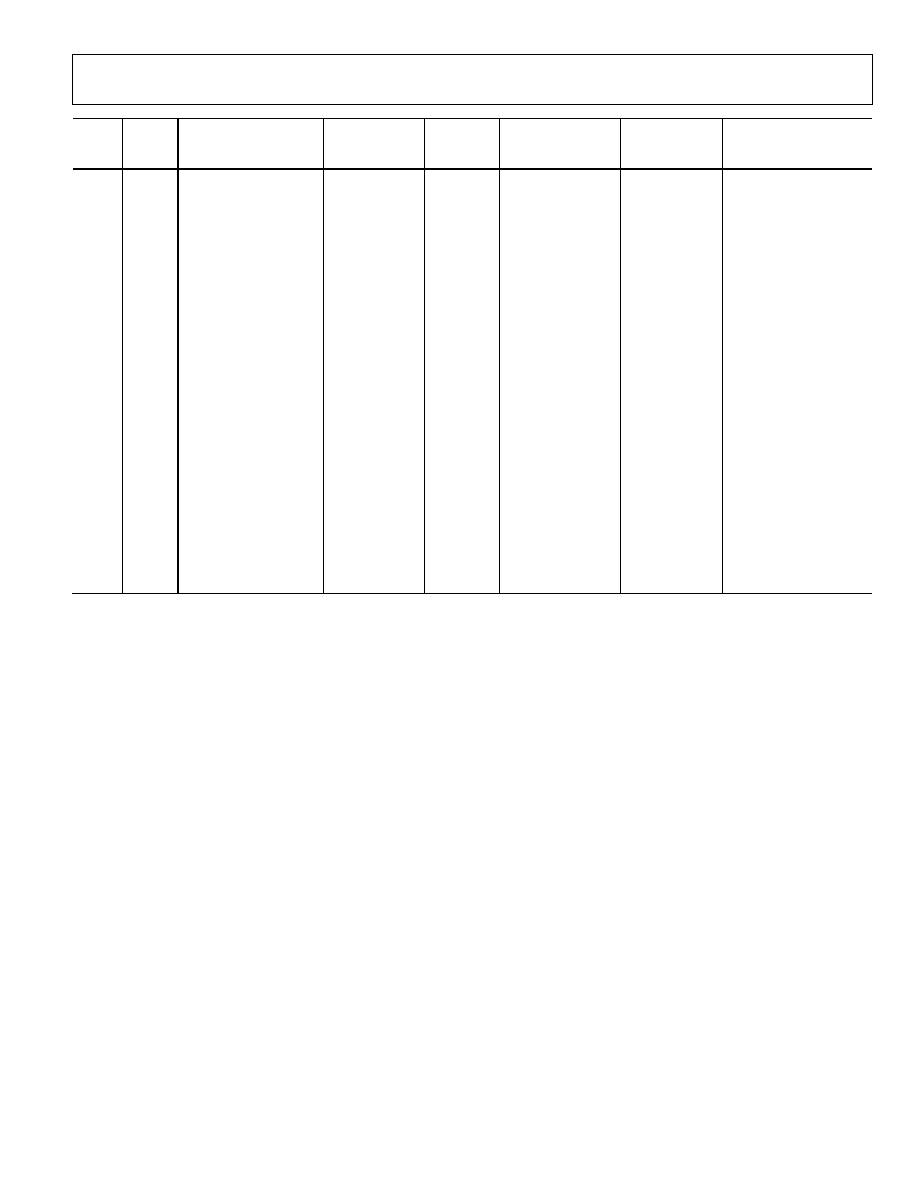
AD9259
Rev. 0 | Page 49 of 52
Item
Qnty.
per
Board REFDES
Device
Pkg.
Value
Mfg.
Mfg.
Part
Number
57 2
U301,
U401
IC
LFCSP,
CP-32
AD8332ACP,
ultralow noise
precision dual
VGA
ADI AD8332ACP
58 1
U504
IC
SOT-223
ADP33339AKC-5
ADI
ADP33339AKC-5
59 1
U502
IC
SOT-223
ADP33339AKC-3.3
ADI
ADP33339AKC-3.3
60 1
U201
IC
LFCSP,
CP-48-1
AD9259-50, quad,
14-bit, 50 MSPS
serial LVDS 1.8 V
ADC
ADI AD9259BCPZ-50
61 1
U203
IC
SOT-23 ADR510AR, 1.0 V,
precision low
noise shunt
voltage reference
ADI ADR510AR
62 1
U202
IC
LFCSP
CP-32-2
AD9515 ADI AD9515BCPZ
63 1
U403
IC
SC70,
MAA06A
NC7WZ07 Fairchild
NC7WZ07P6X
64 1
U404
IC
SC70,
MAA06A
NC7WZ16 Fairchild
NC7WZ16P6X
65 1
U402
IC
8-SOIC Flash prog
mem 1kx14,
RAM size 64 × 8,
20 MHz speed,
PIC12F controller
series
Microchip PIC12F629-I/SN
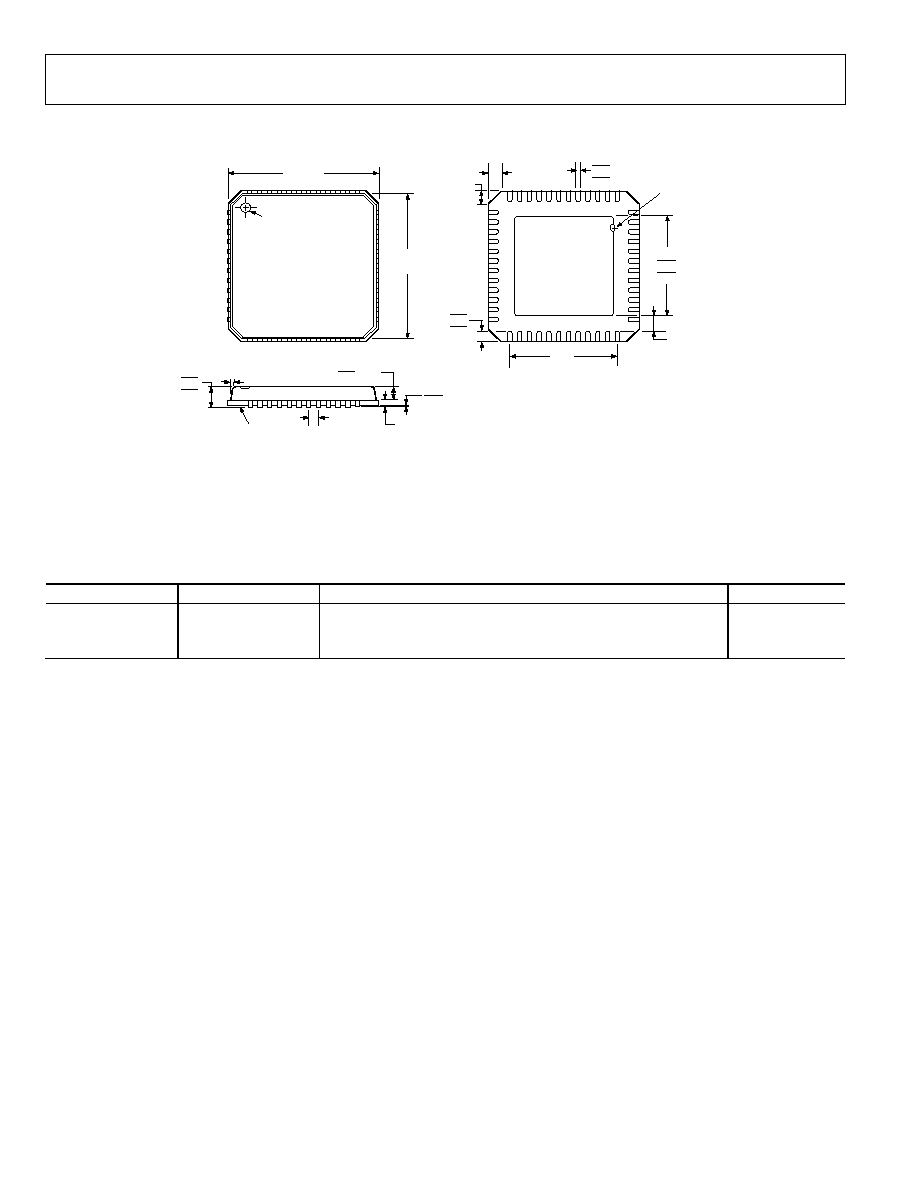
AD9259
Rev. 0 | Page 50 of 52
OUTLINE DIMENSIONS
PIN 1
INDICATOR
TOP
VIEW
6.75
BSC SQ
7.00
BSC SQ
1
48
12
13
37
36
24
25
5.25
5.10 SQ
4.95
0.50
0.40
0.30
0.30
0.23
0.18
0.50 BSC
12° MAX
0.20 REF
0.80 MAX
0.65 TYP
1.00
0.85
0.80
5.50
REF
0.05 MAX
0.02 NOM
0.60 MAX
0.60 MAX
PIN 1
INDICATOR
COPLANARITY
0.08
SEATING
PLANE
0.25 MIN
EXPOSED
PAD
(BOTTOM VIEW)
COMPLIANT TO JEDEC STANDARDS MO-220-VKKD-2
Figure 72. 48-Lead Lead Frame Chip Scale Package [LFCSP_VQ]
7 mm × 7 mm Body, Very Thin Quad
(CP-48-1)
Dimensions shown in millimeters
ORDERING GUIDE
Model
Temperature Range
Package Description
Package Option
AD9259BCPZ-50
1
-40°C to +85°C
48-Lead Lead Frame Chip Scale Package [LFCSP_VQ]
CP-48-1
AD9259BCPZRL-50
1
-40°C to +85°C
48-Lead Lead Frame Chip Scale Package [LFCSP_VQ] Tape and Reel
CP-48-1
AD9259-50EB
Evaluation
Board
1
Z = Pb-free part.

AD9259
Rev. 0 | Page 51 of 52
NOTES

AD9259
Rev. 0 | Page 52 of 52
NOTES
©2006 Analog Devices, Inc. All rights reserved. Trademarks and
registered trademarks are the property of their respective owners.
D0596506/06(0)
Document Outline
- þÿ
- þÿ
- þÿ
- þÿ
- þÿ
- þÿ
- þÿ
- þÿ
- þÿ
- þÿ
- þÿ
- þÿ
- þÿ
- þÿ
- þÿ
- þÿ
- þÿ
- Power Dissipation and Power-Down Mode
- þÿ
- þÿ
- þÿ
- þÿ
- þÿ
- þÿ
- þÿ
- þÿ
- þÿ
- þÿ
- þÿ
- RESERVED LOCATIONS
- þÿ
- þÿ
- þÿ
- Exposed Paddle Thermal Heat Slug Recommendations
- þÿ
- þÿ



















































